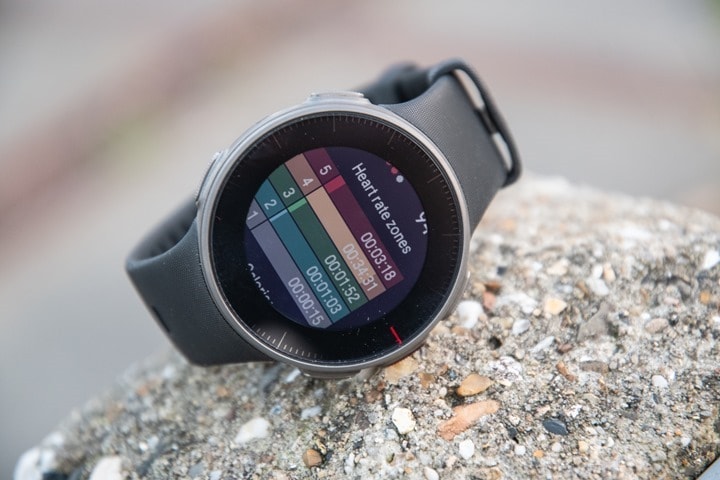
It’s been four months since Polar announced their new Vantage series of multisport watches. This series is currently comprised of two watches, the Vantage V and Vantage M. The V is the higher end multisport watch, meant to be a direct replacement of the nearly 5-year old V800. While the Vantage M focuses on the mid-range, and carves out a bit of a new segment for Polar, it is meant to compete with Suunto’s Spartan Trainer Wrist HR, as well as undercut Garmin a bit in the multisport game.
The two units are incredibly similar, both from a design and functionality standpoint. Despite that, this review will be focused on the Vantage V from a data collection standpoint. Said differently: I’ve just done the vast majority of the workouts with the Vantage V as opposed to the Vantage M. I will note however in this review when there are V-only features that don’t apply to the M. By and large most people are finding similar performance between the M and V units from an accuracy standpoint. Still, I’ll likely aim to do a Vantage M focused review later next month (which also coincides with travel to warmer locales where getting more openwater swim testing is viable again).
In any case, once I’m done with these reviews I’ll be shooting Polar back the small collection of media loaner Vantage V & M watches I have, and going out and getting my own through normal retail channels. Additionally, while I have data stretching as far back as early September, this review accounts for features in the watch as of the latest firmware update two days ago (and includes tests on that firmware as well).
What’s new:
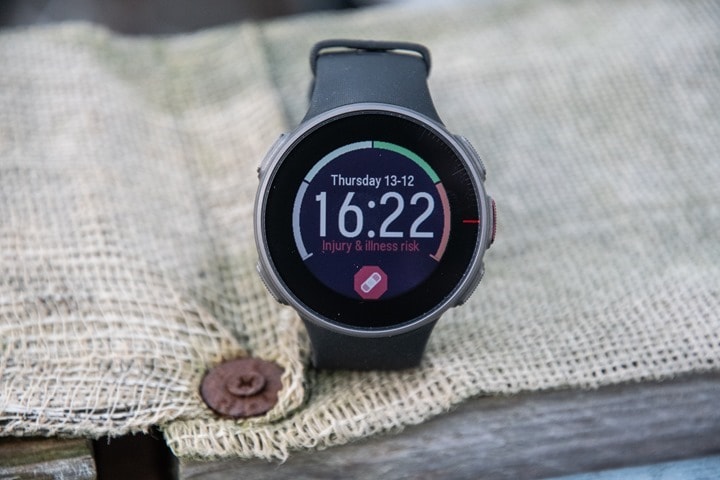
If you already know what’s new in the Vantage series, then you can likely skip this section. Whereas if you’re just walking up to the bar, then this is a good place to start understanding the unit.
I always like condensing everything down into a single bulleted section of newness. It helps you filter the cool stuff from the marketing fluff. So let’s dive straight away into it. Fear not, down below in the ‘overview’ section I go through things in more detail too. Note I’m looking at the ‘what’s new’ from the perspective primarily of the V800 (its predecessor). Also, this list is specifically for the Vantage V:
– Addition of optical heart rate sensor (both for workouts and 24×7 HR)
– Added electronic skin-contact sensor to validate a human is attached to watch
– Added color touchscreen, still retains buttons for all athletic functions
– Changed GPS chipset maker to that of Sony (same as what Suunto 9 uses)
– Changed max GPS-battery life to 40-hours 1-second recording with optical HR too
– Added running power from the wrist (no sensors required)
– Added new training load metrics (cardio/muscle/perceived stats)
– Added new ‘Recovery Pro’ metrics (daily recovery, training, and balance stats) – requires H6/H7 or H10 chest strap.
– Added both segmented real-time and post-processing of optical HR data to fix quirks (I’ll explain later)
– Made watch round, from rectangular shape previously
– Reduced weight of watch from 79g to 66g
The price is $499USD/EUR for the base models in orange, white, or black. It’s $549USD/EUR for the bundle with the Polar H10 HR chest strap.
When it comes to the Vantage M, here’s the core differences to the Vantage V:
– No barometric altimeter
– No native running power, as it lacks a barometric altimeter (still works with 3rd party running power like Stryd though)
– GPS 1-second battery down to 30 hours instead of 40 hours (but seriously, that’s still incredible)
– Added swappable straps using industry standard quick release bands (the Vantage V doesn’t have this)
– Not a touch-screen, just buttons only
– No Recovery Pro metrics (but does have other training load metrics)
– Weight is a mere 45g instead of 66g for Vantage V
That’s priced at $279USD/EUR. That’s priced well, though it’s also on-par price-wise with the Suunto Spartan Trainer Wrist HR. In talking with Polar – they were eyeing that watch as their main competitor in this space for the Vantage M.
But it’s not all bubbles and rainbows. The following features aren’t available on the Vantage V/M series (but were previously found on the predecessor Polar V800), but are slated to be re-added by the end of February 2019 through a handful of scheduled updates:
– Smartphone notifications (I.e. call/text notifications)
– Back to start navigation
– Route Guidance for waypoint navigation of downloaded routes (Vantage V only)
Meanwhile, the following features are slated to be added, but no timeline has been specified:
– Fitness test functionality
– Strava Segments
The following features also were on the V800, but aren’t on the Vantage series. There’s no specific/current plans to re-implement in the Vantage series:
– GoPro Action Cam Control
– Reduced GPS recording rate activities (I.e. beyond 40hrs of GPS time, the V800 also supported a reduced recording rate to 50hrs)
– No longer an option to use HR strap while swimming, only optical HR sensor [Older 5hz straps no longer supported]
Phew, got all that? Good, time to get the unit unboxed.
Unboxing:
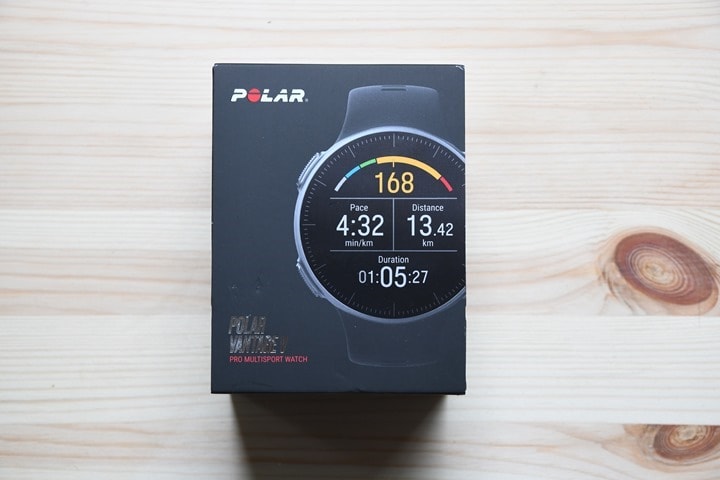
The Polar Vantage V comes in three colors: White, Black, or Orange. And within that, two editions: With or without the Polar H10 heart rate strap. While normally I’m not a huge fan of HR strap bundles, this is a rare scenario where given most of the Vantage V specific features depend on the H10 heart rate strap, you probably want that.
Once you slip out the protective sleeve, here’s what lies inside:

Below that you’ll find a small tray full of bits, including the charging cable, Polar H10 strap and transmitter pod, and the Vantage V watch itself.
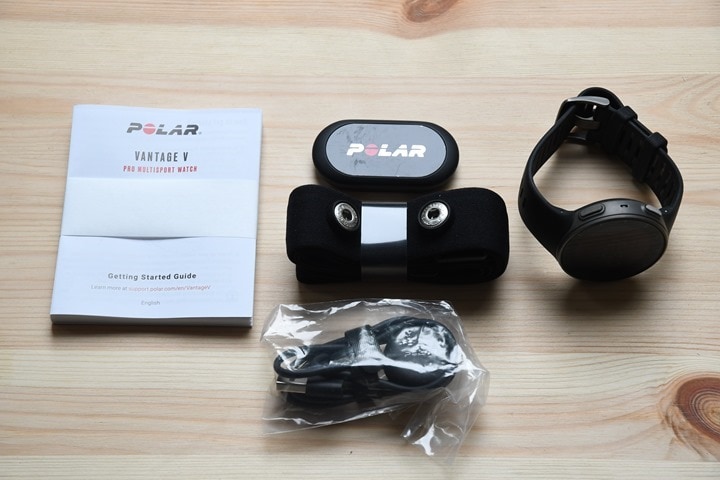
There’s a small getting started guide in there, though realistically you won’t need it after this post:

The Polar H10 chest strap is the same as sold separately. Of course the Vantage series watch has an optical HR sensor on the bottom of it, but the H10 is used for the orthostatic test, which helps with recovery details.
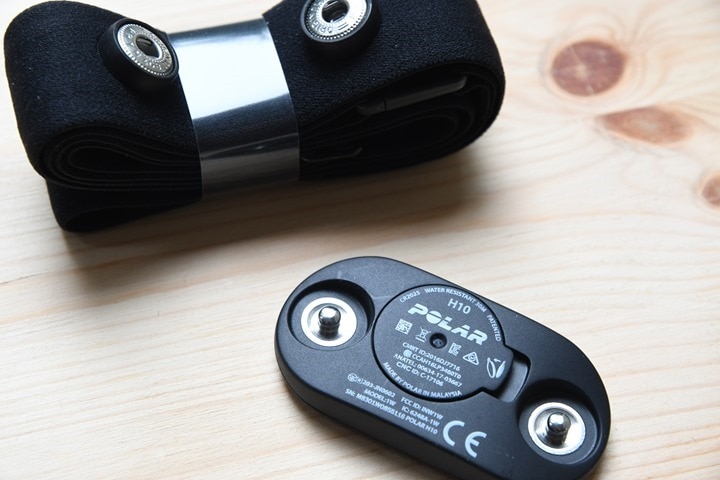
The charging cable is unique on the Vantage series compared to other Polar devices, and has four small charging connectors that magnetically attach.
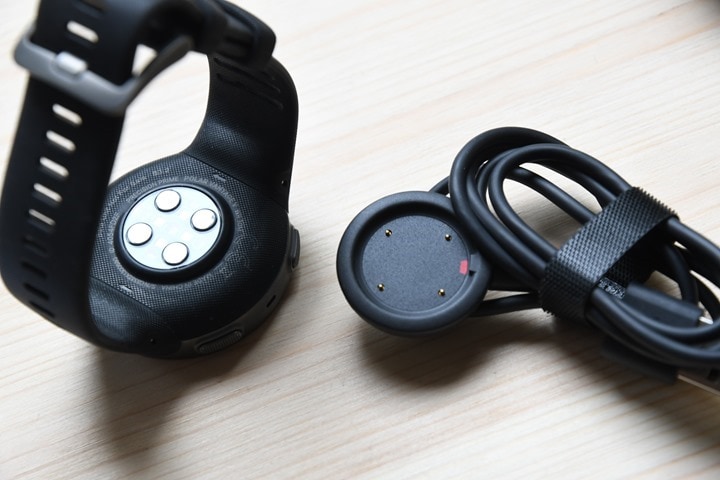
With the box contents out of the way, let’s dive straight into using it.
The Basics:
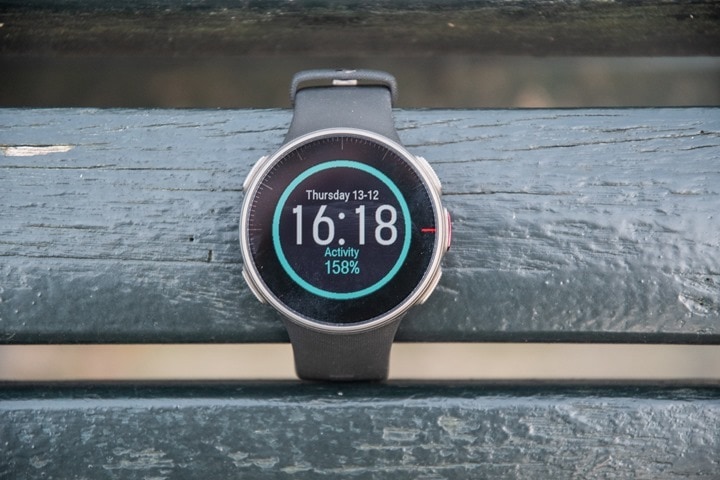
So let’s get right into things, starting with the touchscreen of the Vantage V. From a practical standpoint there’s no screen menu differences between the Vantage V and Vantage M. The only difference is you can’t control the Vantage M by the screen as it doesn’t have a touchscreen. Plus of course the smaller battery and lack of some metrics I’ll call out when I get to them. But otherwise, it all feels the same. The button layouts are the same on both watches, and the menu interactions using those are also the same.

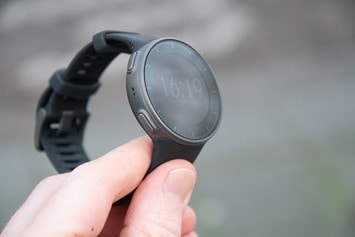
In general, I’ve preferred using the buttons over the touchscreen. It’s not a knock to the touchscreen per se, but it’s just faster for me to use buttons. You can swipe through menus using touchscreen or buttons, and to enter a menu using the touchscreen you’ll double-tap it. Responsiveness of either option is mostly so-so. It’s definitely not the fastest smartwatch I’ve tested. I wouldn’t say it’s the slowest, but it’s definitely slower than most of its competitors.
Since we chatted buttons we should at least talk hardware for a moment. The buttons have a pretty nice etching in them, as does the rest of the band of the Vantage V (below on the black unit). The Vantage M buttons (below on the white unit) are a bit more simplistic. But again, I really like the Vantage V button design.
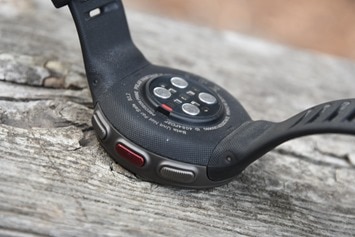
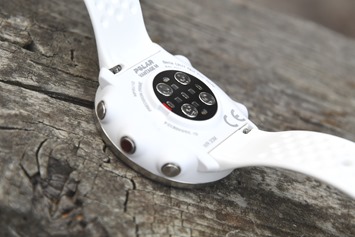
Meanwhile, as the Vantage M doesn’t have the swanky etching pattern, it does make up for it by having swappable straps. They use standard watch quick release straps. That’s oddly a feature the Vantage V lacks. Speaking of which, Polar is selling a few straps of their own, and I think the grey one actually looks pretty nice. The orange is very Strava/Zwift-esque.
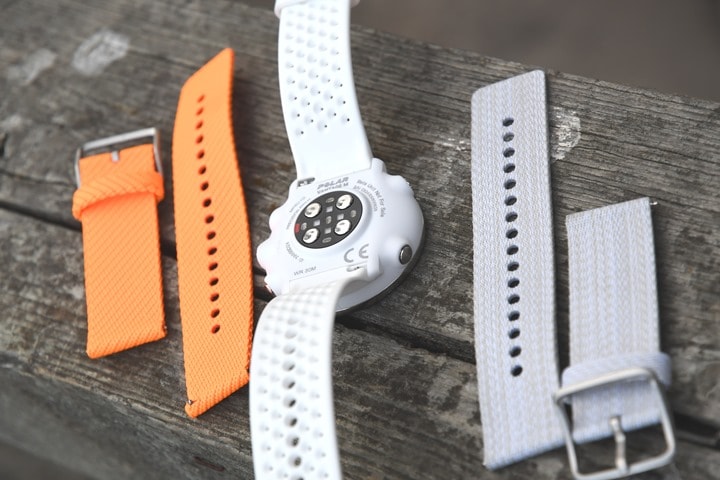
Back on the watch, you can swipe to access the different watch face dashboards. One for activity, another for training load, past workouts, and heart rate. In the case of the Vantage M, you use the up/down buttons to access these.
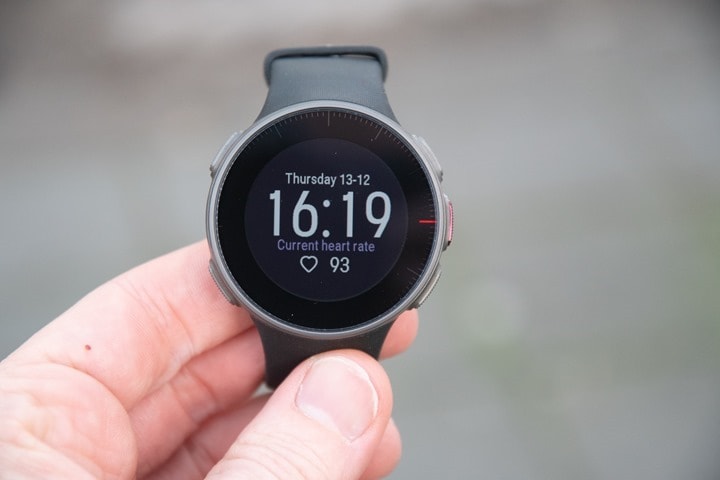
You can dive into each of these by pressing the button. For example, here’s the new training load status. This includes your cardio training load, but will also include your muscle load and perceived effort as well. You can also double-tap the screen instead of button pressing, if touchy-feeling screen stuff is your thing.
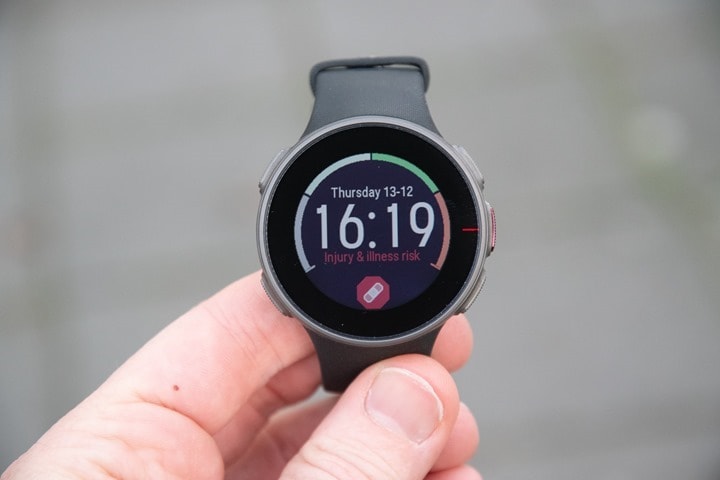
But I’ll dive more into the training load/recovery bits in later sections of this review. Let’s shift back to some more watch basics pieces first. Being an activity tracker, it’ll track most of the metrics you’d expect. That includes steps, % against daily goal, calories, and ‘active time’. Oddly however, you can’t see on the watch your distance walked per day or stairs – both common attributes found in inexpensive activity trackers.
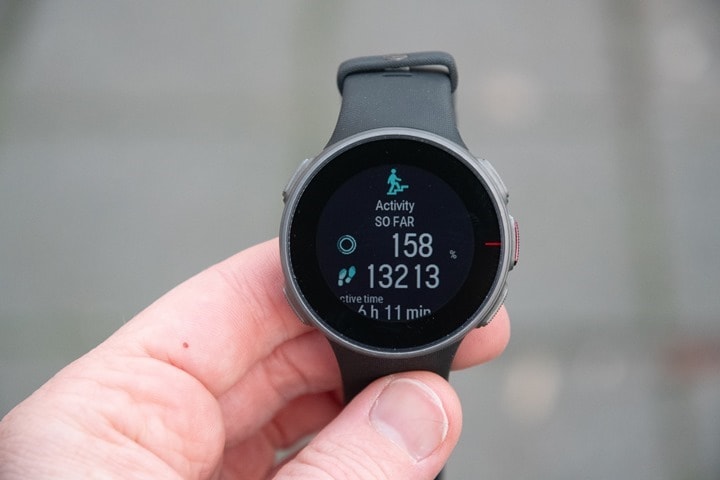
You can see the distance metrics over on Polar Flow – desktop or mobile apps. Though, I’m not terribly clear where that total miles walked metrics is coming from. Seems to be a minor math error there in terms of time. It doesn’t match my 30-day totals for distance, nor does the summary ‘active time’ match anything except maybe the last 24 hours. But those are minor things and most platforms seem to have quirks like this, it’s just that I happened to notice this one since it’s a long-ass way to walk.

You can see steps and such (distance inclusive) in the mobile app as well:
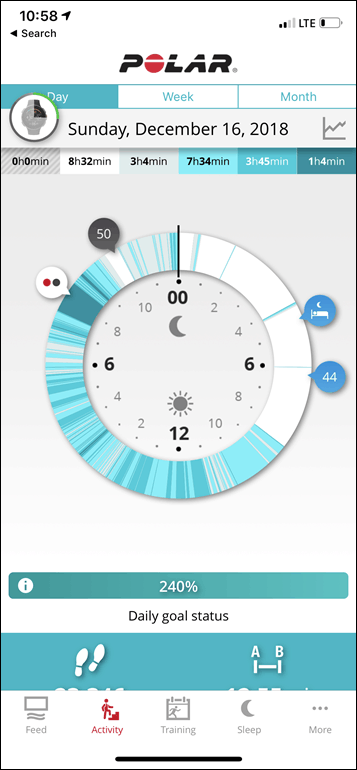
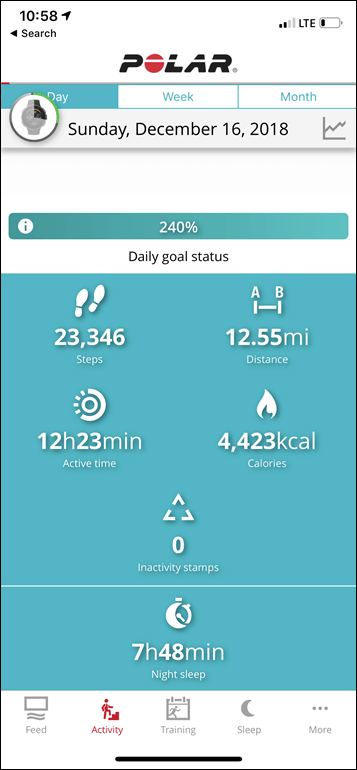
It’s here you can see your entire day from an activity standpoint, as well as any inactivity stamps. Though oddly, despite often sitting for hours straight with the watch on (as I am this very moment writing this), I’ve yet to get an inactivity stamp.
As part of this, you can enable continuous HR tracking. Polar leverages that massive block of optical HR sensors on the back of the unit to do that. Well, actually, they leverage a portion of them for continuous tracking, and the remainder for sport tracking:
And now’s a good time to talk about that beast of an optical HR sensor. I’d love to have sat in on the conversations on the design of this one. It’s got 9, yes 9 LED’s on it. It’s got four sets of dual red/green LED’s, followed by an extra green. And technically, I just lied to you. There’s also an orange LED in there too (absolute center pairing) – making that 10 LED’s. But the orange one isn’t used at this point and Polar isn’t seeing the benefit to enabling it based on their testing to date.
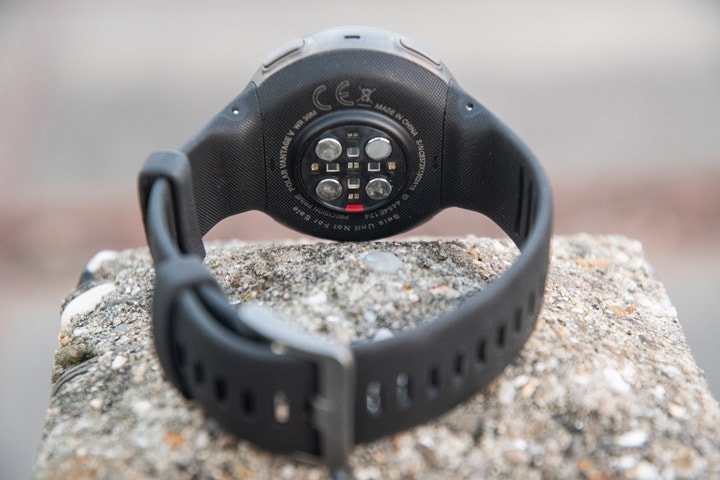
Note that you’ll need to enable the 24×7 continuous optical HR tracking in the menus, by default it’s off (to save battery life):

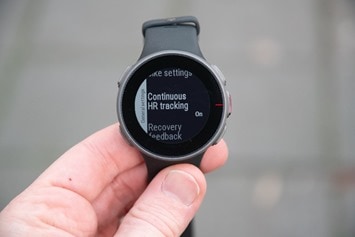
Once you’ve got it enabled you’ll see 24×7 HR data displayed in the app.
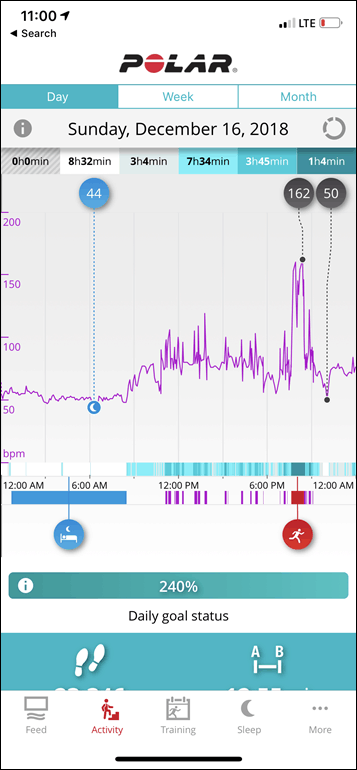
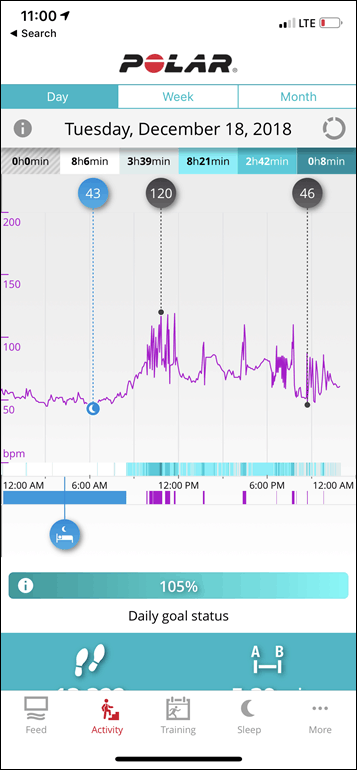
You can also take an instantaneous HR reading at any time within the watch via the main dashboard menus.
Next, we’ve got sleep. The unit will automatically track your sleep, inclusive of activity during sleep as well as the time you fell asleep and woke up. For the most part, it tends to get pretty close to spot-on for me. The below wake-up time was within about 5 minutes of when I actually woke up. And the falling asleep time was correct as well.

When it comes to your smartphone, as of present the Vantage V has a very limited relationship with it. Sorta like someone that’s only willing to go on a lunch-time coffee date. Today you can use Polar’s Flow smartphone app (Android/iOS) to sync with the Vantage series. You can also use it to perform firmware updates wirelessly via Bluetooth Smart. There is no known WiFi in the Vantage series.
One downside though is that there’s no continuous sync with the Vantage series, meaning that you have to manually initiate the sync of data to the app when you want to sync. That occurs by holding the lower left button down.
(Update: While this is supposed to be working, and does for most people apparently – it isn’t for me as of this morning, or even this afternoon. It never syncs unless I manually sync it. Latest firmware, software, iOS, etc…)
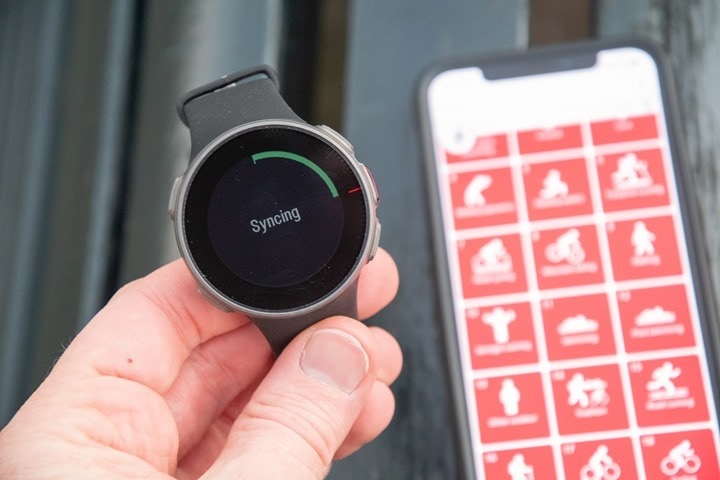
It probably sounds trivial, but it’s ultimately part of the ‘death by a thousand cuts’ issue here. These sorts of trivial features are common on every other mainstream (and non-mainstream watch). They just quietly sync in the background 24×7, ensuring your workouts are uploaded to Strava and the like before you even get in the front door.

As noted in the intro section, there are no smartphone notifications at this time. These are currently slated for the February timeframe. Obviously this is a pretty big deal – but there’s not much more I can say that drives home that point. Again, death by a thousand cuts. Oddly however, you do get a blank always present ‘No notifications’ dashboard page as a painful reminder of what once was.
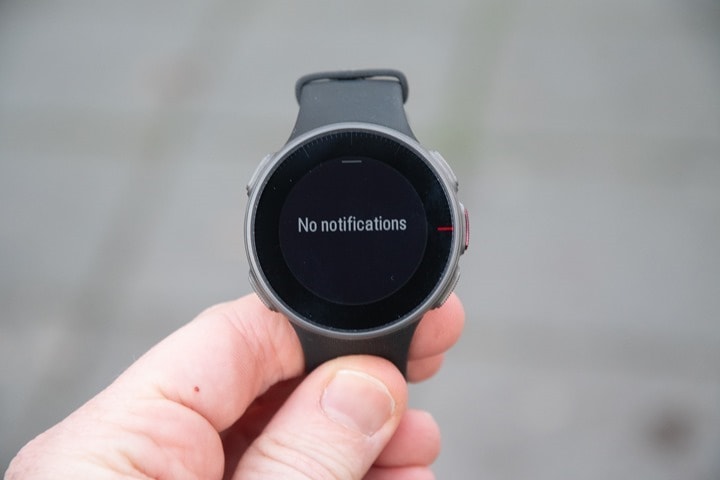
Finally, note that you can change a handful of settings on the watch itself. Generally speaking, companies tend to have you change settings on either the watch, a smartphone app, or via desktop site. In Polar’s case, it’s mostly via smartphone app and desktop site, with a handful of settings on the watch itself. Whereas inversely, in Garmin’s case it’s mostly on the watch itself and only a handful of settings via app. There’s no right answer (ok, there is – allowing both), so it’s really just a user preference thing.
On the watch side first you can tweak things like the time and whether certain tracking features are enabled:
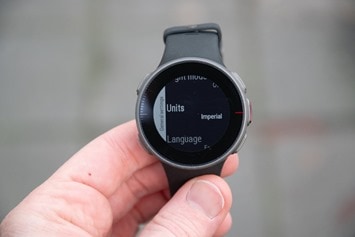

Whereas on the smartphone app you can tweak sport mode specific settings as well as general/profile settings:
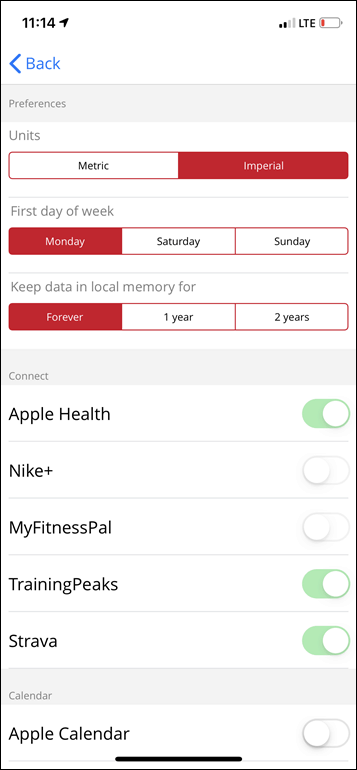
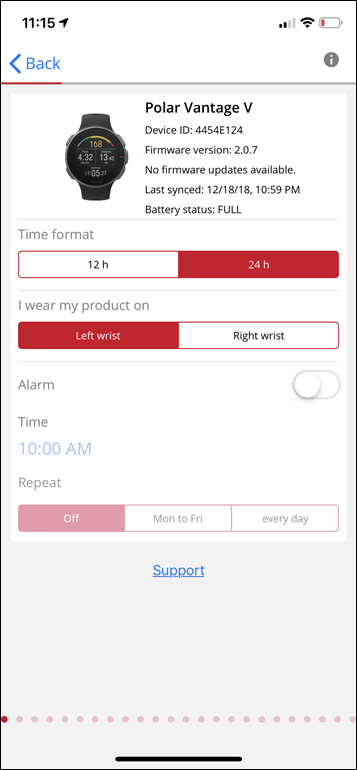
And finally, on the main Polar Flow site you can tweak these same settings as well. At this point we’ve clicked and tapped on all the things there is to tap on, without getting into the sport-specific modes. So now’s a good time to actually use the watch for what you bought it for: Sports tracking.
Sport Usage:

With all the basics set, we’ll dive right into the sport side of the house. The Polar Vantage series caries with it the massive pile of prebuilt sport modes. You can add up to 20 of these to your watch at any one point in time, each fully customizable. You’ll add these via the smartphone app or website, you can’t add/remove/configure them on the watch itself:
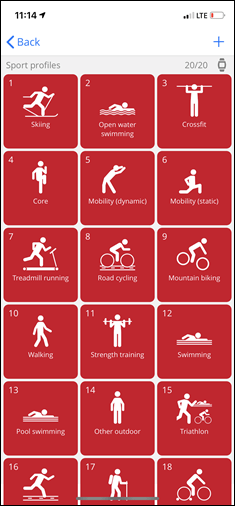
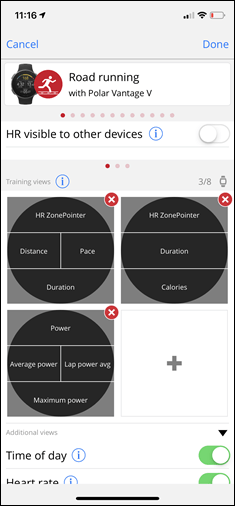

When it comes to data pages and data metrics, you’ve got customizable data pages (up to 8 pages) with each page supporting up to 4 metrics on it. Additionally, there are some ‘common’ data pages that you can enable or disable, such as time of day, pace, altitude, power, and the newly added via firmware countdown and interval timers..
From a data field standpoint, Polar is roughly in-line with Suunto in terms of available metrics to choose – though, has quite a few less metrics than Garmin does. Some of the disparity comes in the power realm (primarily cycling), where Garmin has popular fields like Normalized Power (NP), Intensity Factor (IF), and Training Stress Score (TSS). Polar lacks these, as well as the ability for 3rd party developers to create their own custom data fields via Garmin’s Connect IQ platform.
Inversely however, Polar has more flexibility for native running power fields, which Garmin somehow still lacks. This means that on Polar it’s easier to natively display and record running power data, especially tied to specific running power zones. That’s messy at best on Garmin (plus requires extra sensors and apps). But more on running power later.
Here’s a look at what a handful of data pages look like going from 1 field up to 4 fields:
At this point there is no method to customize GPS recording interval to save battery life. This means that all outdoor activities are recorded at a 1-second rate. This is both good and bad. On one hand Polar is blowing away the competition for baseline GPS 1-second recording durations (up to 40 hours). On the flip-side, the competition blows away Polar when it comes to ultra-type activities, where Suunto and Garmin can stretch up to a mind-bending 120 and 85 hours respectively. Polar hasn’t announced any changes/plans here for tweaking the software, though, since Polar and Suunto are using the same GPS chipset – Polar could certainly aim to implement similar functionality.
Speaking of sensor type things, if you’ve got Bluetooth Smart sensors, these are paired within the sensors menu in settings. You can store power meters (cycling or running), cycling cadence sensors, cycling speed sensors, running footpods, and external HR straps. Note that the Vantage V does not support using HR straps for swimming data, because unlike past Polar units, the Vantage series doesn’t support the analog frequencies that can transmit through water (digital variants like ANT+ & Bluetooth Smart can only transmit a few inches at most through water).
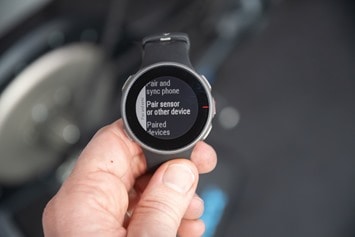
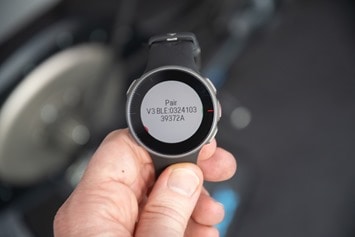
Note that at present the Vantage series only pairs with Bluetooth Smart sensors. Though, my understanding is that the hardware is dual-capable, should Polar wish to enable it via software. I actually don’t believe that horse is dead at this point (in fact, I’m very confident that horse isn’t dead). And I think them looking to add ANT+ support might win over some triathletes. Further, it might help to win over cyclists that want to capture their power data for Recovery Pro while on indoor trainers riding Zwift or TrainerRoad – and heck, even runners indoor on treadmills for running power via Stryd/RunScribe. Today that’s largely impossible due to the max concurrent connections most sport Bluetooth Smart sensors have (a single concurrent connection). Whereas all current ANT+ devices allow unlimited sensor connections.
When it comes to starting your workout you’ll long-hold the red button down, which then takes you to the sport selection menu. This is where you can pick one of your preconfigured sports. You can press the up/down buttons to iterate through them. If choosing an indoor sport (like treadmill running below), then you’ll see the HR acquisition circle above it, but not the GPS acquisition circle.

Once you’ve stopped iterating through the sports, it’ll start searching for your heart rate, and GPS signals. Assuming you’ve been wearing the watch already, the HR acquisition is pretty much instant. Whereas GPS can vary a bit. In my testing it’s quick most times, but I’ve had some longer duration waits as well (upwards of a minute or more). At present Polar is only doing GPS+GLONASS, and not doing any form of GALILEO satellite connectivity. The Sony chipset they are using is capable of doing so, should Sony enable that in firmware – Polar says they’ll in turn enable it on the unit down the road.
GPS will show as acquired once you’ve got the green circle around the satellite icon. Same goes for HR. If you’ve got extra sensors, then it’ll show lock of those extra sensors as well (such as a cycling power meter as seen below). Additionally, if you’re using an external HR strap instead of the optical HR sensor – you’ll see that here too.

With all that set, off to start your workout you go. The watch will display stats from the workout in real-time as you expect. This is pretty much the same as all previous Polar watches. Note that in workout mode the touchscreen is disabled, and you need to use the buttons (which isn’t a bad thing, to be honest).
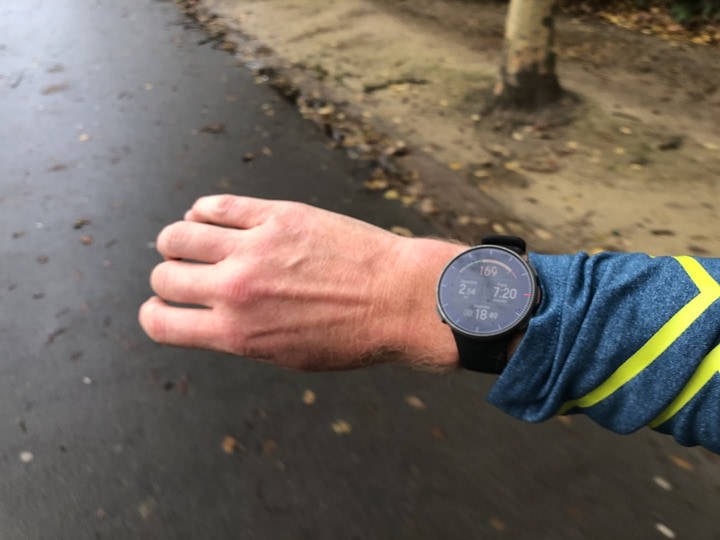
You can use either manual laps or auto laps (or both), by pressing the middle red button, which triggers a lap. Automatic laps can be setup via Polar Flow on a given sport mode basis. One area that Polar has an edge over Garmin on is that you can have both automatic laps and manual laps at the same time. They operate on different time-space continuums.
If you want to pause your workout, you’ll simply press the lower left button. That’s also where you can long-hold to end your workout and get workout summary details:
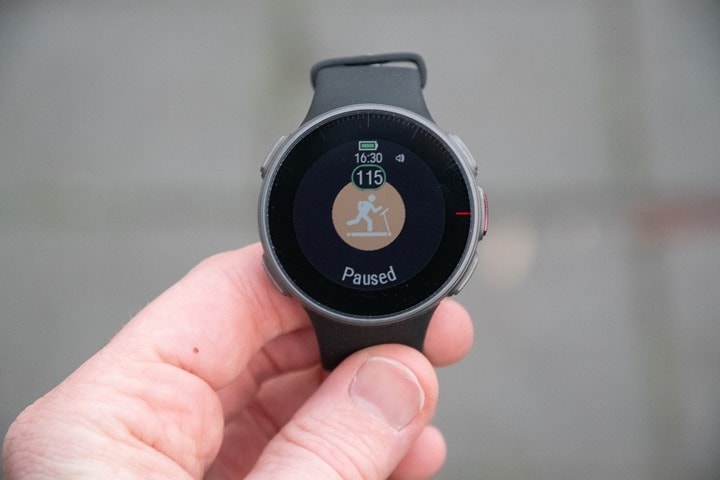
After the workout is completed you’ll get summary details about the workout, including time, calories, distance, power (if applicable), and so on. Recovery time is also displayed.
You can view these stats on Polar Flow as well, once you’ve manually synced via either long-pressing the lower left button from the main dashboards, or just attaching it to your computer via USB charger:
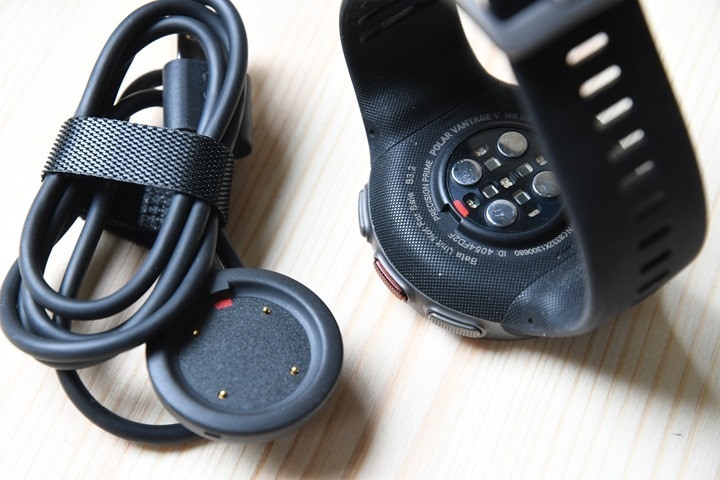
Here’s how they look on Polar Flow mobile:
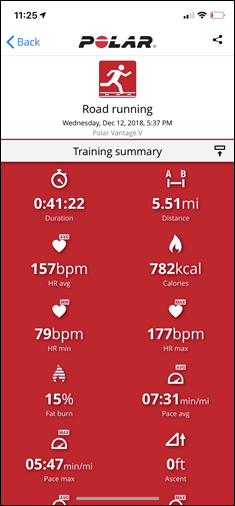
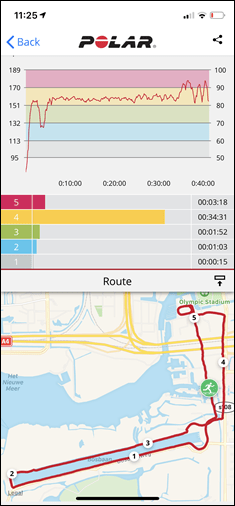
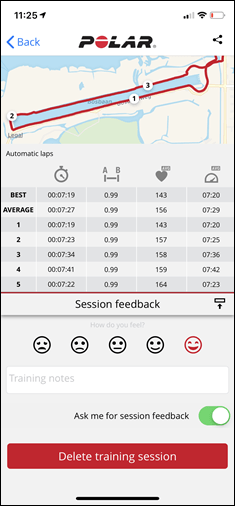
And here’s how it looks on the Polar Flow desktop website:

In terms of differences between various sports during the workout itself – there’s virtually no appreciable visual difference be it running or cycling, or doing core workouts or what-not. All of this is fairly standardized between the different modes – so what you see above is applicable no matter the mode.
What does differ though is some of the more advanced metrics, specifically coming from Recovery Pro (which is only on the Vantage V series), as well as running power
Recovery & Training Pro

In some ways, the entirety of Polar’s Vantage V product marketing effort rests on the Recovery Pro and running power features. Thus, I’m going to dive into these two in back to back sections.
To recap in a sentence or two, the Vantage V has their new Polar Recovery Pro stats, which aims to cover daily recovery, training, and balance stats. These stats do require the use of a Polar H10 heart rate strap though (the H6/H7 also are said to work), so, you’ll need to pick up that too.
Now, I’m going to dive into both here. But ultimately, if you want the super-short answer, it’s actually kinda simple. The power stats are no better or worse accuracy-wise than anyone else out there, they’re just different. And the Recovery Pro stats? Kinda the same. Both Garmin and Suunto have the exact same things, just branded differently. There’s some minor nuances to each company’s implementations, but at the end of the day you’re basically getting about the same stat-wise.
I’m sure I’ll get nasty-grams from both Polar and FirstBeat (who make Garmin and Suunto’s stats here), saying how each technology is better and more detailed than their Finnish brethren (both FirstBeat and Polar reside in Finland). But ultimately you’re basically getting the same basic recovery guidance telling you to either do more, or do less. Presentation and color-coding differs slightly, but not meaningfully, which in turn is also based on a blend of TRIMP and EPOC.)
Anyways, let’s first talk Polar Vantage V Recovery Pro. There’s two components to this: The semi-daily orthostatic test done with a Polar H10 HR strap, and then the workouts you’re doing that add cardio load (recorded ideally on the watch). You need to have both those pieces of the pie in order to get Recovery Pro data.
For fun, we’ll start with the Orthostatic test bit. That’s the bit that requires the H10 strap. And yes, it must actually be the Polar H10 chest strap, not just a generic Bluetooth Smart chest HR strap. The reason for that is Polar needs to know the quality of the data. While normally I’d call that marketing BS to make you spend on extra (expensive) Polar accessories, in this rare scenario there’s actually some basis for that.
In the past I’ve done tests that have shown just how different the HRV/RR data is from different HR straps. Now, rightly or wrongly, Polar has to base their algorithms on something. And so in this case, having a known good (or known stable), is key. Thus it is what it is.
In any case, once you’ve got your strap on you’ll press the lower left button to start the orthostatic test:
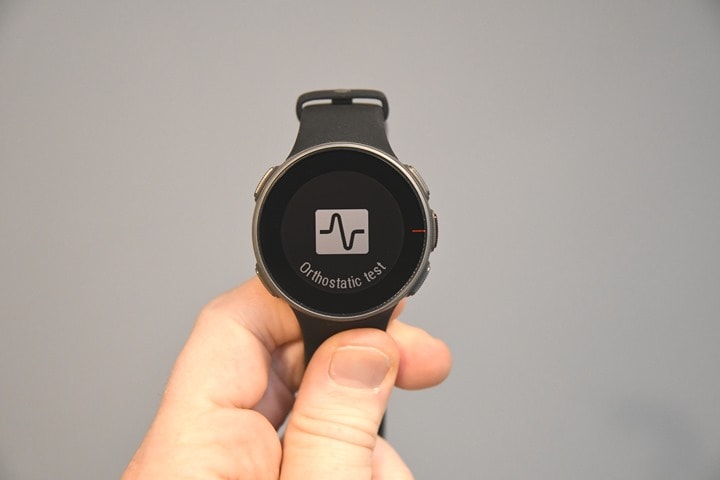
The test takes exactly 4 minutes. The first two minutes are spent lying down, and the remaining two minutes spend standing up. It’s as simple as that. No physical fitness test is required, just lay down and stand up. Simon says style.
Once it’s done it’ll give you some quick stats:
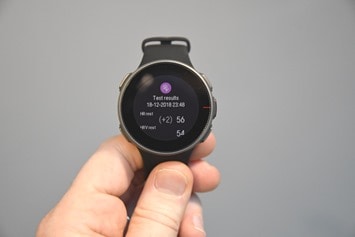
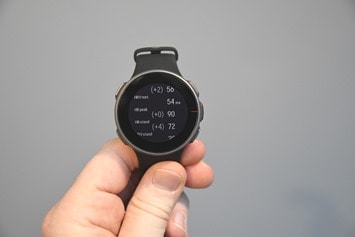
Then it’ll ask you three questions Monty Python style:
– How do your muscles feel?
– Are you more stressed than normal?
– How did your latest sleep feel?
Once it takes all that into account (including your actual workouts) it’ll give you some guidance on recovery. Interestingly this guidance is specific to that day, up until midnight. While writing this very section I decided to take an orthostatic test at 11:48PM to ensure I had my order of questions correct above.
Interestingly, it shifted my recovery state from a variant of ‘You’re broken’ to ‘Good to go’. However, while the Orthostatic test told me that immediately, the watch itself didn’t switch over until midnight. Not that it matters, but I found that a fun tidbit.
The test data is recorded both on the watch, but also to the app/site, where you can view it whenever you’d like – just like any other workout would be:
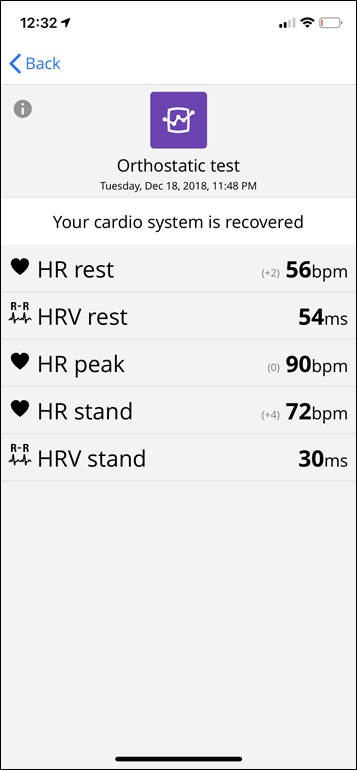
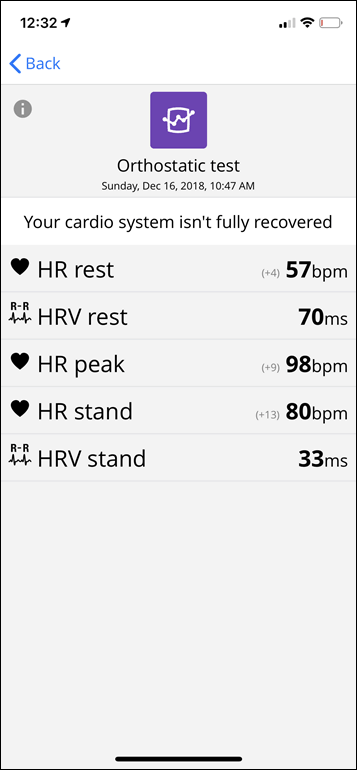
In any case, as for that guidance, here’s what it looks like on the watch itself in a few different forms. First, is the main dashboard page for Recovery Pro:

If you double-tap that, you’ll then get a more detailed chart of where you stand for both strain and tolerance.
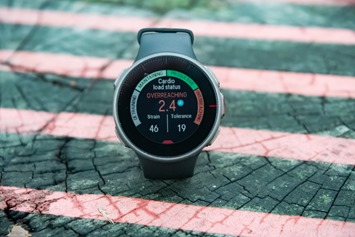

Strain shows your average daily load over the past 7 days, while Tolerance shows your average daily load over the last 28 days. I’ve never understood why physio focused companies create terms that are confusing AF (and this is hardly limited to Polar). Why not just label these ‘7-Day Load’ and ‘28-Day Load’? Seriously.
In any case, you’ll see these numbers fluctuate based on how much load you’re applying via captured workouts.
At the top of that widget is a color-coded gauge that gives guidance on where you are, within the following:
1) De-Training
2) Maintaining
3) Productive
4) Overreaching
Lately, I’ve been in the Overreaching category apparently. Probably because a fair chunk of November was quieter for me training-wise being sick. Whereas the last 3 or so weeks I’ve added a fair bit of volume. In some ways, this is exactly what this feature is built for – to keep me from getting injured. And the watch reminds me of that every day:


Now, there’s some odd quirks even within this though. For example, again, as I write this at 12:22AM (moving about 30 minutes from above), I’ve got a green thumbs up and text on the home page telling me to ‘Go for it’, despite being in the overreaching orange category (not the green category).
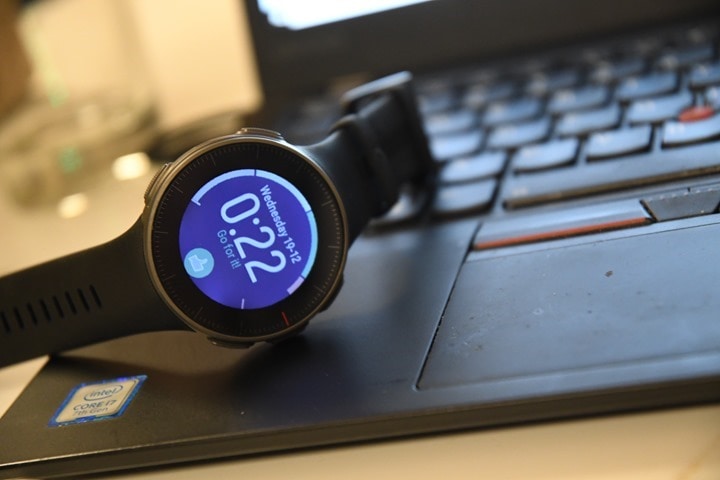
Perhaps those two aren’t exclusive to each other, but it’s just inconsistent. It’s OK, let’s set that aside.
Within the app you can dive into a bit more detail, though, it’s still kinda clumsy. For example, I can see lines showing my cardio load, but I can’t see actual numbers. It’s just unlabeled dots (even in horizontal graph view). You can tap on each dot and hold to see the numbers, but that’s clunky as heck. If there was at least a scale, that’d help alleviate things.


If I look at a given workout, I’ll see my cardio load and muscle load. These are two separate metrics. Cardio load is based on heart rate data, while muscle load is based on power data (running or cycling power meters). Note that you won’t get indoor running power data with Polar’s solution since it requires GPS to get data from.
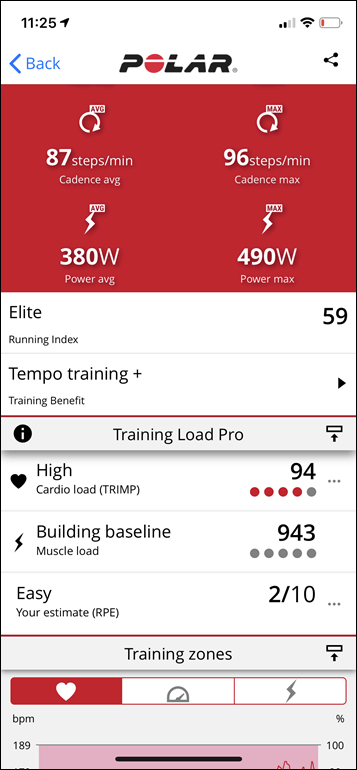
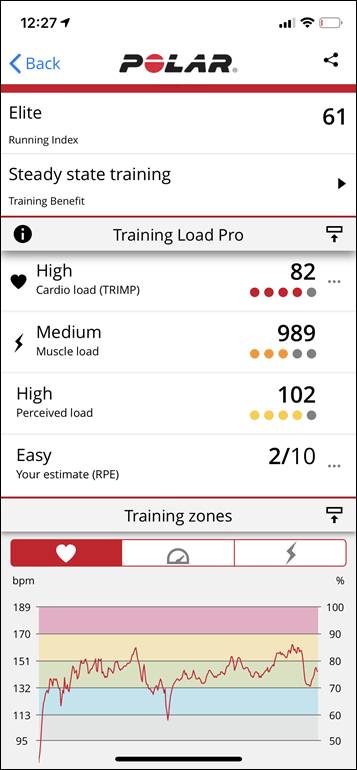
That means you won’t get muscle load for activities that don’t have that. For example – I went skiing this weekend. That meant I got cardio load (HR), but not muscle load.
There’s also an element of perceived load and estimated RPE – which comes from a rating that you do each time you complete a run on the app.
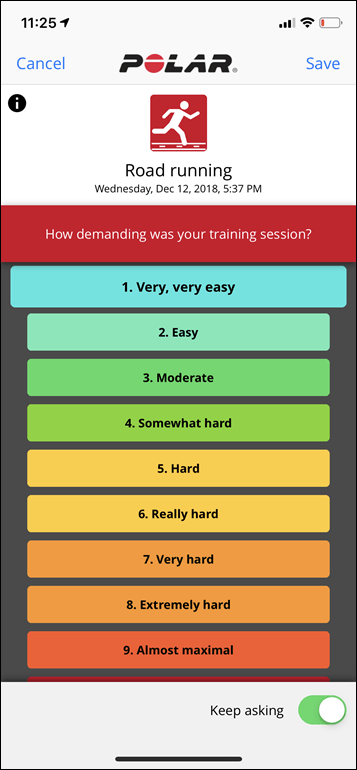

You can view the entirety of the training load data on the Polar Flow site as well:

And, here’s a prettier view of what things could look like if you had a super structured training schedule (a screenshot from Polar):
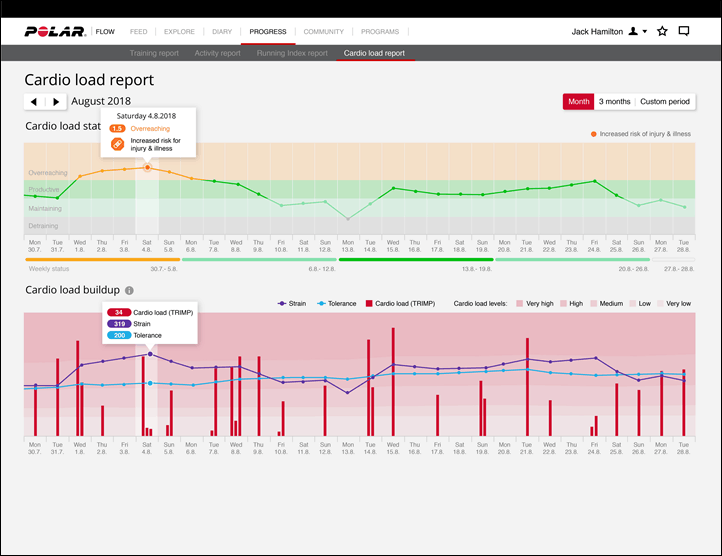
The above allows you to plot your cardio load, including the strain (7-day) and tolerance (28-day) metrics too. Again, this is effectively what other platforms have done for years – just with different terms.
And that’s sorta it when it comes to the new recovery metrics. Which might sound like I’m down on them – but I’m really not. I think they’re cool. But there’s virtually nothing unique about it. Everyone else is doing practically the same thing (and in some case, with more detail). I do think Polar is probably doing a better job of rationalizing some of it via the orthostatic test, though inversely, I think the other companies are doing a better job of making it easier to see and understand these stats.
So my wish-list to Polar is to simply make these numbers and metrics clearer in the app. It just requires too much menu digging and fumbling. If these stats are as big of a deal as Polar implies, then it should be it’s own tab for Vantage V owners at the button of the app. I tap it, and I get clear guidance on what I should and shouldn’t be doing.
Running Power:
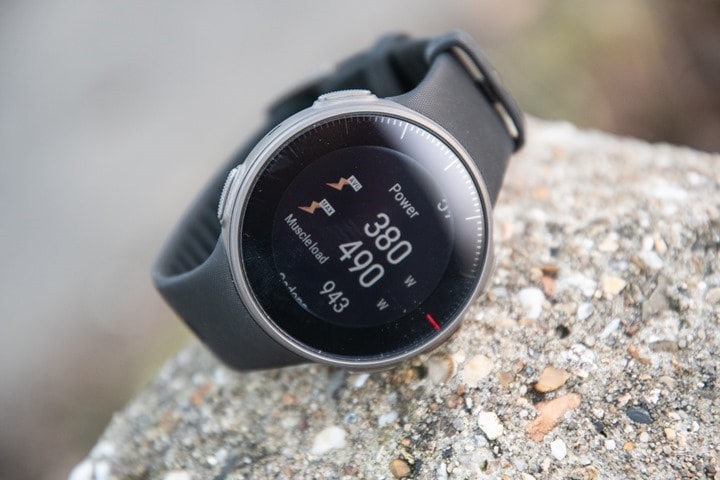
So…switching topics entirely: What about running power? Well, that’s an entirely different can of worms than Recovery Pro. Not a bad can though, just a different can.
To start, Polar has added running power directly into the wrist of the Vantage V product (the Vantage M lacks built-in running power, though supports 3rd party running power sensors). This marks the first time a wearable has done this without a 3rd party sensor (normally placed on the shoe, a chest strap, or a small pod on the waist).
Polar’s aim here was to make running power as easy to see and use as regular pace or heart rate is today. And as we temporarily set aside any questions on accuracy – Polar has absolutely succeeded here where everyone else has largely fumbled and failed. You simply go for a run, and you get running power data in real-time.
No extra sensors, no funky app configurations, no extraneous setup. It just works.
And somehow, as silly as this may sound: That’s huge.
Up until now you’ve had to spend a minimum of about $60 for running power (for a Garmin RD Pod or older HRM-RUN strap), or upwards of $200 for the Stryd or RunScribe sensors. Then you had to configure 3rd party apps to work (in the case of Garmin). With Suunto the watch side was cleaner, but you still needed that $200+ sensor. All of which ignored how messy the software side of the equation was (especially on Garmin).
From a running power standpoint, it’s pretty straightforward. You can either choose to select running power fields like any other metric. Alternatively you can just enable the one-touch running power page, which has them all consolidated:
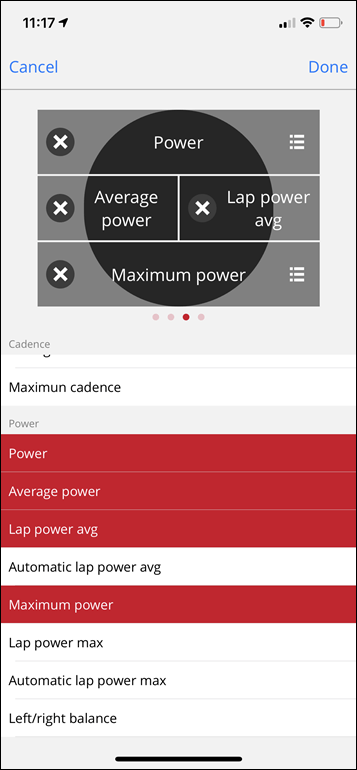

Data fields-wise the options are: Maximum power, average power, lap power, maximum lap power, automatic lap power average, and automatic lap power maximum
Out running, you’ll see running power just like cycling power:

I could drag this part of the section out a bunch – but honestly, that’s all there is to it. You see the power exactly as above, and that’s it.
The running power is displayed on what appears to be about a 10-second smoothed average. I based that on how long it took when I stopped running for the power to come down. It’s based on GPS pace, and not footpod or wrist-detection pace. This is notable because it does NOT work indoors (treadmill), nor should it work in a tunnel Polar tells me (I haven’t found a tunnel long enough to meaningfully test it). Assuming you’re outside though, this data will be written to your files just like a cycling power meter. And 3rd party apps can easily handle it as well. Here’s how it looks afterwards in your workout:

It’ll automatically show up in all outdoor running workouts – effectively making the Polar solution the ‘easy button’ of running power options.
When it comes to zones, you can define specific zones for running in a variety of ways, as well as enable Zone Lock for running – which gives you alerts when you stray outside that zone:

It’s this zone bit here that gives Polar an edge over Garmin’s running power solution. Garmin and Stryd off-load this into wonky app configurations that are just too cumbersome. Whereas Polar makes it clean and native.

The next question is whether or not running power is ‘accurate’. Well, first off, if anyone says that it’s accurate or inaccurate, just close that browser tab. Seriously, there’s no definition of that agreed upon by anyone out there with any meaningful scientific credentials. Instead, I’d argue that running power is more in the ‘is it plausible’ range, with a side of ‘is it at least consistent’. Even Polar noted in my discussions with them that there are many interpretations of how to measure running power and at which point it should be measured.
But certainly you’ll want to know how it compares on the same run to Stryd or Garmin Running Power? No problem, I’ve got you covered down below on that bit. Short version: It’s half-way in between them. Again, no idea whos right or wrong. But I did encourage Polar to be as open as Stryd, Garmin, and RunScribe have been in terms of publishing papers and studies that support their algorithm and thinking.
Like others, Polar has done a bunch of work on validation here. They too went to a force-plate treadmill to validate their power metrics, and the results they shared in a presentation seem promising. They also went out and did some pretty technical measuring of hills and did all the science math backwards to validate the numbers after test runners ran them. But again, so did Stryd – yet these two companies don’t match on the same run.

Now, don’t mistake me for thinking I’m down on Polar. Cause really, I’m definitely not. Instead, I’m just ‘less optimistic’ about running power in general. Mostly because we can’t seem to get any two companies to agree. As such, I think it’s tough for consumers (or myself) to know what to make of it. Or whether to trust it when training. Similarly, as much as we as humans want our cycling and running power numbers to equate, there’s no science that says they should. Just like our heart rate numbers for cycling and running certainly don’t match for the same perceived effort.
You only need a single run to illustrate comparing these between devices. Here’s a look at a run with Garmin Running Power (Teal) vs Stryd Running Power (Purple) vs Polar Running Power Red):

I’ve done some other one to one comparisons over the last few months and all have fared the same. Ultimately, what you see is tons of variability.
Each unit by itself might be repeatable, but none are comparable. How’s a coach with a dozen athletes (likely using different devices) supposed to compare these? Every company claims theirs is validated, and yet none are remotely comparable.
Polar and Garmin’s are theoretically a bit more limited because they’re tied to GPS pace instead of Stryd’s accelerometer pace. But practically speaking that doesn’t seem to matter above. Everyone is more or less equally as jumpy. And in some cases – Stryd isn’t jumpy enough. This run actually has some legit sprints where Stryd seems to entirely miss them. Just like inversely Polar and Garmin are too variable when they shouldn’t be.
So at this point my overall impression of Polar’s power functionality is kudos for making it easy, though, I’m not really sure anything in running power is truly worth it at this point.
GPS Accuracy:
There’s likely no topic that stirs as much discussion and passion as GPS accuracy. A watch could fall apart and give you dire electrical shocks while doing so, but if it shows you on the wrong side of the road? Oh hell no, bring on the fury of the internet!
GPS accuracy can be looked at in a number of different ways, but I prefer to look at it using a number of devices in real-world scenarios across a vast number of activities. I use 2-6 other devices at once, trying to get a clear picture of how a given set of devices handles conditions on a certain day. Conditions include everything from tree/building cover to weather.
Over the years I’ve continued to tweak my GPS testing methodology. For example, I try to not place two units next to each other on my wrists, as that can impact signal. If I do so, I’ll put a thin fabric spacer of about 1”/3cm between them (I didn’t do that on any of my Vantage V workouts). But often I’ll simply carry other units by the straps, or attach them to the shoulder straps of my hydration backpack. Plus, wearing multiple watches on the same wrist is well known to impact optical HR accuracy.
Next, as noted, I use just my daily training routes. Using a single route over and over again isn’t really indicative of real-world conditions, it’s just indicative of one trail. The workouts you see here are just my normal daily workouts.
I’ve had quite a bit of variety of terrain within the time period Vantage V testing. This has included runs in: Amsterdam, California, Nevada/Tahoe, Mexico, Canadian Rockies, Northern Finland in the Arctic Circle, and plenty more. Cities and countryside, mountains, trees, water, and open-air. It’s been everywhere!
First up is a run last week on the latest firmware that takes a loop around the forest and then a bit of southern Amsterdam at night. There’s also one loop of a local track for the heck of it. It’s a good blend of different obstructions for GPS. It’s compared against a Garmin FR935 and Apple Watch Series 4. Here’s the data files for that, if you want to dig in deeper.

At a high level, things look mostly passable. But that’s kinda the rough trend for the Vantage V. It’s not until you dig closer that stuff starts coming out of the woodwork. So, let’s zoom in and do that.
On one of the first slow looping turns, we see both the Vantage V and Garmin FR935 go off-track. Whereas somewhat astoundingly, the Apple Watch Series 4 actually managed to stay on-track. I say astoundingly because usually the Apple Watch goes astray on turns, but this one appeared slow enough that it managed to not fall off.

For the first 5K of this run, I ran along a rowing basin. The path was generally a few meters from the water. On the southern side, the Vantage V and Apple Watch stayed on the path, while the Garmin seemed to barely dip its toe into the water (just barely).
However, on the northern side, it was the Vantage V who was waist-deep in the water, while the Garmin and Apple units stayed on the path.

At first (above), that wandering doesn’t appear too serious, but as the run goes on, it gets further and further away. At this point I’m definitely out boating with the Vantage V, and no longer running. Note how there’s a slight offset that’s occurring where I put the red arrow. That’s where I dip inland a bit to go over a bridge, and the GPS tack mirrors that offset dip.

A bit later the tracks consolidate again as I go up a slight switchback. Well, except the Apple Watch – it displays its trademark ‘I ain’t got no switchback mode’ GPS tracks for sharp turns, by just cutting the corner.

A short bit later we can see both the turn in and out of the basin – and the Vantage V missed both of them (the Garmin slightly missed one, and the Apple Watch didn’t miss either).

But what about tunnels and bridges? All watches did reasonably well here actually. I’ve run and rode under this section a bit – and things are good. This bridge festival has about 150m of one giant bridge after enough – just enough time to maybe re-acquire GPS poorly, but it tracks nicely for the most part going through.

So to wrap up – here’s a loop of the track I did. You can see that all three GPS units fumbled over themselves as I crossed the street to the track. A reasonably tall building exists there, but hardly reason for this cluster.
Meanwhile, on the track itself all the units stayed almost entirely on the red part of the track. Minus the Apple Watch entering/exiting. It cut corners as always.

I’d note that I generally don’t use GPS data for track workouts. You’re on a track after all – the distance is known. I use my brain to simply count my intervals, and then I use the GPS data for my post-analytic stuffs. When I’m on a track I’m doing the math in my head for pacing. Anything afterwards is icing on top. So as long as the GPS tracks aren’t horrible here I’m good with it (since a running track is one of the most difficult things for GPS watches to deal with, due to the constant turning).
So overall for the above run it’s a mixed bag. The Vantage V certainly didn’t put down a beautiful V800 style GPS track, but it wasn’t horrible either. It was just so-so.
Let’s head up to what’s an easier route in Finland from this past weekend, a simple out and back and out again sorta route in a neighborhood. Some light tree cover. Here’s the data:

Again, at a high level it looks fine, but there are a few quirks – for example this section:

The Vantage V is off in the woods, I’m on a trail adjacent to the road. Normally I don’t like using just two watches on a GPS test, but after getting off the plane my Apple Watch’s battery was dead, so this was it for now.
But in this case it doesn’t matter – since I was running on a clear and marked path the entire time. Thus it’s easy to see where I went versus where the watch thought I went. The rest of the run was fine though – so not entirely sure why it went offset during those sections.

Next, another run in snowy Finland. This time a giant loop over some rolling tree’d terrain. I know, the colors make it a bit tough to see, don’t worry, it gets easier in a moment.

Things got off to a bit of a rough start, with the Vantage V offset from the running path and off in the trees:

In fact, it actually stayed that way for quite some time:

It wasn’t until I made a 90-degree turn that the track ‘re-aligned’:

It would mostly stay on track, but still it strayed here and there off into the woods:

Towards the end of the run, in the last kilometer or so, the Vantage V finally got back on track, and apparently kicked the FR935 off track. Go figure.

Again, this may be nit-picking, but that’s what GPS is about these days. Either you’re on track or not. At a high level it’s not bad, and most wouldn’t likely notice on Strava, but eventually these offsets do add up (either high or low).
I will note that while cycling I’ve had no issues at all with GPS accuracy. This is likely because I’m road cycling, so speeds are higher and GPS units tend to do better at higher speeds. This is true of virtually all GPS units I test:

I could dig into the above GPS track here, but honestly, it’s boring – it’s exactly where it should be.
Ultimately, it’s clear the Vantage V is no V800 in terms of GPS accuracy – which was generally regarded as one of the most accurate GPS units ever made (alongside the Suunto Ambit 3 series). Both companies have shifted GPS chipsets to more power efficient models, and with that, lost the accuracy edge they once had.
It’s clear that accuracy is getting better on the Sony chipset over time. There’s no question accuracy has improved in the last three months in using the Vantage V (and in the case of Suunto, their Suunto 9 on the same chipset).
But neither watch is any better than Garmin here (who uses MediaTek these days). In most cases we see the latest FR935/Fenix 5 Plus GPS units outperforming the Sony GPS chipsets in Polar/Suunto just slightly. Not every time of course as noted above, but enough times that it’s notable. Is it enough to matter to most though? Probably not.
(Note: All of the charts in these accuracy portions were created using the DCR Analyzer tool. It allows you to compare power meters/trainers, heart rate, cadence, speed/pace, GPS tracks and plenty more. You can use it as well for your own gadget comparisons, more details here.)
Heart Rate Accuracy:
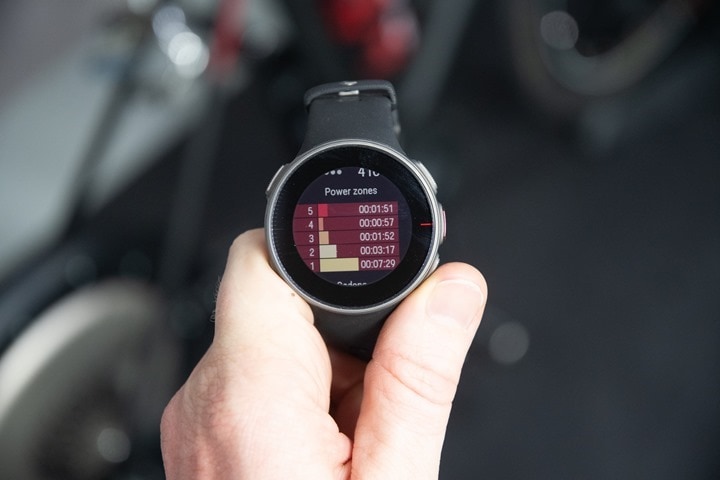
Before we move on to the test results, note that optical HR sensor accuracy is rather varied from individual to individual. Aspects such as skin color, hair density, and position can impact accuracy. Position, and how the band is worn, are *the most important* pieces. A unit with an optical HR sensor should be snug. It doesn’t need to leave marks, but you shouldn’t be able to slide a finger under the band (at least during workouts). You can wear it a tiny bit looser the rest of the day.
Ok, so in my testing, I simply use the watch throughout my normal workouts. Those workouts include a wide variety of intensities and conditions, making them great for accuracy testing. I’ve got steady runs, interval workouts on both bike and running, as well as tempo runs and rides – and cold weather runs in the Arctic Circle too (it’s winter, after all).
For each test, I’m wearing additional devices, usually 3-4 in total, which capture data from other sensors. Typically I’d wear a chest strap (usually the HRM-TRI, Polar H10, or Wahoo TICKR), as well as another optical HR sensor watch on the other wrist (and sometimes also either the Scosche Rhythm 24, and Scosche Rhythm+). Note that the numbers you see in the upper right corner are *not* the averages, but rather just the exact point my mouse is sitting over. Note all this data is analyzed using the DCR Analyzer, details here.
Note that while I’ve been using the Polar Vantage V since September, I’m mostly going to use recent data in this review – since that’s the firmware that it’s currently on and the production firmware that real world people are using.
First up is a night run from last week. This is compared against a Wahoo TICKR heart rate strap and the Apple Watch Series 4 HR. Here’s the data set.

This run displayed all of the HR stereotypes in one tidy bundle. First, Apple takes the usual 45-60 seconds until it locks HR. This is because it doesn’t start trying to figure out your HR until you press record/start. Whereas other watches lock that prior to pressing record.
Next, the chest strap of the TICKR (on this cool and dry night) takes a while until it’s happy too (despite me applying spit to it). And finally, the Polar Vantage actually nails the start for the first 2 minutes or so, and then goes off the rails randomly for a bit.
By the 5 minute marker, all of the units are happy though and in agreement. It was just a bit of a fight to get there.

Towards the end of that yellow line I decide to increase the pace as I head around the track. This wasn’t a sprint, but rather just a nice solid and even push of the pace, up to roughly a 6:00/mile pace (3:45/km).
After that, I did a couple of sprints on the way back home:

And it’s not horrible, but you can see the slight inaccuracies and delays there. At one point towards the end as I’m on the track pressing harder, the Vantage V HR drops by 10bpm randomly for a few seconds. We see it display a much lower recovery HR than the other two units.
Perhaps that’s correct – but I really doubt it. It’s unlikely my HR recovered that fast and that low while I was still running. And we see as I start the sprints that it’s delayed on catching up to the other two.
So let’s look at another run, this time where I did 0.10mi/.16km sprints roughly every mile or so.

These were reasonably hard efforts, sorta fartlek style.
As you can see though, the Vantage V was delayed on all of these in comparison to the Wahoo TICKR chest strap and Apple Watch Series 4. In some cases, it went under the previously established steady-state baseline:

In general though, what you see is the delay in intervals for the HR to pick up – it seems to be roughly about 6-8 seconds behind, give or take.

Interestingly though, it does seem like Polar’s algorithms for HR recovery are faster though, so it catches that quicker when I slow back down.
One interesting tidbit that Polar is doing behind the scenes is retroactively correcting the optical HR readings, within 60-second blocks. So while you’re working out you might see a given incorrect reading (such as 205bpm), but then 60 seconds later the watch will actually correct that in the file in the watch after it does some post-processing.
Polar is looking at patterns more broadly than just typical instant HR validation to correct for errors, and is instead retroactively looking at bits where it got things wrong and fixing them before you ever even upload the file.
This vaguely sounds like what Apple is also rumored to be doing on the Apple Watch, but it’s supposedly done in real-time there (I’ve yet to get confirmation of that directly from Apple).
In any case – all of the data you see here would be from Polar’s corrected variant, and not trying to read the display every second and somehow orally record that. What I notice though while running is roughly what these graphs show: Most times it’s close, but sometimes it’s off.
Ok, another few quick examples. Here’s a run from this past weekend in cold and dark Finland (home of Polar!). As you can see, the Scosche 24 (in purple) most closely ramps up the start of my run properly. The Polar H10 chest strap (ironically paired to a Garmin FR935) is lose for a while until I applied yet more moisture to it and made it happy. While the Polar Vantage V gets off to a slow start, it does seem to agree with everyone else around the 6-minute marker. Here’s the data:

Still, you’ll notice around the 9 to 14-minute markers the Vantage V seems to lose the plot multiple times for no apparent reason. This is again on the absolute latest firmware, and in relatively easy state-state running. The watch is even under my long-sleeve shirt, making it ‘warmer’ and this better for optical HR. It’s dark out (because: Finland in winter) – again, making it easier for the optical HR sensor. No luck until about the half-way point of the short and easy run, when it’s finally happy.
Here’s another run we did in Finland, this one a bit longer. This time there’s a Scosche 24 paired with that FR935, and an Apple Watch Series 4:

Clearly, the first 8 minutes are a crap-show, but the winner on this nice and steady build is obvious: The Apple Watch. The Scosche was off lost in space, and the Polar was well under the expected heart rate in the 120bpm range.
The remainder of the run was pretty good. There’s a few quibbles from the Polar, but nothing I’m too pressed about.
So what about riding? Ok, let’s start outdoors:

Well then. The Vantage V is in green, whereas the Scosche 24 and TICKR X are in red and purple.
Perhaps we’d better move indoors.

Generally speaking, I see optical HR sensors do poorly outside riding (though, not that poorly), and do fairly well indoors. There’s no vibrations indoors to deal with.
For this ride, it’s mostly steady-state and the Vantage V handles that well enough. I do however knock out three sprints, and it completely misses the first sprint until I’m already done. The 2nd and 3rd sprints aren’t too bad, it’s a bit delayed, but not horribly so:

Hmm, so why was it so bad on that outside ride? I’m not sure.
But I went digging through more outside ride files. Since so much of my riding is indoors right now being winter and trainer season I had to go back to the last few days of October when I wore the Vantage V on an outside ride (I’ve done other rides since then outside, just not with said watch). Here’s one I found (actually on final firmware/hardware btw):

That’s actually not bad. The Vantage V has a couple of minor slip ups, but all-in-all it’s actually pretty good for optical HR – almost as good as the Apple Watch’s optical HR sensor and the chest strap on that ride (easily surpassing Garmin’s recent optical HR sensors).
I’m going to guess that there was just some weird oddity on that earlier ride. Going back further into October and September, I never had something that odd before.
Note that I don’t have any good swim HR data that’s worthy of review here. Meaning that while I do have swim HR data – I frankly don’t know who is right or wrong in them. They’re about 20bpm apart and with swimming I don’t know my swimming HR zones that well to be able to figure out which one is correct. I’ve gotta do more work there on that piece – likely in conjunction with the Polar Vantage M review.
So where are things overall with the Polar Vantage optical HR sensor?
I’m mixed. I don’t think it’s the mother of all optical HR sensors that Polar and others wanted it to be in terms of accuracy. At least not for everything. I think some of their processing algorithms need work, as it’s latent in most sprints (more so than most optical HR sensors). But in cases like cycling it does appear that the work is paying off, that’s one of the better optical HR tracks out there.
Like most new optical HR sensors it does seem to take companies a while (usually 6-12 months) to work out kinks and one-off type conditions. Hopefully we’ll see things quickly iterate on this front.
Product Comparison:
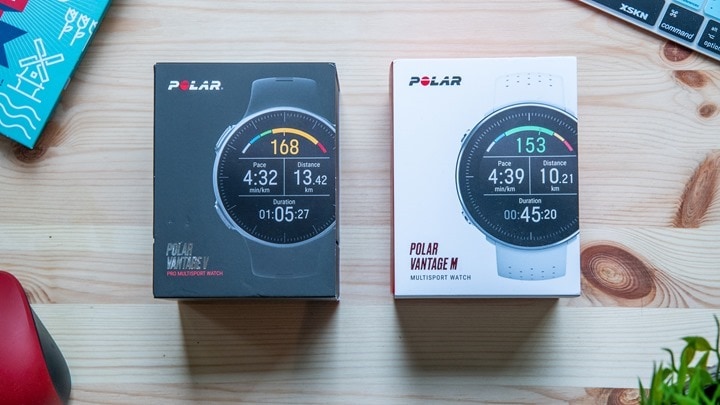
I’ve added both the Polar Vantage V and Polar Vantage M into the product comparison tool, so you can mix and match and create your own product comparison charts as you see fit. The tool allows you to compare against other products I’ve reviewed or had hands-on time with.
For the purpose of the below charts, I’ve compared the Vantage V and M against the identically priced Garmin Forerunner 935, as well as and the Suunto 9 Baro. You can make your own charts though if you want against the Fenix 5/5 Plus series or anything else in the database.
| Function/Feature | Garmin Forerunner 935 | Polar Vantage M | Polar Vantage V | Suunto 9 Baro |
|---|
| Copyright DC Rainmaker - Updated May 28th, 2022 @ 9:59 am New Window |
| Price | $499 | $279 | $499 | $599 (non-baro is $499) |
| Product Announcement Date | Mar 29th, 2017 | Sept 13th, 2018 | Sept 13th, 2018 | June 5th, 2018 |
| Actual Availability/Shipping Date | Mar 29th, 2017 | November 2018 | Late October 2018 | June 26th, 2018 |
| GPS Recording Functionality | Yes | Yes | Yes | Yes |
| Data Transfer | USB/Bluetooth Smart/WiFi | USB, BLUETOOTH SMART | USB, BLUETOOTH SMART | USB & Bluetooth Smart |
| Waterproofing | Yes - 50m | Yes - 30m | Yes - 30m | Yes - 100m |
| Battery Life (GPS) | Up to 24hrs in GPS-on, up to 50hrs in UltraTrac GPS | Up to 30 hours | Up to 40 hours | Up to 120 Hours |
| Recording Interval | 1S or Smart | 1s | 1s | Variable |
| Alerts | Vibrate/Sound/Visual | Vibrate/Visual | Vibrate/Sound/Visual | Sound/Visual/Vibrate |
| Backlight Greatness | Great | Great | Great | Great |
| Ability to download custom apps to unit/device | Yes | No | No | No |
| Acts as daily activity monitor (steps, etc...) | Yes | Yes | Yes | Yes |
Music | Garmin Forerunner 935 | Polar Vantage M | Polar Vantage V | Suunto 9 Baro | | Can control phone music | YEs | No | No | No |
| Has music storage and playback | No | No | No | No |
| Streaming Services | No | No | No | No |
Payments | Garmin Forerunner 935 | Polar Vantage M | Polar Vantage V | Suunto 9 Baro | | Contactless-NFC Payments | No | No | No | No |
Connectivity | Garmin Forerunner 935 | Polar Vantage M | Polar Vantage V | Suunto 9 Baro | | Bluetooth Smart to Phone Uploading | YEs | Yes | Yes | Yes |
| Phone Notifications to unit (i.e. texts/calls/etc...) | Yes | Feb 2019 | Feb 2019 | Yes |
| Live Tracking (streaming location to website) | Yes | No | No | No |
| Group tracking | Yes | No | No | No |
| Emergency/SOS Message Notification (from watch to contacts) | No | No | No | No |
| Built-in cellular chip (no phone required) | No | No | No | No |
Cycling | Garmin Forerunner 935 | Polar Vantage M | Polar Vantage V | Suunto 9 Baro | | Designed for cycling | Yes | Yes | Yes | Yes |
| Power Meter Capable | YEs | Yes | Yes | Yes |
| Power Meter Configuration/Calibration Options | Yes | Yes | Yes | Yes |
| Power Meter TSS/NP/IF | YEs | No | No | No |
| Speed/Cadence Sensor Capable | YEs | Yes | Yes | Yes |
| Strava segments live on device | Yes | Future Update (Date TBD) | TBD Future Update | No |
| Crash detection | No | No | No | No |
Running | Garmin Forerunner 935 | Polar Vantage M | Polar Vantage V | Suunto 9 Baro | | Designed for running | Yes | Yes | Yes | Yes |
| Footpod Capable (For treadmills) | YEs | Yes | Yes | Yes |
| Running Dynamics (vertical oscillation, ground contact time, etc...) | WITH RD POD, HRM-TRI OR HRM-RUN (NOT VIA OPTICAL HR) | No | No | No |
| Running Power | WITH RD POD, HRM-TRI OR HRM-RUN (or 3rd party Stryd/RunScribe) | Yes with 3rd party devices (not built-in like Vantage V) | yes (built-in) | With extra sensor |
| VO2Max Estimation | Yes | Yes | Yes | Yes |
| Race Predictor | Yes | No | No | No |
| Recovery Advisor | YEs | No | Yes | Yes |
| Run/Walk Mode | Yes | No | No | No |
| Track Recognition Mode | | | | No |
Swimming | Garmin Forerunner 935 | Polar Vantage M | Polar Vantage V | Suunto 9 Baro | | Designed for swimming | YEs | Yes | Yes | Yes |
| Openwater swimming mode | Yes | Yes | Yes | Yes |
| Lap/Indoor Distance Tracking | Yes | Yes | Yes | Yes |
| Record HR underwater | WITH HRM-TRI/HRM-SWIM (Not with optical HR) | Yes | Yes | Yes |
| Openwater Metrics (Stroke/etc.) | Yes | Yes | Yes | Yes |
| Indoor Metrics (Stroke/etc.) | Yes | Yes | Yes | Yes |
| Indoor Drill Mode | Yes | No | No | No |
| Indoor auto-pause feature | No (it'll show rest time afterwards though) | Yes | Yes | No |
| Change pool size | YEs | Yes | Yes | Yes |
| Indoor Min/Max Pool Lengths | 14M/15Y TO 150Y/M | 20M/Y to 250 m/y | 20M/Y to 250 m/y | 15m/y to 1,200m/y |
| Ability to customize data fields | Yes | Yes | Yes | yes |
| Captures per length data - indoors | Yes | Yes | Yes | Yes |
| Indoor Alerts | Yes | N/A | N/A | No |
Triathlon | Garmin Forerunner 935 | Polar Vantage M | Polar Vantage V | Suunto 9 Baro | | Designed for triathlon | Yes | Yes | Yes | Yes |
| Multisport mode | Yes | Yes | Yes | Yes |
Workouts | Garmin Forerunner 935 | Polar Vantage M | Polar Vantage V | Suunto 9 Baro | | Create/Follow custom workouts | Yes | Yes | Yes | No |
| On-unit interval Feature | YEs | No | No | Yes |
| Training Calendar Functionality | Yes | No | Yes | Yes |
Functions | Garmin Forerunner 935 | Polar Vantage M | Polar Vantage V | Suunto 9 Baro | | Auto Start/Stop | YEs | | | No |
| Virtual Partner Feature | YEs | No (but can give out of zone alerts) | No (but can give out of zone alerts) | No |
| Virtual Racer Feature | Yes | No | No | No |
| Records PR's - Personal Records (diff than history) | YEs | No | No | No |
| Tidal Tables (Tide Information) | No | No | No | No |
| Weather Display (live data) | Yes | No | No | No |
Navigate | Garmin Forerunner 935 | Polar Vantage M | Polar Vantage V | Suunto 9 Baro | | Follow GPS Track (Courses/Waypoints) | Yes | No | No | Yes |
| Markers/Waypoint Direction | YEs | No | No | Yes |
| Routable/Visual Maps (like car GPS) | No | No | No | No |
| Back to start | Yes | Feb 2019 | Feb 2019 | Yes |
| Impromptu Round Trip Route Creation | No | No | No | No |
| Download courses/routes from phone to unit | Yes | No | No | Yes |
Sensors | Garmin Forerunner 935 | Polar Vantage M | Polar Vantage V | Suunto 9 Baro | | Altimeter Type | Barometric | GPS | Barometric | Barometric |
| Compass Type | Magnetic | N/A | N/A | Magnetic |
| Optical Heart Rate Sensor internally | Yes | Yes | Yes | Yes |
| SpO2 (aka Pulse Oximetry) | No | No | No | No |
| Heart Rate Strap Compatible | Yes | Yes | Yes | Yes |
| ANT+ Heart Rate Strap Capable | Yes | No | No | No |
| ANT+ Speed/Cadence Capable | Yes | No | No | No |
| ANT+ Footpod Capable | Yes | No | No | No |
| ANT+ Power Meter Capable | Yes | No | No | No |
| ANT+ Lighting Control | Yes | No | No | No |
| ANT+ Bike Radar Integration | Yes | No | No | No |
| ANT+ Trainer Control (FE-C) | No | No | No | No |
| ANT+ Remote Control | No (can control VIRB though) | No | No | No |
| ANT+ eBike Compatibility | No | No | No | No |
| ANT+ Gear Shifting (i.e. SRAM ETAP) | YEs | No | No | No |
| Shimano Di2 Shifting | YEs | No | No | No |
| Bluetooth Smart HR Strap Capable | Yes | Yes | Yes | Yes |
| Bluetooth Smart Speed/Cadence Capable | YEs | Yes | Yes | YEs |
| Bluetooth Smart Footpod Capable | YEs | Yes | Yes | Yes |
| Bluetooth Smart Power Meter Capable | YEs | Yes | Yes | Yes |
| Temp Recording (internal sensor) | YEs | Yes | Yes | Yes |
| Temp Recording (external sensor) | Yes | No | No | No |
Software | Garmin Forerunner 935 | Polar Vantage M | Polar Vantage V | Suunto 9 Baro | | PC Application | Garmin Express | Polar Flowsync - Windows/Mac | Polar Flowsync - Windows/Mac | PC/Mac |
| Web Application | Garmin Connect | Polar Flow | Polar Flow | Suunto Movescount |
| Phone App | iOS/Android/Windows Phone | iOS/Android | iOS/Android | iOS /Android |
| Ability to Export Settings | No | No | No | No |
Purchase | Garmin Forerunner 935 | Polar Vantage M | Polar Vantage V | Suunto 9 Baro | | Amazon | Link | Link | Link | Link |
| Backcountry.com | | | | Link |
| Competitive Cyclist | | | | Link |
| REI | | Link | Link | |
DCRainmaker | Garmin Forerunner 935 | Polar Vantage M | Polar Vantage V | Suunto 9 Baro | | Review Link | Link | Link | Link | Link |
Don’t forget you can create your own custom product comparison chart using the full database here.
Summary:
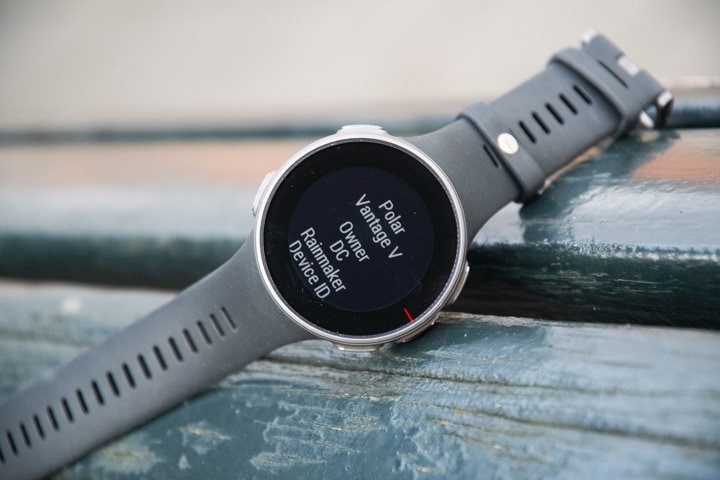
It’s been a long road for Polar faithful, a nearly five-year road in fact, as the top-end Polar V800 was announced in January 2014. As such, there’s been significant expectations built in terms of what a V800 replacement should be. Without question – those expectations wildly exceeded reality (since Polar basically took away features compared to the V800). Polar simply doesn’t have the staff of Garmin to compete on features these days, and I don’t see that changing anytime soon.
Instead, Polar has to compete on accuracy and ‘pro level features’. At least, that’s the marketing message. But I’m not sure they did that. There’s no part of the Vantage V product that’s more accurate than their competitors (let alone Apple). And when it comes to ‘pro’ level training/recovery features for training, I see this more as catchup than outpacing. After all, these are basically the same features that Garmin and Suunto have had for years.
So what is Polar’s strength at this point? Perhaps their 1-second recording rates for longer distance runners. It comes in at 40 hours, which is more than Garmin or Suunto can do at 1-second recording. I see that positioned best in slightly shorter ultra races to say ‘We’ll have plenty of battery left over’, rather than a UTMB race where you’d probably end up short in 1-second recording mode.
I’m interested in seeing where Polar plans to go with the Vantage series in terms of features and accuracy. While they’ve outlined the next few months – that’s mostly backfill of missing V800 features. I’d love to see them put together a bit of a more roadmap that compels potential buyers into the platform being more future-focused, rather than catch-up focused.
With that – thanks for reading!
Found This Post Useful? Support The Site!
Hopefully you found this review/post useful. At the end of the day, I’m an athlete just like you looking for the most detail possible on a new purchase – so my review is written from the standpoint of how I used the device. The reviews generally take a lot of hours to put together, so it’s a fair bit of work (and labor of love). As you probably noticed by looking below, I also take time to answer all the questions posted in the comments – and there’s quite a bit of detail in there as well.
If you're shopping for the Polar Vantage V or any other accessory items, please consider using the affiliate links below! As an Amazon Associate I earn from qualifying purchases. It doesn’t cost you anything extra, but your purchases help support this website a lot.
Here's a few other variants or sibling products that are worth considering:
And finally, here’s a handy list of accessories that work well with this unit (and some that I showed in the review). Given the unit pairs with just about any Bluetooth Smart sport sensors, you can use just about anything though.
This dual ANT+/Bluetooth Smart sensor will transmit cadence not only to your bike computer/watch, but also 3rd party apps like Zwift, TrainerRoad, and more.
Speed sensors are primarily useful for offroad usage. I don't find much of a need for one while road-cycling, but for mountain bike trails they can help alleviate speed/distance issues with poor GPS reception in dense trees.
This is a strap I often use in testing/comparisons. It's dual ANT+/Bluetooth Smart, but it also supports the 5kHz analog heart rate transmission for older gym equipment. Also, it has workout storage/recording in it and supports two Bluetooth connections.
This is a great strap, especially if you're going to the gym. It's dual ANT+/Bluetooth Smart, but it also supports the 5kHz analog heart rate transmission for older gym equipment. Note that it only accepts a single Bluetooth connection, versus dual-connections for the Polar H10.
I'd argue the Polar OH1 Plus is the best optical HR sensor out there. So while it might seem odd to get this when your watch also has a optical HR sensor, this one is just better most of the time. Plus, it also has workout recording storage. Dual ANT+/Bluetooth.
The Polar Verity Sense is the newer variant of the Polar OH1 Plus. And while it might seem odd to get this when your watch also has a optical HR sensor, this one is just better most of the time. Plus, it also has workout recording storage. Dual ANT+/Bluetooth.
And of course – you can always sign-up to be a DCR Supporter! That gets you an ad-free DCR, access to the DCR Quarantine Corner video series packed with behind the scenes tidbits...and it also makes you awesome. And being awesome is what it’s all about!
Thanks for reading! And as always, feel free to post comments or questions in the comments section below, I’ll be happy to try and answer them as quickly as possible. And lastly, if you felt this review was useful – I always appreciate feedback in the comments below. Thanks!
















































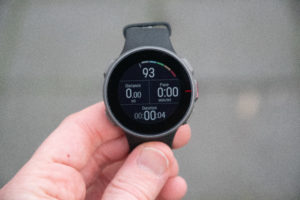

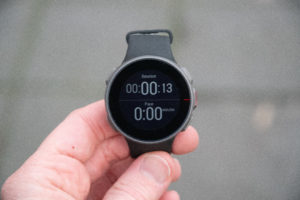
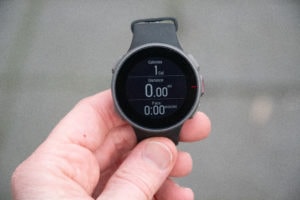








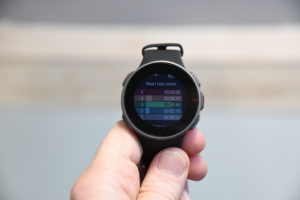
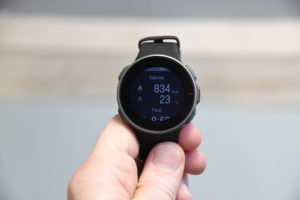
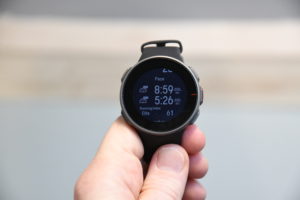
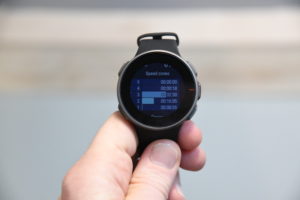
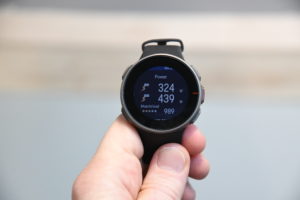
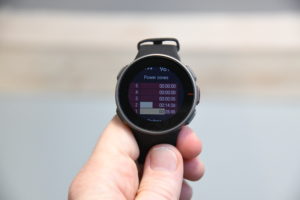
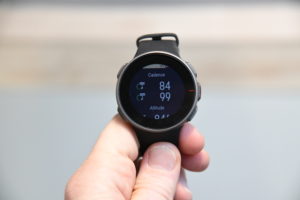
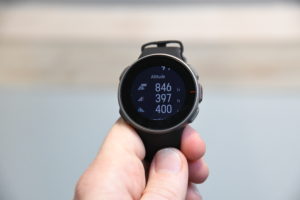




































































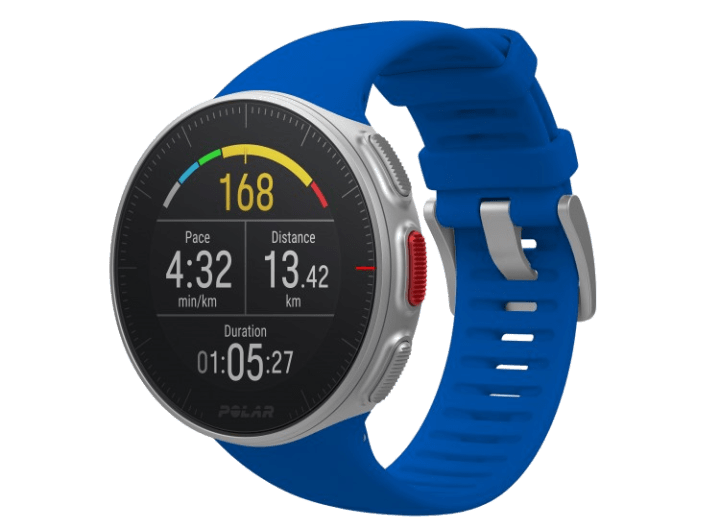


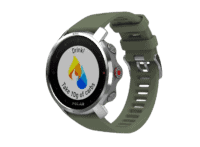
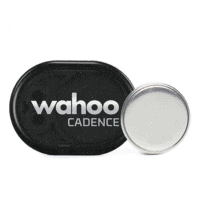
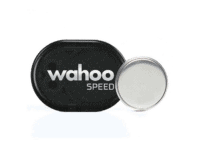

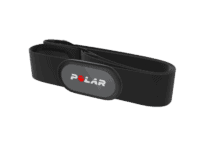
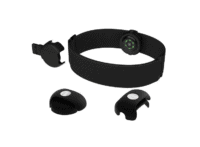














Thank you, perfect review.
I’m not sure you’ve got it right in terms of background sync. My Vantage V syncs automatically with the Flow App all the time.
As a user of both the 935 and the Vantage, I find the training load and recovery features much more actionable on the Vantage. With Garmin, I get a lot of numbers (e.g. training effect, HRV stress, etc), but I don’t always know what do with that information. The Vantage simply tells me to train hard or take it easy on a given day.
Not sure what to say there – mine has never synced automatically, on either of the two Polar Vantage V units. Only if I manually sync it. I’ll ask Polar what’s up.
Same for me – it syncs automatically from time to time.
Mine (M) has auto synced once. Personally not bothered as I’m in no major rush to sync the second I finish, however it’s just something else not quite right with the watch(es).
My main issue is it actually not syncing. I have to either put watch into and then out of flight mode to then sync or on occasion having to remove phone from watch and watch from phone and start again.
This has persisted through all firmwares so far. Polar uninterested.
The M is for me proving to be better than the M400 it replaced but it is definitely testing at times with its silly little ‘quirks’.
Had I had an M430 I suspect I’d have been disappointed tbh.
I’ve only been running with the Vantage V for a week, but so far it’s done background sync once and every other day I’ve had to manually start it. No idea what was different the one day compared to the rest, but that’s the only time it happened automatically.
My GPS data has been fair to poor so far, with lots of rounded corners or completely misaligned tracks compared to the Garmin 645. I’m hoping there’s a firmware update to improve it, but right now it’s not great at it’s main job.
Auto synchronisieren works flawless on Vantage V
My vantage M also syncs automatically.
Looking at the chart- I don’t see where my watch estimates vo2max, or where there is an internal temperature sensor.
Hi there,
Still rate the Vantage? I’m on the fence but don’t need/want features (as auto recovery etc.) that I don’t use IF they don’t work. Simple speed/distance will do just fine.
At last! Thank you.
Ray, contrary to your experience my Vantage V does sync automatically to my iPhone. It syncs automatically each hour and after exercise. It stops syncing after it lost the connection for some time.
Odd, no luck for me on auto sync – it can go basically forever until I manually sync it.
It might have something to do with location and background sync settings in iOS. I know I have enabled both for the Polar Flow app.
Yup, all totally enabled (including ‘Always’) for me as well on app.
Actually my Vantage V syncs in the background just fine. I suspect this may be an iOS vs Android thing. I see an iPhone in your photos, whereas I’m using a Pixel 2. Not to say it shouldn’t work with iOS too, but just FYI.
Interesting – I’ll find out about Android from Polar. It definitely doesn’t on iOS for me. I can have both next to each other all day long, and unless I manually sync, it never syncs automatically. For example, it’s 2:05PM, and the last time it sycn’d was 12:24PM (when I manually sync’d it), despite the app being open
My VV is auto-sync’ing with iOS.
Great stuff, I never cease to be amazed at the variety of great-looking settings you get for the close-up images.
I was intrigued that you still hold out hope for Polar to go down the ANT+ route. Was that hope or a slipped sentence somewhere in Finland?
I’ll have to double check the running power Zone Lock link to dcrainmaker.com, not sure if that has been enabled yet on the Vantage??
“I was intrigued that you still hold out hope for Polar to go down the ANT+ route. Was that hope or a slipped sentence somewhere in Finland?”
Finnish people were involved in that comment, though not on this weekend’s trip to Finland.
Good point about zone lock – that’s the screenshot from last night, though I don’t tend to use the Polar zone lock features (just not my cup of tea, regardless of vendor – I get tired of things beeping at me).
I’m showing Zone lock in Flow for power zones for Vantage (see screenshot). Interestingly, though, it’s in there and noted “v800 only” for speed and HR zone lock.
;-)
RP Zone Lock on FLOW been there since beta and has never worked on Vantage. SM@Polar noted that there were several items on FLOW that needed tidying up. This was probably one of them.
I can’t see where it says “V800 only” on the image tho??? That’s interesting
Anyway, RP ZONE LOCK is probably going to be a future feature, it’s just not there now AFAIK.
It’s time to update the article.
– background sync with the phone – done
– navigation – it’s in the product update plan
Umm, the post explicitly notes that navigation is in the product plan and even the dates.
Background sync isn’t working for me – so Polar needs to sort that out.
Thx, yes these sudden linear drops on oHR are really annoying. As far as i know Polar is well aware of this.
This was a good review. I’ve had the watch since it was released and you nailed GPS and oHRM.
I also agree on your sober opinion around power.
(And yes, like already mentioned a few times, it does auto sync without showing it on the watch. If you by chance look the mobile, you sometimes see the notification for syncing with Vantage)
Thanks. Yeah, it may be syncing for others – but definitely not for me. I can go an entire day without it syncing, even when Polar Flow app is in background.
Either way, I’ve updated the review to note that – until Polar can sort out what’s up.
I think the Vantage works like the M400/M430 does. Which means it tries to sync daily and after each workout.
But it seems to fail at times because it fails to connect with the phone. Probably some power saving feature.
The watch syncs automatically. But it’s not a robust feature, and I don’t trust it.
I think it syncs after every session and also every hour.
For me it has been very stable using my Sony. Pretty sure that if I used my Huawei instead it would be a different story due to it’s power saving/process killing behaviour.
Polar just released an Android-specific update mentioning Huawei “setup” issue fixes: link to support.polar.com
Yes, any issues I had it turned out to be power management related, i.e. phone killing the Flow app running in the background, which prevented a proper sync and caused delayed notifications.
Hi Ray,
1st: thx for your amazing job, I’ll never stop to be impressed.
2nd: as a V800 user, I was waiting for Polar to finally launch their new unit, and for your review of it! Least I can say is that I’m disappointed (not in your review ;-) ). GPS accuracy and the ability to use my V800 for all my activities (indoor swim with H7) was really the only reason why I did not switch to a Fenix 5 yet… oh and price.
I plan to have a all-in watch so I suppose I’ll need to win the lottery and get my fenix… or, wait for the next extravaganza and FINALLY WIN !!!
Thx Ray!
I’ve looked at the GPS comparison files and in both runs (with Vantage, FR935 and AW4), it’s the AW always the device that records the higher distance. But, when looking at your detailed analysis over the map, the AW usually gets the path right (except for the swoshing hehe).
Does that mean, in your opinion, that the AW accuracy could be the best of all three devices? I’m quite amazed by the AW4 accuracy, not only in this review but also in its dedicated review (the same works for the WOHR).
I was quite convinced on buying the Vantage M/V, but the performance of the AW4 makes me doubt (no ultra distance runner, only 10-15K 2-3h rides and OW swims in the summer). What do you think?
Optical HR wise, yes, after the first 45 or so seconds, the Apple Watch 4 is easily the best wrist based optical HR sensor out there.
Unfortunately, it’s not the best all around sport device out there.
And GPS wise? Do you thinks it’s at the same level of Garmin and Polar?
Not really, it cuts too many corners.
So even if the GPS Accuracy in the VV (I’ve read VM is slightly better, I don’t know if that’s also your feeling) is a big pseh, you’re not convinced by the AW4?
What I’m looking for is something accurate and not too overwhelming (I had a 935 and a 645 returned because I feel Garmin offers too much info too confusingly displayed) mainly for running Cycling and swimming (pool and OW).
One silly question: does the AW cut corners when using a 3rd party app?
And regarding the Vantage. I had also the M for a couple of weeks. I found the delay between pressing the buttons and the response of the watch frustrating. Also experienced HR dropouts with steady treadmill runs. Does the Vantage V perform better?
Sorry for asking so many questions. I truly appreciate your efforts (even if I know you enjoy it hehehehe)!
And here I was hoping your review might rid me of my buyer’s remorse ;).
I’ll keep wearing my Vantage on the other wrist because resale prices are already down in the cellar (minus €100,- and more) because there are so many up for sale already.
But from a practical point of view it’s just a redundant piece of device for my 935.
You weit No under Race Prediction but Polar’s Running Index does predict race times, quite more accurately than Garmin’s I might add. Or do you mean in the watch?
Thanks for the review.
In the watch itself is what I was referring to. Maybe I’ll add a * or something.
I’ve been beta testing the Vantage V since June to give them data for open water swims, and GPS accuracy is getting worse with every update. Currently, it stops recording GPS data <100 yards into my swim for the past 4 swims. I've sent them my flow logs but haven't heard back from them in over 2 weeks now.
Here's my swim this past Sunday – link to flow.polar.com
The Vantage V is also available in Orange – not only Black and White.
Regarding the “missing numbers” in the cardio load screen (app): just tap and hold. But you’ll need to magnify the screen for that.
BTW: my Vantage V also syncs flawlessly in the background (Android).
Good point on tapping/holding, however, that’s super clunky because you have to do it for each data point. No idea why they just don’t put a scale on it.
Hello Ray,
1st of all, thank you for the review, hope you are finally OK!
Could you make a comparison of swimming HR reading with the OHR function vs H10’s built in memory readings in case of VANTAGE M testing?
As I understand more swimming tests are awaited, could you test if the buttons are enabled during swimming workouts? (for manual lap markers, or for just pausing the training for a short breath..:))
Is it certain that the vantage M – that is in almost the same price range of Garmin’s fr735xt – will not be able to handle waypoints?
Buttons on the V work fine while swimming. What (I don’t think) Ray didn’t mention was that you don’t need to press buttons with the Polar while swimming. It monitors rest automatically, and when this works it blows Garmin out of the water for swimming. There have been…issues…with pool swims though. It’s nice because you can start the activity and just stand there and it knows you’re not swimming. When you start it starts a lap and when you stop it starts a rest. The times were identical to my Garmin where I was pressing lap too.
Polar do lack a repeat timer, they just have a rest timer which is a different thing and slightly less useful for swimmers.
For me the oHR while swimming is reasonably good.
I’m still very happy with my 935 (although this is my third device: battery and syncing issues). But one thing I envy this Polar watch is the ability to customize settings, data screens, etc. using the mobile app. I wish Garmin got into that wagon.
Totally agree. I’d love to see them find balance and offer both. There’s a lot of things I just want to change on my wrist without involving a phone or app, but sometimes if I’m setting up a new device doing it on mobile phone/desktop is a heck of a lot quicker.
Can’t help thinking that if Garmin had released a new version of the Fenix or say something to replace the 935 would you have waited 4 months to give it a good look over? Your summary suggests the only thing that might be better than rival products is for the tiny fraction of runners who do races up to 40 hours? I’ve been running 35 years and only managed a few 4 hour runs in that time. ShalI I stick with my 935 then?
Tim, that’s true from a pure functional standpoint. From a usability/style standpoint the Polar is nicer than the Garmin, and Flow is nicer than Connect.
Think of the Vantage V as an old Porshe with a broken heater. It has a cassette deck and no heating but it’s still desirable. Garmin are more like a new Ford with a million features. It has everything you need and probably outpaces that old Porshe.
The question is; are you buying with your head or your heart?
“Can’t help thinking that if Garmin had released a new version of the Fenix or say something to replace the 935 would you have waited 4 months to give it a good look over?”
Well, Polar waited two months of that until they started sales. So the last month was me being sick and unable to get the workouts. It’s why there’s almost no product reviews in November of anything for the most part.
But, to answer your question – yes, I waited on the Fenix 5 for almost exactly three months as well. Because just like Polar, I was waiting for a final software/hardware before my in-depth review. In the case of the Fenix 5 Plus, that review came out on the same day units started shipping. Same with FR935.
I can’t change when companies decide to start shipping.
My head says not to buy another device that does do not much more, if anything, than my current one already does and then of course one that is not from the same vendor. Running power just from a single device would have been interesting but, as mentioned, it is all a bit of a wash at the moment. The one thing it has made me think about is to run uphill slightly easier than previously.
Ray – thanks. Guess I was thinking of your “first look” posts which usually tell me everything I want to know at the time.
Yup, I released a First Look post on the Vantage V the same morning it came out back in September: link to dcrainmaker.com
The 935 is overkill for you! not sure who you run with but I hardly think its a small fraction of runners who run longer than 4 hours, maybe its the circle I run in but most of my weekend “long runs” go longer than 4 hours , mid to back of the packers running a 50 KM race are going to need a watch capable of 10 plus hours , and most 50 KM racers get the itch to do a 50 miler now were over 15 hours recording, i do wish that they would upgrade the watch software to do 5, 15 and 30 second recording .
Average run time for Strava users is less than 50 minutes.
link to dcrainmaker.com
Multisport watches are also used for activities other than running.
My sync is arbitrary at best on the Vantage but as others have said it does occasionally do it automatically. Don’t get me wrong though, sync is rare so my experience is such that I can believe you’ve never seen one!
A minor point though, the notification screen actually does have notifications, for Ortho tests and the fitness questions. It shows a blue dot on the time screen if there’s a notification waiting and you swipe up to see them so that “no notifications” area is actually finished and working, just they have yet to tie up the phone to post items on it.
Another even more minor correction “comes in two colors: White or Black” should be three and orange as you mentioned elsewhere.
Great review, I think you were maybe a little kind around things that don’t work as they should but I’m sure in time these will be fixed. The December update did great things for lots of bugs. It’s my favourite of all my watches but I default to the 935 or Fenix 5+ because they work and have all the features, the other wrist then fights it out between the Suunto 9 and Vantage. But when I look at the collection it’s the Vantage V I want to pick up and put on, and it’s the Flow app that makes me least disapointed in data presentation! I’d quite like to see Garmin buy Polar just to get some style pointers :)
Thanks, fixed on Orange is the new Black.
Ultimately on UI/apps I think all of them pros and cons. I feel like the Polar app just wastes a lot of space on things.
As for sycning, it’s now 4:40PM and it still hasn’t synced since 12:24PM. :-/
I have exactly the same issue as Ray – my Vantage V does not synchronise automatically (occasionally did before the software update).
FWIW my Garmin Edge 1030 almost never syncs either. I regularly play the Garmin re-pair game and lose too. I played this depressing game today and thought of this thread :) In the end I added wifi to get my ride synced because in late 2018 nobody should have to find a cable to sync!
Hi Ray – thanks again for your incredible detailed analysis. I have been using the V800 for 5 years now.
It amazes me that the follow-up product seems to have almost nothing to merit a swap. Not even providing the same features is just deeply disappointing.
Mike, I’m not so sure it’s fair to say “nothing to merit a swap”. It’s all relative. For some, that would be true. For others, there are substantial improvements–here are a few of them, all valued by the eye of the beholder. DCR mentioned these and more, but I’m adding some color:
1) Those looking believing in or wanting to try power-based training (and many do) in a slick package with no sensor and total integration. Nobody else has this, and power-based training–love it or hate it–is one of the most significant phenomena in the industry.
2) You like the fundamental Polar ecosystem, and this adds Training Load Pro and Recovery Load Pro. This is a substantial upgrade to v800’s Recovery feature.
3) Wrist-based optical heart rate, which gives you 24/7 tracking and reporting, a convenient all-in-one solution for casual athletes, and an opportunity to leave the strap at home sometimes for the more ambitious.
4) It’s the newest stuff. On the surface this sounds shallow. But dig deeper and you’ll have many reasons for this to matter: support and online chatting will diminish over time, firmware updates will assuredly stop or slow down a lot, the look is dated or it’s scratched up, the battery can’t last forever (and replacement is expensive), compatibility with 3rd-party sensors will be neglected by those 3rd parties, and it’s plainly more fashionable and “wearable” to work if that stuff matters to you. If you want 24/7 tracking and can’t wear it to work, you have a problem.
5) Battery life (in a lighter package)
g
Oh, I should have added–I owned a v800 for years, absolutely loved it, and didn’t have a “style” issue at work. I agree with DCR’s assessment that they are playing some catch-up. Polar should have released this 2 years ago. I’m in this hobby for the long haul, so I’m not in some huge rush, nor evaluating stock market value to make my purchase.
However, it was harder than I thought to part with it, but then Polar gave me a 25% loyalty discount (just ask Support) and pushed it over the edge. I miss a few things, but nothing that won’t get fixed very soon nor I can’t live without. GPS issues don’t really affect the distance, at least where I run. Precise maps aren’t that important to me. I use structured phase training for intervals, so intervals timer loss I can get over. Treadmills in my gym use bluetooth, and my H10 connects to both watch and machine. I miss race pace, chest/tap for light or clock, and Live Strava segments–the latter I don’t rely on but enjoyed here and there.
Hi Grant, did you have to send back your V800 to get that discount?
Last week I contacted Polar USA requesting instructions to get the discount and they told me that they are not giving loyalty discounts until a reasonable 5 months after VV launch. You may request a code for other product but not usable on VV. It seems they changed their mind after some consumers got the tip.
No, I didn’t. I sold it 2nd hand for a nice chunk of change. v800 is still a pretty high-end watch for someone serious about training and precision.
I am also pretty disappointed in the VV compared to V800. Polar traded dropped features I use in favor of stuff I don’t, but I really did not want to change ecosystems.
I appreciate the vastly improved sleep monitoring (but visual presentation of this is meh, compared to others, or Oura ring) and the constant HR, but the loss of GPS accuracy, notifications, HR strap pairing for swimming, and frankly the old rectangular shape, were a bad deal. I might go back to wearing the V800 until Polar updates the VV enough for a fair fight. :(
Really disagree in the fashion point. I’ve received several comments on the VV (“god that’s a huge watch”) and in three years the few comments about my V800 usually confused it for an Apple Watch (yeah I don’t see how either, but there you go.)
I really liked the rectangular face of the V800 and the simple clean look of it overall. It didn’t catch on the sleeve when I put my jacket on. The VV is a slightly cleaner-looking giant-ass round watch just like everyone else’s. It has no style.
Thank you for the review. Can things like GPS and HR accuracy be improved through software or firmware updates? In other words, is it possible that these Vantage devices could eventually become as accurate as the V800 or at least become more accurate than they are now? If so, do you think that is actually something Polar will actually look to improve/add, similar to how it plans to add smart notifications, etc.? Thanks.
Definitely – and I’ve certainly seen both improve over the time I’ve used units. Generally speaking on GPS improvements we’ll see those plateau pretty quickly (if not already). Usually you get an initial rush of fixes for edge cases, and then it kinda flat-lines.
I don’t see a scenario where GPS-wise it becomes as accurate as the V800. It’s not so much different chipsets, but different antenna locations and different power profiles (battery drain). All of which will make it very challenging (if not impossible) to match that of the past.
HR is an area where I suspect we’ll see the most drastic of improvements, especially over the first year.
Ray, are you seeing or reading about a significant difference in the actual distance due to the GPS issues? I am not. I see my VV’s GPS tracks leaving the path, but nothing that’s affecting distance in any significant way. At the resolution I typically see it at, certainly on my phone, I can barely tell. But that’s just me.
If I’m Polar, I’m not investing huge amount of time and money on making sure my GPS tracks are clean and follow paths exactly. Correct me, but does the sports enthusiast they target with this watch really pine away over the look of their maps at close resolution?
It depends. Up until last week I was actually seeing about .02/mile variance (usually short – which really adds up), though with the latest firmware things do seem better. Unsure at this point if this was just due to recent routes being less of an issue or what-not.
Prophetic words. The Vantage V GPS remains crap. The Coros Apex really nails it (this was WITHOUT track mode). I drag the VV out now and then as I like Polar Flow and the free included structured workouts but it never fails to disappoint me. It will go back in the draw to gather dust again.
Which is one is better, Suunto Spartan Trainer or Vantage M, for running, hiking and open water swimming ? Suunto Spartan Trainer is currently on sale on amazon for 140 €.
It’s honestly a pretty good wash between the two of them in most categories.
However, for hiking – or more specifically trail navigation, there’s no competition. It’s just not there today in the Vantage series (and is only slated for Vantage V as of present, in February). Suunto has all the navigation stuffs you could ever want.
I bought both watches and returned the suunto spartan trainer. OWS on polar was slightly better. Hiking features on the polar are lacking, like no temperature, no navigation, but the battery life is significantly better. Battery life on the suunto was only about 8 hours. Optical HR on polar was better for me, but gps on polar is worse. I like the vantage watch better, and I like flow better, so I kept the polar. Hoping that it gets navigation because that’s a big omission. Neither have a barometric altimeter.
Also, when hiking/backpaking, I use an etrex 30 and my wife has a fenix 3, so some of those metrics being absent was okay for me. If you’re really doing a lot of extended backpacking week-long trips, just get an etrex.
Thanks for the review! I’ve got one remark. You don’t need double tap on Vantage V. Single tap is enough to trigger the touch screen.
It seems super inconsistent for me. Double-tap is the only thing that consistently works do dive into menus. Where’s about half the time if I single-tap it just simply jiggles the screen like Santa’s belly.
I was having the same frustration. 2-3 taps to get it to work. I asked Polar Support about it and they said I’m supposed to “touch” the screen, not “tap”. It’s no iPhone, but it works a lot better than tap.
Same on the Edge 820. A lot of the issues there are due to people being so used to phones. Used right these touch screens work fine.
I’m really not using the touch on my Suunto or Polar though. It makes no sense at all when you’re doing things buttons do better. On the AW touch makes sense because there are apps so ironically Garmin are the only ones who would maybe make touch useful with ConnectIQ.
Am I the only one who got stressed out seeing how close Ray’s phone was to dying in those photos?
Hi Ray,
thanks for the insight.
I just don’t understand why you will be buying one. Are you hoping that polar will catch up?
I’m just frustrated with my V. Bought it for multi sport purposes and couldn’t believe that they rolled out a sports watch for half a grand without a stopwatch funktion.
Targeted marketing into the Crossfit community without the opportunity to hook this thing up to at least concept2 machines is ridiculous.
So for triathletes this may some day be worth spending the money but I am emensly dissapointed.
Have you seen the photos of his cave? Ray has a compulsion to own at least one of everything sports related and put it in neatly labelled boxes. The real question is why the Girl lets him hoard so much old crap ;)
DC, I have both Polar Vantage V and Garmin Fenix 5 Plus and Suunto Spartan Baro
The polar is better and more accurate and reliable with all aspects than the others.
Can you give some stats on that, it’s hard for me to give merrit to quality comments when no details are given.
Just have the Polar Vantage V and Garmin Fenix 5 Plus (that has maybe more feature but at the end most of them are unnecessary…) and you for sure get into my conclusion.
To make it more clear and understandable:
Polar = Apple
Garmin = Samsung
So I wait another ten years and maybe than the gadgets will live up to my expectations….
I’ve had Vantage V for about a month and mostly used it indoors in spinning classes and on the treadmill with a Stryd. The oHR is working great, especially in spinning classes. Only a few runs outdoors, and not with latest fw, but V800 was much better. Since I’m mostly running in the city and with a Stryd for pace and distance, I don’t really care that much about super exact GPS, but it is a bit annoying it being worse than V800.
I can’t compare to neither Garmin nor Suunto as I have chosen to be faithful to Polar. For good and for worse. Polar Flow is great, and I have been very pleased with V800. I had it for three years, and it was continually updated. I have a V650 as well, and it works really well. I see Vantage V as a long term investment, and not “needing” to buy a new expensive update in two years time as it seems to be in Garmin land.
Also, I only rely on a fraction of the features of these watches, and don’t really care about feature complete watches. If I would buy something else than Polar it is most likely an iWatch, but I rather have a “real” training watch, but maybe the iWatches are exactly that nowadays anyway. Just my 2 öre.
Nice Review, but I have a question. How do I know if I am fully recovered before starting a training on Garmin or Suunto watches. If I recall it correctly 935, Fenix5 and S9 do not feature Body Battery or Recovery Test.
The HRV Stress app is the Garmin version. It’s nowhere near as nice to use and I’m not sure results are uploaded anywhere. It gives you a number for stress that you interpret (it also has a colour coded ring on screen). It doesn’t give the advice though like the Polar.
The HRV Stress stats are recorded within the Garmin Connect Mobile app under ‘Performance Stats’.
The Advice bit though comes from Training Status on the Garmin side.
So it is, thanks Ray!
This is the issue I have on Garmin, there are thousands of things you need to just know to get value from the platform. When comparing the watches I found a load of things I was unaware of due to Garmin’s poor UI designs – their platforms have been designed with extensibility for developers in mind rather than consumers. I find on Polar the important things are right there where you’d expect them (with the exception of recovery on Flow – that’s just bizarre are you mentioned in your post!).
I’m still not seeing any explanation on the Garmin though, it just says “train as usual” and it has every time I’ve ever looked. Polar has a few screens of text telling me what and why things are going on. Admittedly for 2 weeks after purchase the Vantage said don’t train or you may die, but that’s working now it has some history :)
How are folks getting 5 years out of their v800? Barely (almost exactly) 3 years of service on mine and the right side buttons are no longer water-tight. Not to mention the plastic case is falling apart near the charger port and the perimeter of the crystal is delaminating from the base material. Maybe it’s because I wore it 24×7? I’m hopeful to see ANT+ added to the V-M in the (near?) future; too accustomed to Flow ecosystem to jump to Suunto or even the newbie COROS Pace at this price point.
There is a Connect IQ app that provides a value for running power without additional sensors (i.e. foot pods). Does it work? As well as the others, as far as I can tell. But recognizing this CIQ app requires some changes in the review where it is implied that extra hardware is required for run power from Garmin (and not required for the Polar V). Now, maybe this is true if you exclude the Connect IQ app store, but it does seem worth a mention as the app is free (even if it does require action above and beyond unboxing).
Which app is this?
The official one from Garmin, called Running Power.
That’s Garmin’s app, which requires either an RD-POD or HRM-RUN/HRM-TRI strap.
Which app doesn’t require extra hardware?
there are actually two,
link to apps.garmin.com
link to apps.garmin.com
and actually the suunto ambits already had such an app several years ago, done by me :)
link to movescount.com
Wow, that’s pretty huge, no? And you’re saying it uses the watches internal whatevermeters to produce consistent power output figures? Still evaluating my overall belief system on the power phenomenon, but I’m starting to believe the scale is unimportant so long as the meter reacts to some key inputs, at least hills if not also form.
I wore my V800 24/7 for three years. Mostly just a cross fitter, occasional pool and OW swimming. Very rare hikes. I put plastic film screen protectors on it pretty consistently. I certainly heard sad stories from other owners but the buttons are intact and watertight and the charging port is fine and except for some texture wearing off the black plastic sides, it looks and acts like new.
Hi Ray
Well I had high expectations. I mean, 5 years in development, and look at how good (if clunky looking) the V800 was. I pre-ordered it and when after all that waiting it was finally delivered gave it a whirl. I had an almighty shock. It was so minimal and so unfinished. I felt the surprise and disappointment that Dorothy felt on first seeing the wizard of Oz. The only way this makes sense is if Polar had decided to no longer pursue the premium watch market, had been quietly working on their successor to the M430, then had a change of heart and essentially rebranded the Vantage M by adding a barometer (therefore a basic power metric) and a metal case (which may inadvertently affected the GPS reception of the V just as is the case with the Fenix models). My initial experiences with the GPS, baro and power were terrible. The only saving grace was the OHR. I sent it back. Then out of curiosity as my experiences did not match those of others I bought a “second hand” one on Amazon (pristine) at a fraction of the price. A couple of firmware upgrades later… Bizarrely my experiences have been really rather different this time. Good GPS, good altitude measurement and the WOHR has remained spot on for me. I can only wonder if there were QC issues with the early release devices. Of course this is Polar’s (big) problem but it does make generalisation difficult. Here is a fairly demanding (conditions for GPS not physically, I am 60 and getting over flu!) pair of routes (SSU and VV). Apart from a squiggle at the start they are both imo really good, the VV possibly a little better overall. I have also had a run where the route from the VV compared favourably to my 935.
link to mygpsfiles.com
For what it is worth:
1. My background sync works fine (Android phone). Again maybe this is a QC issue.
2. I had to rest up with the flu so my training took a dive. My 935 said “you wuss”. The VV orthostatic test (during which I felt dizzy on standing) gave me the thumbs down and told be too rest even though it also said I am detraining. I don’t see this as inconsistent as, as you allude to, they are not the same thing. This is a more complex recovery metric with different attributes, orthogonal measures of recovery, any of which may provide you with an additional constraint. I took its advice and frankly I am glad I did.
3. Running power… I could talk beyond the point of any redeeming interest on this so please feel free to skip to the end.
In a nutshell :
a. it isn’t what it says it is.
b. it is useful.
c. the scale is specific to the device and labelling as Watts is misleading (James Watt may be rotating in his
grave).
d. It only has to be consistent such that all power measurements from different devices are highly correlated.
e. The values should be expressed as a fraction of rFTP measured on a specific device not in Watts for them
to have any meaning or to allow comparisons.
Only then can values be compared and used constructively.
My big issue with Polar is that although the VV connects to Stryd it is not clear how it corrects those values (much lower Wattages from Stryd than comparable devices) in calculating muscle load. It also uses maximum power to set up zones (straight from the cycling world) rather than rFTP”w” which is more physiologically grounded and seems to feature more in literature on using power in running.
It is a mixed bag but I have decided to stay on for the ride (roller coaster?)
Andrew,
On the point of how Polar is dealing with the variation in power wattage from Stryd to its own power meter, my best guess so far is that the load and recovery metrics are applied to the coaching as a totally relative statement. It’s all based on your previous levels rather than some absolute value.
The % of rFTPw or critical power (or MAP in Polar’s case) makes sense. It is an option in the Flow app sport profile settings. I just haven’t tried it, nor fully understand implications on entering rFTPw or CP value on the rest of the model. If my earlier theory about “everything being relative” is true, then it should accomplish what you are looking for.
Would love to hear anyone else’s experience with this.
Thanks Glenn. I didn’t notice that. If muscle load is calculated using %rMAP(device) then as long as you stick to that device it should be valid. I wonder how many VV users are aware of that? That said, MAP seems a funny choice for running. Polar Flow gives an estimate of MAP based on an estimate of running VO2max (running index). Of course this estimate will not apply if using Stryd for power and you will need to measure your rMAPw(Stryd). This looks pretty much like a max hr test – let the fun begin! Of course you can estimate your rMAPw(device) from your rFTPw(device) obtained using something more civilised (30 mins best, 3 mins 9 mins etc…) and then multiplying by 4/3 but you have an approximation of an approximation so it all becomes a little sketchy. I would have preferred zones based on %rFTP(device) as I think this is easier/better for runners. Of course I can just enter these manually. What I don’t know is how Polar then works out muscle load. Sore head developing…
Ooh, I’ve really wanted to have this discussion as I’m experimenting and trying to figure out how to apply and make this useful in day-to-day training. I’m kind of over the issues of less accurate GPS, oHR that doesn’t meet strap standards (which Polar never claimed), and the handful of features that got excluded but were in v800. I think Polar will fix virtually all (except 5khz transmission) in the coming months.
So on the practical use of the “power tools” in the watch particularly as they related to training and recovery load, I think it’s actually simpler than it seems, and here’s what my little personal “theory of relativity” is based on:
1) MAP = rFTPw = Critical Power. Each sensor, including Polar, generates a different wattage scale, so it’s different depending on the tool.
2) The Training Load Pro and Recovery Pro evaluations that evolve following activity are set in a relative context. So it doesn’t matter what values you use as long as they’re consistent–why the conventional wisdom for Vantage V says to use their wrist sensor, a 3rd party, but not mix and match. Whether the power zone scale differences are because your HR and zones are different than the next person, or because your sensor captures higher (Polar VV) or lower (Stryd) values, it’s all relative when translated after activity into the bulleted scales used by Polar.
3) So 3 bullets of Muscle load can indicate 500 kJ (mechanical energy) units for one person and 1000 for another. Or the same person may use Polar power vs. Stryd power and come up with 1000 vs. 500 kJ. But as long as it’s in the range of that person’s “normal” and consistently using the same power device, the recovery recommendation will be “relatively relevant”.
4) you could change from using Stryd to Polar power device, reset the baseline period, and go on your merry way. You could even get comparable Polar recovery metrics–you would just lost that month during which time you were resetting your baseline.
I’d love feedback on this from anyone!
Is MAP = critical power now?
Hi RG – found this on web.
MAP (maximal aerobic power) is the highest aerobic power one can develop at the end of a short intense burst of power of a few seconds, such as a sprint or at the end of an all-out break-away of a few minutes.
P20 is the highest power one can develop during 20-minutes.
FTP is the highest power one can develop during 60-minutes.
I thought this was 30 minutes.
CP is the maximum rate of work that can be sustained for a very long time without theoretical fatigue.
So no, they are at two extremes.
link to iqo2.zendesk.com
Hi Glenn
Power should be expressed as a measure without units by expressing it as a ratio of some datum measured using the same system/sensor (not in Watts which is meaningless for running). Not sure if that is the “relative” you refer to or not.
Common datums are CP, FTP, MAP. Unitless power values obtained at some instant during an activity using different datums for the calculation would be different so:
1) No as rMAP rFTPw rCP (if there is such a thing) e.g. cycling FTP is typically around 0.75 x MAP (but this is very approximate as FTP and MAP are really chalk and cheese).
I would expect:
power(Stryd)/rFTPw(Stryd) = power(Polar)/rFTPw(Polar) etc…
power(Stryd)/MAP(Stryd) = power(Polar)/MAP(Polar) etc…
These give us unitless measures of power so that we can compare power from different technologies. We do have to choose the same datum (FTP, MAP, CP) to make these comparisons.
so unitlessPower(FTP) unitlessPower(MAP) unitlessPower(CP)
2) I don’t think so. Polar Flow is expecting a MAP to do this calculation.
3) Don’t think so.
4) I think it fine to change as long as you set MAP(Polar) instead of MAP(Stryd) then stick to that device.
Hi Ray – not sure if you can help here as the website strips out the not equals sign.
Here is the post trying not= instead.
Power should be expressed as a measure without units by expressing it as a ratio of some datum measured using the same system/sensor (not in Watts which is meaningless for running). Not sure if that is the “relative” you refer to or not.
Common datums are CP, FTP, MAP. Unitless power values obtained at some instant during an activity using different datums for the calculation would be different so:
1) No as rMAP not= rFTPw not= rCP (if there is such a thing) e.g. cycling FTP is typically around 0.75 x MAP (but this is very approximate as FTP and MAP are really chalk and cheese).
I would expect:
power(Stryd)/rFTPw(Stryd) = power(Polar)/rFTPw(Polar) etc…
power(Stryd)/MAP(Stryd) = power(Polar)/MAP(Polar) etc…
These give us unitless measures of power so that we can compare power from different technologies. We do have to choose the same datum (FTP, MAP, CP) to make these comparisons.
so unitlessPower(FTP) not= unitlessPower(MAP) not= unitlessPower(CP)
2) I don’t think so. Polar Flow is expecting a MAP to do this calculation.
3) Don’t think so.
4) I think it fine to change as long as you set MAP(Polar) instead of MAP(Stryd) then stick to that device.
Hi Andrew,
Thanks for the very thoughtful response. I see now that I erred in the association of MAP to CP/rFTPw. MAP is that next level.
Skipping 2 and 3 for the moment, can you explain #4? Basically I’m looking to set the power zones in Polar and the MAP field, but I’m using Stryd. I’m clear about the implications while planning structured activities, but what I don’t know is how that may affect the Muscle Load (and therefore Recovery advice affected by Muscle Load). If the answer to #2 is “no” then would use of Stryd mess up those figures because they are in watts and substantially lower than Polar’s?
Hi Glen
This is what Polar say:
“…MUSCLE LOAD
is an external measure based on power and tells you how much your musculoskeletal system worked during training. @Muscle Load shows the amount of mechanical energy (kJ) that you produce during a running or cycling session.@ This shows your energy output (instead of the energy input it took for you to produce that effort)…”
This is hugely problematic as running power is not a true power measurement (cycling power is). Each device will give markedly different measures during the same activity, highly correlated but with a non-unitary coefficient of proportionality. Stryd would typically give a much lower kJ for an activity than would the VV.
Of course if their statement above is wrong and they make a calculation based on power(device) normalised by dividing by MAP(same device) then all is fine (if you don’t mind MAP for running which I do as for me rFTP is the key to effective trg).
Unfortunately I suspect the MAP you enter is simply to set up training zones. I don’t think it well thought through.
This is key and really needs clarification by Polar.
If using power data “as is” you are stuck just using Polar’s system on which their recovery metrics are based.
Is anyone from Polar polling this site?
Andrew, they were polling the site, but it’s been a while since they weighed in. I emailed Support this exact question–the effect of a lower scale used by Stryd, which could, if not normalized, underweight those workouts and produce bad recommendations.
I’m holding out hope that they come back and tell me it’s all relative to the individual’s past–even if it’s not normalized the way you described.
Hi Glen. Keep me posted. It’s a key question to be answered.
According to Polars own article MAP = maximal power one can hold for approx 6 minutes.
link to polar.com
It’s been quite some time but I use my Stryd for over a year, in combination with a VV for over half a year now. I know that Stryd uses net metabolic expenditure, while Polar uses gross ME, resulting in about 25% higher Power numbers on the VV. However, I was under the impression that Polar’s muscle load is based on a percentage of MAP, so wouldn’t differ too much from the value I get when using a Stryd and put in CP as MAP. On comparing countless of runs the other day I noticed that for the same effort/HR (same daily route) I get a much higher muscle load when I ran without my Stryd. Unfortunately, Polar’s description of their training metrics is just a bunch of marketing speak, and useless in understanding the algorithms behind it for someone to be able to actually work with it. Which is a shame because traditionally Polar has been very open with publishing their research and white papers regarding features like Running Index and the like, but I digress.
So, in short, has there been more light shed on the Recovery Pro feature in the meantime? Especially how Cardio Load, Muscle Load, Perceived Load, and the daily questions play into it? I seem to always get “Go for it”, despite running 90-100k /week on average throughout the year with at least two quality sessions a week. HRV4Training (the one I use together with premium TrainingPeaks to monitor my training) often enough wants me to take it easy, but Polar usually is like “Go for it”.
Sorry – gave you a bad link. Thought I had cut and pasted complete.
link to mygpsfiles.com
I know this is only half relevant to the article but I get great results using a Scosche Rhythm + for swimming and surfing. I just have it strapped right next to the watch so the transmission distance is maybe 30mm or less. you do have to invert the velcro strap though or the water will peel it off (unless it is under a wetsuit)
I’m always interested if you can test to see if the watches will use external HR sensors when in swimming modes.
I had good results as well using the Scosche Rhythm24 placed mid forearm paired with my vantage M while swimming. Using the wrist OHR alone gave me very inaccurate readings during sprints or high intensity intervals- usually too low. Doing any arm intensive weights or HIIT type body weight workouts also was similarly poor. Unfortunately after a couple of weeks use the VM developed a bug in swim mode and started pausing and resetting on its own, I am awaiting the replacement form Clever Training and hopefully this will not happen again
Does their come a point in time when say Garmin or Suunto buy Polar out? They have some good IP and obviously market goodwill, but it seems there hardware can’t find the market like it once did…..
I’d hate to see them disapppear, but staying relevant seems harder every year for them….
Garmin would never bother – it’s not worth anything to them. I can’t think of any IP that Polar has that somehow limits Garmin (meaning, infringement focused).
Suunto, with their recently announced acquisition, could find an influx of cash potentially – but like Garmin, I’m honestly not sure what they’d gain either by buying Polar.
Which doesn’t mean Polar doesn’t have worthwhile stuff (they do), but simply that it’s not really worthwhile to either Suunto or Garmin.
Staying relevant ?
link to polar.com
Is it correct that the Vantage V/M does NOT recognize the Polar Balance scales?
link to dcrainmaker.com
I can’t connect to mine, unfortunately. Perhaps this is fixed in a future FW update.
Yes, that is correct. It does not
Great review, thank you!
I am curious about the HR accuracy of continuous tracking during the day or walking around the city etc.
After not using any device for a long time I recently bought a Fenix 5 and HRM-TRI. I also borrowed a friend’s Fenix 5 for exact comparison. The thing I noticed after trying for a couple of weeks that during all my runs Fenix 5’s optical HR is pretty close to HRM-TRI (using second Fexin 5) except at the start and end of activity optical HR seems to lag a few seconds behind before coming close to HRM-TRI numbers.
However during all day HR tracking Optical HR fluctuates quiet a lot, it seem it’s not as quick for sudden HR changes. For example if I am sitting at desk for an hour HR is only a little above resting and if I suddenly get up and walk or go down stairs it does not catch up quickly compared to HRM-TRI what is worst though, is that when it realizes that heart rate went up the number on Optical HR starts increasing and goes any where between 10-15 BMP above what HRM-TRI is showing and then after few seconds it drops down and coming close to HRM-TRI. Same happens during walking around city, when I stop for a bit (may be grab a coffee) and start walking again optical HR report inaccurate number and usually higher like sudden spikes.
You mentioned that Vantage V’s HR is pretty good and easily surpassing Garmin’s recent optical HR sensors. I was wondering how does it do for all day HR tracking.
I also noticed Fenix 5’s optical HR less accurate outside in cold weather compared to when i tested it inside home and on treadmill, but I believe this is natural limitation of Optical HR. Also curious is Vantage V’s 9 led optical HR does better is such scenarios.
Moreover when comparing 2 Fenix outside i noticed that the one in my dominant hand (right hand) was accurate than the one on left hand. As half way on my run I swapped the watches and still the one in dominant hand was more accurate. Any similar observation with Vantage V?
Hi Ray
Let me state the concise version of my question. I see your performance data of the VV’s optical HR during different activities. I am curious how it performs for continuous HR tracking, just like your activity comparison do you have any comparison for all day HR tracking? I have a Garmin Fenix 5 and while I am generally happy with it’s performance during my runs, the continuous HR tracking is iffy specially while at work, home or just walking around city. Hence I am curious how is VV’s performance for all day HR tracking, any insights?
Nice review Ray. Do you think Polar would come up with a successor to the M600? I’d love to see a Wear Os device with the form factor of the Vantage. The M600 was a painful watch to wear and I had to return it
I don’t know. That’s a tough question.
It’s whether or not Polar gets enough value out of the M600 from an ROI standpoint. I agree, it was a clunky watch – one of the single biggest downsides.
The challenge Polar has is trying to maintain two operating systems/platforms. That’s expensive. While one might just be tempted to say ‘Oh, it’s WearOS, Google does all the work.’ – that’s far from true. There’s so much work that companies have to do atop that. If that’s the only platform you have to support, then that’s great and definitely a lower bar than writing your own.
But in Polar’s case they still have their own platform that they have to maintain/advance forward. Thus, effectively doing double homework.
I was kind of thinking along the same lines as you in that they probably don’t have the resources to develop for both platforms. Polar is probably one-and-done with Wear OS. But, if there is a valid ROI, they should consider it. Right now there is no fitness company designing GPS watches for Wear OS. If they could get it into the form factor of something like the Vantage M, that could be a real winner. I’ve also seen a rumor that Garmin is considering making a Wear OS device. Thanks Ray!
I have to disagree with the statement that the Recovery Pro is something everyone does these days.
In comparison, Suunto provides only small amount of cumulative training load.
And Garmin? Training Status needs at least 2 runs in 14 days to display status, otherwise it stops working and displays just a cumulative training load gauge without any information and just number representing cumulative EPOC (many users are wondering what this number actually represents).
So – actually – noone does anything usable and beneficial as Polar does with the Recovery Pro.
That’s not true (anymore), nor has it been for about a year. You need to bike *or* run, which is the same as Polar. Polar also has the requirement of the H10 as well (which neither Suunto or Garmin have).
The gauge says more than just a number as well, it shows you Undertraining/Overtraining/etc… In other words, the same as Polar.
Sorry, that’s not true either…
I know that it can be bike or run, but for bike, this needs to be completed with power meter. Suunto is not so close to what Garmin or Polar have in regard to recovery – it is very simplistic.
Garmin has a description (Undertraining etc.) only in Training Status. And that is available only if you run (or bike with powermeter) at least two times in 14 days. If you don’t run or bike twice in 14 days, the only thing that is displayed is training load gauge with the EPOC value I was mentioning. This solution may be good for regular runners/cyclists, but for everyone else (strenght training, swimmers, etc), it shows ONLY the training load gauge and a message that you need run/bike twice in 14 days to get training status.
Polar solution is suitable for everyone, not only regular runners and cyclists, as those tests are not tied up to certain sports.
But how’s that tangibly any different than Recovery Adviser then? That’s purely aerobic based (like Polar’s Cardio Load, note that Muscle Load requires a power meter on both). Recovery Advisor gives you time and current training status as well (albeit within a few minutes of starting an activity).
There’s a reason why both Garmin and Polar have dependencies on power though for muscle load (which argueably would be just as important for strength training, despite not supporting it): It’s more accurate.
In fact, in Polar’s presentation they gave me on it, they note exactly that:
//////////////
“Cardiovascular Load uses HR to objectively quantify “internal” load and method is based on commonly known Training Impulse (TRIMP, see http://www.trainingimpulse.com/banisters-trimp-0).
Heart rate is still the preferred method in many sports, but some of the athletes and coaches favor to quantify load based on mechanical power. This external load is called Muscle Load. Muscle load is measured from cycling and running and meaningful especially in short-intervals and sprints where HR has limitations.
One additional method to quantify internal load and recovery is subjective feeling. RPE (Rate of Perceived Exertion) is beneficial especially for strength and speed trainings where training load based on HR is not accurate enough. RPE is also commonly used method between athletes and coaches to communicate how athletes is responding to training (training plan is too easy or hard).
Instead of giving training load based on single method, Polar offers users the possibility to choose the training load method based on their preferences.”
//////////////
I think there’s some nuances to how each company operates, but by and large there’s not a lot of differences here except terminology and how they’ve divided up features into different buckets. Where I think Polar does something different is simply putting that recovery piece more front and center than Garmin does, rather than Garmin burying Recovery Advisor a bit.
@Petr#97 “Polar solution is suitable for everyone, not only regular runners and cyclists, as those tests are not tied up to certain sports.”
don’t get me wrong i like Polar’s solution
these comments are not specifically aimed at Polar and include Garmin as well
1. How do you handle different zones for each sport for TRIMP calcs? Polar is based on one set of zones and garmin bike/run/other (IIRC). Are different LTHR-based zones for different sports a correct approach anyway?
2. If you are lifting weights then what is the TRIMP score for an essentially anaerobic endeavour? Yet surely the impact on the body could be great.
3. Is power accurate? really? think about it. 98-99% accuracy and a measure of output. maybe that is accurate enough for this purpose? i dont know.
4. are ohr inputs (from anyone) sufficiently accurate? (maybe, for this purpose, maybe not)
5. team sports require different TRIMP formulae. I believe Polar account for this and Firstbeat have algorithms for it. tho i don’t think Garmin implement them.
6. how do these calcs take into account personalised levels of recovery? (Polar’s RPE-TRIMP+Orthostatic test does that at least in part)
they are probably all flawed to some degree and it comes down in the end to trust+actionability.
#discuss
5k, nice list to move some of the conversation out of software bugs or known exclusions. On #3:
“Is power accurate? really? think about it. 98-99% accuracy and a measure of output. maybe that is accurate enough for this purpose? i dont know.”
I’ve really been trying to figure out if this matters? Does the actual wattage/scale really matter so long as the metric shows responsiveness to changes in speed and incline? I’m assuming the same applies to running dynamics/form, but I’m not there yet. I’m trying first to understand the significance or flaws when it comes to speed and incline.
More directly on point for this discussion about Vantage VV, are Polar’s Recovery Pro advisories tied to relative scores for each person? If they are, shouldn’t the scale–be it varied by the individual’s zones or device (Stryd vs. Polar wrist power)–be irrelevant?
Ray, when you say “you have to bike or run”, do you mean cross training breaks the model? Or are you saying that you can only bike or run to keep the model intact–and because those are the only two with power meters?
g
He wanted to say it is not *only* running as it may seem from my first post.
Cross training would not break the model. And just to be clear – for running, you do not need the power meter to get the training status.
And what I was trying to say is:
=> no training status on Garmin devices for other sports if you would not also run (or ride a bike – with power meter) 2 times in 14 days <=
Thanks, Peter. My concern about cross-training breaking the model has to do with the loss of power data. I asked Polar support about this, and he said that no power data won’t break the model because it will use the human input to the questions about muscle soreness. When I asked if the recovery advice is based on the human input or the data, he said both and then it will rely on one if it doesn’t have the other. When asked which one weighs higher, he said the human input.
This suggests to an oddly troubling extent that the recovery feedback is telling you in other words what you are telling it to say to you. I sent in another question to clarify this. I hope that’s not the case–it would seem Recovery Pro is a little complex and expensive to hear that this does nothing more than tell you what you already know.
g
I love the layout, design and arrangement of that Polar webpage!
This is something what Garmin would never understand…
So my question is, are Polar devices recording the activities into .FIT file?
It is possible to import Garmin device activities into Polar cloud?
Is this the same cloud which has histogram for pool swimming?
Polar doesn’t record to .FIT. They export in .TCX and .GPX.
Thanks Ray,
So, will Tapiriik do the trick with the synchronization?
If yes, I will do the transfer today after work and will say “Happy go to hell” to Garmin Connect developers…
…a little update…
Unfortunately Tapiriik doesn’t synchronize with Polar Flow.
Any ideas how to move all activities from Garmin Connect to Polar Flow?
#Justin #Sigh
try fitnesssyncer
try syncmytracks
try https://flow-exporter.ddns.net
Hi,
Try fitnesssyncer.com. Or on Android app SyncMyTracks.
Thanks… trying…
Fitness Syncer excluded…
Thanks…
Syncmytracks could be the one, but I do not have a smartphone… I had one just for e-Tube, Garmin Connect updates, but it failed in any aspect of connection (I could write an article about it), so I returned it to the shop…
Will try the flow exporter from home, it is restricted from work…
yes fitnesssyncer is read-only to FLOW …
i used to use fitnesssyncer (android) but can’t remember exactly how it works. IIRC you had to physically open the app for it to execute ie not an unattended service.
Syncmytracks will do it:
link to play.google.com
Hi ReHMn.
I suppose only Polar would know that. They will have some compact binary representation of fitness data as xml files are large and verbose. I suspect your question really is can you export files from the device in .FIT format? If so then the answer is no.
Yes, you can import to Polar Flow. I use SyncMyTracks and it works well (my jaw dropped when I first saw a single activity on all my web services!). To all intents and purposes it looks like a native activity apart from one biggy – @it does not influence the recovery metrics!@ I guess Polar need to hold on to that as part of their marketing strategy.
Once a track is synced across all your web platforms you would be able to export from Movescount (if you had an account) to a .FIT file.
Pool swimming histogram – not seen that one.
I keep getting mixed signals on this. On one hand I hear that Polar’s API is read only–and therefore you can export or sync to other services, but not upload/import to sync from other services.
I wrote to Rungap and they said they can sync speed, pace, distance, HR, but not power.
The original request here was whether or not he could import his Garmin data to Flow. This contradicts the read-only API stuff I keep hearing. Rungap said yes and no to being able to push/publish to Flow in the same thread–to which I’m seeking clarification. Ray says “read-only” in Ray’s review last October:
link to dcrainmaker.com
Can someone help with a definitive answer here?
g
The Polar API documentation is kind of mixed on it too. It implies r/w on some functions but I’ve yet to try it.
Hi Andrew,
Here is a sort description:
I own 5 Garmin devices since 2009 when I purchased my FR310XT. For all those years all activities has been uploaded to Garmin Connect. I do not have issues with the devices itself, I do have issues with the Garmin Connect. The layout, how data are displayed, graphs, scaling etc., and with the way in which directions developers pulled this web-based application.
Sawing the Polar Flow design I had a feeling that this app is how I like it, how it should be.
It is like begging for years to Stephanie Seymour and all of a sudden Shania Twain is asking you out for a date.
My purpose is to copy/move/transfer/synchronize all activities from Garmin Connect to Polar Flow.
We are talking about >1000 activities…
For future activities I can export from GC and import to PF, however I do not know how either… I am new there and all I can see is a Feed-Explore-Diary-Progress-Comunity-Programs menu, but no Upload options.
My one and only synchronization is set up between Strava and Relive.
To Strava I am manually uploading selected activities from GC. I think Strava is a competition based app and not all activities should be there….
From the answers above, the only option synchronizing activities among GC and PF is an Android based app. Unfortunately I am not a smartphone owner, so I am looking for a web-based solution…
…and I found the histogram, also mentioned above.That came out when Ray was testing some Epson device…I liked the graph and the output design… please see the screenshot.
So, would a SyncMyTracks work if I found somebody with Android and give him my GC and PF credentials?
The question on the last line.
Yes.
You you have the option to sync old workout data as well as new workouts. The functionality is surprisingly good but I found the interface a little confusing (but then one persons counterintuitive is another’s intuitive).
The problem is Polar won’t count these activities towards your recovery data but at least you would have a copy of past workouts from all devices / sites in one location.
You can also choose to back up but have not explored this yet. Nice to shake off vendor dependence completely.
rungap but I think is only available on ios
Here’s what Rungap has to say about their sync to Polar Flow after a round of contradicting themselves:
1) Yes, you can post workouts to Polar Flow (just not with power)
2) Summary + heart rate, speed, cadence and GPS samples
Which is disappointing, because I’d like to send it power data I get from a Kinetic trainer that’s not compatible with Polar, but sends its data to Zwift. So power data will be lost on these workouts unless I buy another power meter, which start around $400, although I’m holding out for the new $200 start-up Dutch IQ2–hoping to hear from their support that it will work with Polar.
Am I to understand that some have tried it, and Polar will not count it towards its Load and Recovery models?
g
Hi, Does the Vantage M have auto pause for workouts like running and cycling? could not pick it up in the article
Hi,
both Vantages have it.
thanks
Hello Vantage users,
Is there a way to export training log from the watch without using polar’s cloud?
I mean tcx and gpx files.
From the watch itself? No.
Speaking of the straps: “That’s oddly a feature the Vantage V lacks.”
Why??? but why!!?? It’s disappointing cause if you want to wear the watch on a daily basis + make your run/bike/swim with it, you probably need to switch it on short term. Would it be possible for Polar to reconsider this? Ok, probably not …
+ for the recovering: will polar look at your “training load” cross sport? Even if I use the V650/M460 on the bike for instance? Big issue with Garmin if I’m correct?
I’m considering one of the two option:
Garmin Fenix 5 (run/swin/daily use) + Gamin Edge 520 for the bike OR
Polar Vantage V/M + Polar V650/M460
Actually, none of them is perfect ;)
That’s one of the advantages of using a third-party training log program, you can mix and match the tracking devices from different manufacturers, and sync them to one platform for analysis/training load, etc.
Julien,
You should look at Garmin’s Physio True-Up feature which was enabled this year.
I get my Edge 520 Plus Training Load and other metrics showing up on my F5. The only thing I don’t get is Training Effect from the Edge.
Completely agree and I use Training Peaks for that. I got tired of trying to share data between Garmin and Polar. Then when I got a Withings Body+ scale, naturally there was no way to directly sync with Garmin aside from a third party project. So for now I’m just centralizing data on Training Peaks for analysis/training load, etc. Maybe if Trainer Road adds better support for Running I might switch to that.
And I’m wondering if that’s the approach Wahoo is taking with their Elemnt Rival in terms of expecting folks to centralize their data elsewhere rather than on yet-another-watch-vendor website – Polar Flow, Garmin Connect, etc.
Sean
Any thoughts on how well it runs structured workouts compared to the 935?
Structured workouts are fine, I wrote a whole set of posts on it a little while ago. Short version is that Garmin have a more complete structured workout platform with more options while Polar are pretty good for most people. Suunto don’t do these at all any more.
If Polar ever get it to be like the M430 then their on-watch calendar is also better than Garmin, but that’s not in the Vantage yet.
Well at least Polar not only can store datas per one second you can also read the datas in 1s steps.
Not so with Garmin.
And the Polar app works also offline .
But this not a special Vantage feature it work also with the V800
Virtually all Garmin products these days (and for the last few years) support both 1-second recording and Smart Recording. Same with Suunto.
Garmin Connect web shows data in 2-second increments, though I can’t think of a scenario where that’s much of a practical issue aside from being silly. Either way, it doesn’t impact the underlying data.
The offline comment is somewhat odd though, because you can’t sync your data off your Vantage (or V800) without online access. Whereas on a Garmin you can just plug it in and grab the data via USB as .FIT files and use in offline apps as you see fit (for example Golden Cheetah, WKO4, and Sport Tracks).
That point was a huge issue for Suunto when they had that massive outage (was it earlier this year, or last year?), where folks basically couldn’t access their data.
you are right about the offline sync. I mean more offline reading (when it’s boring in my bunker ;-) ).
About the 1s reading. I need it for analyse my BMX-sprints. For that the HR is not so important but the speed I reached and here are more datas per sprint is better.
“The offline comment is somewhat odd though, because you can’t sync your data off your Vantage (or V800) without online access. Whereas on a Garmin you can just plug it in and grab the data via USB as .FIT files and use in offline apps as you see fit (for example Golden Cheetah, WKO4, and Sport Tracks).”
yes! abso-freakin-lutely. Das is was sie wollen.
the usb/drive-letter thing is probably the reason i’ve stayed with garmin so long.
what did wahoo do?…sync to dropbox..not quite as good. but that’ll do nicely.
“all” polar/suunto et al have to do is the same…ie dropbox app on their server. A (wo-)man-week’s work?
PS I think with the V800 there was someone who hacked the device to get direct access to something somehow. so it’s probably possible with the vantage through interesting and nefarious means. but i personally wouldn’t touch that sort of thing with a barge pole.
I like the Dropbox sync as a nice backup. Wahoo does also enumerate on USB – you just have to remember to power up the device to see it.
I wish Garmin would allow/enable a Dropbox sync option of their own, or allow someone else to do it.
I do remember that V800 hacked access thing, but agree with you – usually those sorts of things don’t hold up long-term.
yeees
it does enumerate. other devices do similar things
problems:
1. some (other) android devices that attach by this method sometimes dont allow the file system to be viewed without jiggery pokery
2. you can’t attach android-esque devices as a windows DRIVE LETTER and hence sporttracks3.1 and probably others can’t directly import them. (If this is possible without any cheats then I would LOVE to know how)
3. actually some of garmin devices (eg va3/645) for me would not attach as a drive letter (and yes i know about usb mode)
tfk
Re: Hacked v800: You do not need to hack your v800 in order to obtain the data directly from the watch. You just download the v800_downloader and that’s it: link to github.com
A bit disappointing, but not surprising based on the First Look. I just don’t see how any watch can be competitive at this price point by focusing merely on “core” functionality. The M430 and V800 were already great at the core stuff. I’ve run at various times with a number of world class runners (world marathon majors champions, olympians, etc.) and I always pay attention to their watches. None of them have ever had really high end watches. The Forerunner 235 was the most common.
Generally speaking, I think that at this price range people are looking for either: solid smartwatch features and a stylish appearance for 24 hour wear, or (2) high end navigation features for serious trail running. I think the people who go for the Vantage V will probably be either faster ultrarunners who really, really want 1-second recording or people who just want to try something new and different from Garmin.
The Vantage M on the other hand sounds like it has some real potential, especially if Polar moves quickly with its road map. It seems a better option than the Suunto trainer, and Garmin’s 235 is getting awfully long in the tooth (plus it seems like Garmin doesn’t know whether to replace it or let the Vivoactive do the job, which I think would be a mistake). I think the lovely screen is also an underrated feature that will make a big difference with first-time GPS watch buyers. If you’re used to seeing nothing but vibrant AMOLED screens, the first time you look at a Garmin watch is probably pretty underwhelming. These Polar screens at least look like they belong in 2019.
I agree the Vantage M could actually be Polar’s best hand out of the two. The problem is lack of navigation though. They need to commit to adding it in if they want to compete against the Suunto Trainer at the same price (which is explicitly what they said they wanted to compete against when I met with them).
On the flip side, Polar has better structured training than Suunto – so there’s that.
Screen clarity is a tricky one. While the black Polar screens look prettier than the grey Garmin screens from afar, I don’t think they’re actually easier to read.
That’s why I got the M. I want changeable wrist bands, and own a Stryd, so the V was out of the question.
Also my venture into Garmin land showed, that plastic housings are favorable for GPS accuracy, which I can see when using my 935, and F5. T5KR showed, that the M is quite a bit more accurate than the V. Another point for the former.
Definitely looking forward to your M specific review, if you should happen to whip one up.
Didn’t you also say that the Suunto Trainer can’t do 24/7HR monitoring? Or if it can, it doesn’t store the data so it’s not really useful? I was looking at a Vivoactive; I want a watch that can track my fitness in general and not just sport. But the Vivoactive gets quite a mixed bunch of reviews, and the Vantage M would be a perfect alternative, after they iron out the bugs. I know you focused on the Suunto until now because it was the target for Polar but it would be interesting to hear your opinion on Vivoactive vs Vantage M, once you get to reviewing the M. I am not going to buy just yet, will definitely wait for the Feb firmware or maybe a bit longer, so I have time to wait for your next installment :)
Correct, it’s more or less pointless for any type of longer term data trending.
It only saves recent data on the watch itself, rather than anything you can look at it on the app or site (nothing is saved there). It also updates at a much lower 10-minute interval (but often doesn’t succeed, skipping data points).
I already have been wondering, why no one complains about the screen. It is very dull, only looks nice under enough lightning. The dark tones are darker, but also the light tones. And they make it worse by using microscopic fonts and low contrast colors. Eg. the background is more dark gray than black and some text is in a dark cyan with letters of 1mm in a very light font. So if yours eyes aren’t at 100% anymore, you’d better bring your reading glasses to your training.
In direct comparison, I found the M430 much more readable. And they also messed up the Lightning. Level 1, which is the auto level, is practically useless. And even the brighter one only helps when it is very dark. This is also much better on the M430.
But under mixed lightning conditions, I find it often hard to see whats on the Vantage-V.
I also did a quick compare with a Forerunner 645 of a friend. The black is lighter, but the White also. That screen is easier to read, like the one on the M430. And they use larger, heavier fonts and a black on white mode for Workout, making it much more readable.
And as you wrote, the touch screen is very unresponsible. I also found, that triple touching in most situations works. But one touch is not recognized very often. Overall, the A370 does a far better job here.
On my run today, it was cloudy, but I had no complains about the screen. But I wonder how it will be next winter.
Arne “…have been wondering, why no one complains about the screen…”. What, nobody? You have not read any of my posts then? The screen is poor when relying upon the backlight. Much worse than comparable colour transflective displays on competing devices. Garmin seem to have the upper hand here. The Suunto Spartan and 9 are a reasonable second. The Vantage V is at a new low, particularly when combined with their choices of font and graphic size and weights. Shame as the display is good in bright daylight. This is simply poor engineering design. I actually doubt it is the fault of the engineers as the deficiencies are so obvious. It reeks of incompetent management. The poor display is but one example of the many poor design choices in the Vantage Series. The M430 and V800 are evidence that the engineers are capable of so much better!
Sorry Drew, I am working through this thread but fail to keep up. See me corrected. You are absolutely right, the display is just good enough, if I say it friendly. Especially at this price tag. And the new Titan editions comes probably with the same screen for 599,-.
But in direct comparison, I would not say that the M430’s display is way better. But the M430 does not use those micro fonts.
Overall I had no problems reading the screen when running on a cloudy day, so the VV display is not a complete dropout. To be fair, the FR645’s screeb I compared it to is not worlds apart, but a little better, I would say.
I think, Polar could fix a lot in software if they implement an alternative mode with larger , heavier fonts, a white on black workout mode and an option to skip the dim light mode but always use the brighter one.
Often I don’t understand, why the fonts are so small. On many screens, there is a microscopic word with lots of unused black space around it.
And on crowded screens, I would prefer an abbreviation in a large and heavy font over a long
word in a 1mm, 1px font.
Ray,
I see that the testing activity was recorded in Amsterdam…
Did you run around this statue? It is located also there somewhere…
I didn’t run past it, but I do know where it is. We actually boarded a holiday boat directly in front of it a few weeks back: link to dcrainmaker.com
And The Girl took a picture on it: link to instagram.com
I used to wear a fenix 3 with HR chest strap while playing football & my average heart rate would be around 160 during a competitive game, I upgraded to Polar vantage M to not wear that chest strap and would accept a small downgrade in heart rate data,
last night i used it with their mentioned soccer app, and I was literally running out my breath and it would show heart rate of 120 to 125 !!! it was all over the place and it would wait for a short 10 seconds break after a hard sprint to get my heart rate to 170 and 175 “as a recovery for me” !! but surprisingly when the data was uploaded the average heart was showing 140, which overall not that bad, but so confusing when you keep tracking your data on spot !!
I hope that got corrected after some updates, also any tips from you guys about how up and tight the watch should be on your wrist!
As usual a good review of capabilities.I am pretty geeky in terms of having the latest gear that’s availably from watches(usually Garmin) and bike gps units ,heart rate monitors ,power meters ,turbo trainers and i think it’s fair to say that I take your reviews into consideration when buying tech ,so thanks for your efforts on these reviews ,extremely valuable to me
Merry Xmas to you and yours
Hi Ray,
you are writing that the H10 sensor is required for the Orthostatic test. However, Polar writes in their manual: “You’ll need an H10 heart rate sensor for the Orthostatic test. If you already own an H6 or H7, you can also use either of them.” [https://support.polar.com/e_manuals/vantage-v/polar-vantage-v-user-manual-english/content/recovery-pro.htm]
I am currently using my old H7 which is working fine.
Interesting, I was under the impression it was only going to be compatible with the H10. Will update!
Very helpful to see these two compared.
I notice 2 values for Running Index, 59 and 61. How do these numbers compare to others VO2max estimates?
A study showed that Garmin’s VO2Max falls a little short, while Polar’s RI (basically VO2Max) is a little high. Those numbers mean nothing because they don’t take elevation, weather, and whatnot into account. If you want to know your VO2Max, there’s no way around taking a professional lab test.
What’s much more interesting than those numbers in GC, and Flow are the race times they predict, and here Garmin is completely off (funnily enough it predicts times way too fast, despite a much more conservative VO2Max), while Polar is interestingly enough kinda accurate. Many play around with HRMax, and RHR in GC, and Flow until race prediction hits their latest race, and don’t care about the number shown for VO2Max/RI.
The last time I did a professional lab test was a few years back (ok, about a decade apparently). It was 63: link to dcrainmaker.com
I don’t have any desire to re-take such test at that point.
A) It hurts a lot
B) I like to keep assuming my fitness is at the same level*
:)
*Yes, I know that in current fitness doesn’t directly impact VO2Max, else the best people would forever be climbing with higher values.
I find the Running Index pretty accurate predicts my times, although I haven’t done a race longer than 1/2 marathon in a while–so shorter ones.
Polar tells me that both fitness test and running index are VO2max estimates–which are 10 or more points different:
“The Running index shows you VO2Max while running. How efficient of a runner you are. Whereas the Fitness test shows you your overall VO2max and fitness regardless of the training type.
If you are only running we would suggest using the Running index as it may cater more towards your need. However if you are doing a variety of exercises we would suggest doing the fitness test.”
I then asked how this might affect other metrics in Flow–and so which one should I put in the field in my profile and got:
“The Fitness test results updates your VO2max information on Flow. The Running index feature just gives you an Idea of your running progress. The Fitness test is what I recommend doing as it is used as the VO2max value.”
learn something every day? I think
Yes, I think this was pretty well documented when RI was introduced back then. Lots of people did extensive testing, also studies were conducted, and RI was very well researched. By now it is well buried on the web but if you care to search a couple hours you will find valuable information on the matter.
I still stand by my argument, that those numbers are a bit arbitrary because they use just a basic formula for RI, namely ((current HR – RHR) / HRR) / speed) times a constant factor they came up with to get that efficiency rating into their RI ballpark. In the case of Polar’s fitness test they just read your HRV for 3mins. Be that as it may, I regularly get a VO2Max north of 70 when doing the fitness test, but know for a fact, that I am far below that.
Interesting. I didn’t know that. I do love simple formulas that work. RI works for me, although I hope it’s not a placebo effect slowing me down from my potential!
Hi Glenn
My only issue with Polar fitness test is it fluctuates quite a lot and if you accept the value to update flow it affects the old recovery metrics and it does this retrospectively which is really confusing! I find running index more stable and have tended to manually enter the rolling average of this instead so Polar Flow uses this for the calculation.
Interesting that it affects the old recovery model…are you sure it doesn’t affect the new one or just haven’t asked the question? Polar gave me non-answer.
if our VO2max are equal then who is fastest? Maybe it will be a draw?
or maybe vVO2max is more important
I’d imagine that Polar’s RI takes that into account when predicting race times.
Interestingly Garmin do calculate a threshold pace (which I got a nice “PB” pop up for today as it happens). Like the race predictors, that’s probably a more useful thing to be told, if correct
I can confirm that Fitness Test did retroactively change the scales in the older Recovery Status page of polar flow. VERY annoying.
With the current training load pro it instead affects your tolerance, but it is not retroactive: there is a sudden shift in tolerance at the point where that vo2max is updated.
This may change once polar implements this feature on the watch itself. If you want to play around with it right now download the Polar Beat app, which allows you to take the fitness test.
What about wind resistance? Human volume is proportional to weight. Air resistance is proportional to cross sectional area which is proportional to volume to the power 2/3. I think the bigger guy/gal is going to win?
According to running power meter companies, air resistance doesn’t matter… ;)
It’s funny how people tend to obsess with the VO2Max (which is highly dependant on genetics and Factors that can’t be trained) instead of your anaerobic threshold (which can be highly improved with the right training regime).
Hi Ray.
Funny.
I told Angus at Stryd that all they had to do is work out when both feet are off the ground. During this period, without air resistance, the runner would be in free fall and all accelerometers should read zero. Wind resistance will produce a small measurable acceleration which would allow its calculation using the known mass of the runner.
Very easy for Stryd to add this in with their methodology (as I presume could RunScribe). Polar couldn’t. FeetMe (if that is the name) couldn’t. I bet Garmin could but instead they choose to factor in wind from a weather forecast which is frankly absurd.
Hi Luis.
You are spot on.
This is why setting up zones on LTHR/rFTPw is so important.
(I think I have a lowish VO2 max (I am 60) but I can run for long periods just below it so do quite well in middle and long distance races. I can get rid of lactate! My serum lactate curve must look like a step function __| )
Here’s the article from 2009: link to trainingpeaks.com
I had speed wrong, it’s not the divisor, but the dividend.
Andrew,
Its questionable whether Stryd or any IMU can detect point of foot contact and point of toe off correctly and accurately when compared to gold standards. The footpod’s range of operation affects any readings. Current crop of accelerometers are in the range +/- 16g. I have a doubt how useful would it be to make predictions about wind when other fundamental metrics are off.
Maybe I missed this, but did you mention the vantage backlight comes on and the battery icon shows up when you look at the watch? This actually works really well, especially when running. And the backlight is higher during a sports activity when looking at the watch. I love this feature when running, since I live in the far north.
that would be a great feature for us northerners. I live in Canada and the biggest drain on V800 battery life is an early evening run in the winter with the light on full time.
It is a feature, albeit one you cannot disable, unfortunately. Backlight always comes on with wrist turn, which is very impractical when you’re not running in the dark, or wear the watch 24/7.
It’s not in the roadmap (many things aren’t, like calibration) but Polar did mention that more backlight options will be rolled out at some time. I hope for:
– night mode
– configure backlight strength when training separate from daily use
– add always on (for people in Canada ;))
– configure how long it stays on when button is pressed
I live in Minnesota. So, farther north than most Canadians:)
This feature is great. Some people complain about how it drains battery life, but I wear the watch 24/7, and am a triathlete so I train 12ish hours/week, and I only charge the watch on Sundays. Battery life is insanely good. The always on when you turn your wrist feature doesn’t bother me.
But the feature I want most is navigation on the M. Then fix the gps accuracy.
Not to crush your hopes but this is Polar. Most we’ll get is backlight off during sleep.
Polar tweaks their software until it reaches a sufficient enough level of usability. At the end of the day though you have to accept Polar’s vision of a user experience. It’s like iOS and Apple in that regard. The level of customisation you hope for is not how Polar operates. You want a Garmin for that Android like experience.
– and let the light stay on as long as the user interacts with the Buttons or touch screen. Right now, I turn on the light, scroll through a menu and while Scrolling, the light turns off.
Thanks for the great review. It has left me…sitting on the fence. I entered the Polar world years ago because I liked the look of the V800 and have enjoyed using it and the Flow app enough to add other Polar products (A370). I think the HR-focused running programs are great. The V800 recovery feature is eerily accurate I have found. The A370 sleep tracking helped lead to a diagnosis of sleep apnea. So feel like I owe Polar something! But as more of general athlete and outdoor enthusiast I sometimes wonder if I chose an eco-system built more for runners and triathletes than a 10k runner, 20k cyclist whose longest duration activities are backcountry skiing and golf and whose idea of interval training is a two minute hockey shift. I guess I’ll have to figure that out.
So here’s my question: I currently switch between the V800 and the A370 depending on what activities I have planned for the day (running/biking versus the gym/basketball). I added a M600 for occasionally use because Sportschek was giving them away and I was curious about Android Wear. If I replace the V800 with the Vantage V, will it mess up the new recovery features if I use the A370 say 3 days a week?
Thanks again, great blog
Once a Vantage product is added to a users Flow account, the other products that user may have (and the training sessions they record) will contribute towards Training Load Pro. – Mike@PolarUSA
Thanks Mike
Hey Ray:
In image 79 above you show a picture of the “recovery status” page of the polar flow website. With the Vantage this page is no longer available, as they want you to use the Cardio Load Status page. It is likely showing up because you have other/older polar products still paired in your devices. You may want to note that, as folks with only a Vantage won’t have access to that page.
Sorry, trying to find that image and apparently I’m incapable of simple tasks at the moment – roughly which section of the review?
If you search for “You can view the entirety of the training load data on the Polar Flow site as well” it’s the image right near that text.
Yes, it’s beyond comprehension how Polar works these days. Recovery Status and Cardio Load Status aren’t even remotely comparable. Recovery Status on my V800 and M430 is eerily accurate in that it actually is an actionable metric one can work with. Not only does it take daily activities into account on top of your workouts, it works in 2-hour-increments. This enabled athletes who train more than once a day to actually plan their workouts. Cardio Load updates from TRIMP and Recovery Pro doesn’t at all but the nature of their naive algorithm makes it that they suddenly change at midnight. This is not how a body works. I can be well into productive/overreaching and all of a sudden fall back to maintaining or detraining because of a TRIMP-heavy workout 7 days ago that drops out of the equation.
On the Polar website all of the photos of both the Vantage V & M have ‘Polar’ etched onto the bottom of the watch face at the 6 o’clock point. Looking at the photos on this review it doesn’t have this?
None of them have it.
Nope, apparently there were some last minute release changes. One was to change the back of the watch to match the band for the white, and red version on the M (which apparently led to OHR issues not seen with the black model). The other was to remove the Polar logo from the housing, and have a big ugly Polar on the watch face you cannot get rid of (unless you change to HR, or some other view, which have their own problems, especially on the analogue face). It’s the only reason I don’t wear my Vantage as a daily watch, but stick to my 935, and use the Vantage solely for training.
Got someone else problems with the vantage series when pool swimming?
First I had an vantage m …. after approximately one hour swimming the watch shuts down with “oops something went wrong….” and the whole workout is gone….everytime i’m swimming. So I sent the watch in…got it back….First swim -> the same….The Firmware is up to Date….So I returned it.
Y3sterday I got a vantage V….Swimming today….same Problem. Going to return it tomorrow. Very sad thing
I had the same problem, see reply #98, awaiting the replacement. If the same thing happens again I guess I will have to give up on the Vantage.
Does anyone have any other suggestions on getting realtime HR feedback while swimming ? Using chest strap is the most accurate but I have found that either slips down or have to have it so tight I fell like I cannot breath. The Scosche Rhythm24 seems to perform well but only gives a range of your HR- any luck with pairing it with other watches or other apps that support swimming?
Wow, that stinks. I’ve had no problems swimming with my vantage M. Since the firmware update my only complaints are that strava and training peaks only show total distance and elapsed time- no rest times, no strokes, not even any laps. But the data on flow has been correct every time-that’s 7 or 8 pool swims.
I can see real time HR in the pool and while swimming and it’s accurate enough that I ditched the garmin HRM tri I was using with a fenix 3. Speaking of pool swimming issues…that fenix 3…
Hi all, do you get after a workout with the vantage v, the total ascent and descent numbers. I got them only once and never again. Not in the watch when I stop a workout and not in flow after I sync my watch. Funny thing I do get power, meaning that the barometer does work, I guess.
?
I cant decie if i should buy the Vantage M(270€) or the Forerunner 645(non music)(340€). Im a runner and dont do any other sports really…Im mostly Track and field bit run for 10 to 20k as well. What do you think which one should i buy?
Best bang for your buck as a runner definitely is the M430. If you can live with the fact that the Vantage lacks some track features like “last lap” training views, then the M is also a good choice. Definitely steer clear of GC if you use your watch for sports. It’s very smartwatch/casual centered compared to the more athlete centric Flow.
BGrabnar. I second Flokon’s opinion. M430 combined with Polar Flow is a fantastic running watch and ecosystem with coherent feedback. If you have eyes over 40 yrs I would steer away from the Vantage M, if not this is also a good choice and will get better over time but probably does what you need now. This compares with the rather disparate hard to find metrics on a Garmin Device and an incoherent platform in GC. The core features, GPS and WOHR I find to be much better on the Polar devices.
Agree, for the price the M430 a fantastic device.
Or even buy an M400 if you can find one. Should be super cheap. Between the vantage M and FR 645 I’d go with the vantage M.
Hi Ray
great review again. One topic you don’t touch on is battery life. I have the V and with permanent OHR on the watch needed charging every 2-3 days. I switched that off and now get 5-6 days. Does this match your experience? I loaded the 2.0.7 firmware last week am am checking – it does seem like some things may have improved here.
I’m at about 4-6 days roughly, with 24×7 HR. I’m probably a little higher right now since most of my training is indoors.
Shame there isn’t an option to just measure HR for a period during detected sleep, say immediately following a REM episode (so in deep sleep) say a couple of hours before you normally rise. This would probably catch your overnight low which if raised might be an indicator that you are brewing a cold or some other illness. It would give you a much bigger bang for a buck of battery life. Although fun from a pure navel gazing PoV I am not sure how much useful information is obtained from a full 24 hr reading of HR (this is not a medical device looking for an arrhythmia) and it comes at a cost.
Hi I have 24/7 HR turned on and the battery life is 5-6 days including 3-4 hours of training.
Hi, thanks for the excellent review. I think not being able to use H10 while swimming is inexplicable. I read, I think it was the5krunner, that it does not allow charging during an activity. If that’s true, it’s a big minus regarding that there are no battery profiles. Can someone at least disable HR during the activity to save some juice?
I own the vantage v and tried (right now) to charge it and then start an activity and after that I started an activity and connect the charger and in both cases it worked.
I started the activity at 26% battery life then connected the charger, after 3 minutes I stopped the activity and battery was at 28%. But to do that you must wear the chest strap because the charger goes over the leds.
The explanation for the Vantages not being useable with the H10 while swimming, is simple if short-sighted.
Every indication is they simply don’t physically have a 5ghz receiver in the new watches. If the receiver section is there, they didn’t program for it, but given this seems to be a ground-up redesign and it’s not even hinted at in any fashion, it really appears the circuits just aren’t there. Thus, no “while swimming” HR strap signal detection possible.
While I hate the loss of the GymLink feature for heart touch, and actual gym-link usage, for swimming at least, this IS still theoretically possible, IF they improve the Vantage coding to allow the H10 to store the swim portion and automatically sync/append it upon exit (the way other brands do). Especially for multi-sport activities, this would be great, you leave the water to the transition, hit the “change activity” button, and it switches to OHR and pulls in the H10 memory for the swim portion. Just need a programming option to say “don’t use OHR for swim, use H10 memory. (I know, the coding isn’t simple, but the logical diagram is). Still can’t get real-time HR output during a swim though without using the OHR (they could do that also, sync the data from the strap, but show a “live” HR from the OHR, thus preserving a solid data set in spite of any OHR glitches during the swim).
Replying to myself – of course, if you are using the H10 strap, no need to ever switch to the OHR…
Hey,
Thank you so much for your reviews. Currently I am using the V800 and I am undecided between Suunto 9 Baro and Vantage V.
I am wondering if it is possible to export 24/7 data from polar. I think it’s not possible with Suunto. I have read your review as well.
I am used to chest straps. Measurement accuracy is the highest priority to me. I also want to use it to track my hikes and strength training in the gym, if this is somehow possible.
Can you give me a suggestion?
Technically speaking it’s supposed to be possible, due to GDPR.
I haven’t looked into it deeply, but a quick Google isn’t finding anything obvious for Polar.
Thanks for the fast reply.
And would you have any recommendation on which one is beating the other?
From a 24×7 HR standpoint, I’d trust the Polar data over the Suunto data. Mainly because the Suunto data is only taken once every 10 minutes and isn’t exportable/viewable at all outside the watch.
For workouts, it’s hard to say. Generally speaking folks get better results with lighter watches since they don’t bounce around as much. On the flip side, the Valencell sensor in the Suunto 9 is actually pretty good for gym scenarios.
For strenght sessions, no wrist sensor is accurate. I’d suggest you to use the OH1 or similar arm sensors ( I use the OH1 and I had the first Scosche and both are better than the chest strap, shock tends to fail for chest exercises)
They sent out an email a few weeks ago as I recall, about how to get your data out if you wanted to, I think it’s a simple dump to excel (or csv, or xml, not 100% sure, I clicked the link, saw it was in there, and moved on). I don’t think it’s a “fitness-file” type. I’m at work so not stopping to poke around, but should be findable in the account settings or somewhere like that.
@account.polar.com
Download your data
You have the right to receive your personal data that you have provided to Polar in a structured, commonly used and machine-readable format. Click on the Download button, and you’ll receive an email containing a link to your exported data. Note: this contains all of the Polar Flow data that you have provided (for example, personal details given during the account registration process), and most of the data coming from the Polar devices or Polar apps you use. This export does not include any data that is derived from Polar algorithms, such as activity or sleep data.
Unfortunately it was in not usable format w/o location data if i remember correctly… ??
I’m quite amazed how everybody is talking about recovery pro etc but noone (esp. Polar) takes into account real life scenarios. Your watch will fail or err once in a while. Sometimes the battery will go flat. Or you’ll use other device.
It’s going to break your recovery data for up to a month as there’s no way to fix it in Flow.
I’ve been there with V800 and it seems nothing changed
Well, to be fair all manufacturers only take activities recorded with their devices into account for their proprietary physiological metrics, be it Training Effect, Training Load, or what have you. Then again, no serious athlete relies on that fluff but keeps their own diary to record mileage, load, recovery. Or rather their coaches do so. If you are self-coached, and need help tracking load, fatigue, and fitness, a third party service like premium TP (or even Elevate, formerly known as Stravistix) is indispensable. I use both Garmin, and Polar devices, plus their services to track mileage, but rely on TP for trends in fitness, and general planning.
I don’t think a single TRIMP in a month of TRIMPs is going to “break” your recovery data though of course it would have a small (roughly 3%?) effect on tolerance for a month, strain would settle down in around a week. I agree it would be great to be able to manually enter a TRIMP value and have it taken into account or better still be able to upload a TCX and it do the math. As Flokon says all proprietary solutions have this restriction for commercial reasons. I do however think Polar are missing a commercial opportunity by not allowing access to other hardware on a subscription basis. I have tried several third party sites and they too have their limitations. I am not sure any provide bulk synchronisation of calendarised programs of multiphase training in the same way as Polar Flow (or GC for that matter).
In terms of training load, I personally find the biggest gap is that if you use Zwift in the Ipad, there is no way to import the power data into Flow and use in your training load (as the ipad already uses the bluetooth connection of the indoor trainer). This can be done on Garmin devices easily as they support ANT+. This is a big gap for triathletes training in winter.
Polar H10 can be connected to 2 BT devices at the same time so it can provide data to iPad and Vantage.
A trainer that broadcasts power in both ANT+ and Bluetooth (which many do) I believe can be set up to take the ANT+ data stream and convert it to Bluetooth to send to a Polar device and Flow:
link to npe-inc.com and there are 1 or 2 others
Compatible ANT+ sensors:
link to npe-inc.com
I’ve had the Vantage M since oktober and I’m starting to go nuts seing the f….g backlight automaticly lightening up a million times when turning my wrist at night! I really want to wear the watch during night but soon I just cant. My wife is also getting tired seing it light up on my wrist. So Polar please please PLEASE make it possible to turn it off at least during night time.
Same here. Got it end of October. Used it to track activity, and sleep for like a week. Haven’t been using it for anything other than workouts since then. The constant backlight switching on drives me crazy. It’s turning on during cooking, driving, riding, sleeping, carrying my kid, playing the piano, fricking everything. But when I flick my wrist to have a look during an actual run, I need to do it a couple times before it goes on.
Power is marketed as a metabolic rate/cost meter. Some in the past said it is supposed to be a real time monitor. The fact is that it’s not.
What Polar can do is now publish some correlational data with VO2 measured in lab and overground settings. Again, there are going to be big differences in the correlation individual-individual, but over the course of a long workout where VO2 is practically stabilized, how power compares to VO2 would be interesting to know.
All power -meters can and only do is be an effort meter when effort itself is steady state. Statements that one is better than the other or one is more “accurate” or is the “gold standard” cannot be made when power cannot be reconciled with things like the organic nature of VO2 drift, the different recycling efficiencies people display in their tendon mechanics, the physiological impact of gradient running and so on.
There will always be a difference between running powermeters, just like McDonald’s french fries taste different to Hardees. Unless McDonald’s steals Hardees’ recipe…
Are we saying that it’s nice to pursuing an actual power measure in watts, but the useful part is that it’s a steady measure of output that’s highly responsive to changes in both running form and incline/decline…that this approach is something speed and HR don’t have with as much precision, and therefore relatively more useful?
g
One peculiarlity I have noticed is in the power measurement- I have twice run the same route in which I run gently down to an incline and then I run 10 times up the incline as fast as possible in order to get full exertion and then continue over a pretty flat course for 10k. When I review the power readings then the average and peaks before and after the incline session are much higher than during the session. This makes no sense and makes me think there is some kind of algorithm problem. Anyone else seen something similar?
I’ve got a problem with my vantage v. According to polar flow there is a Long Run plan on 23/12/2018, and I move the plan to 25/12/2018 by the polar flow APP. When I press the button to start the long run, the screen stuck in the dispaly’Long run started’, I have to press the right middle button for dozen minutes to back to the menus. I’ve tried many time and always can’t start a long run plan. And I can start a separate Running with no problem when I don’t select the plan that polar flow scheduled for me. I’ve take a video of the process. Does anyone got the same problem like me?
I’m a Polar loyal, I really wanted to love my new Vantage M, always have been shooting for this mid-range segment in the past (M400, RCX3, RS300, S120), but as Ray has experienced it with the V, at this point it’s also hard to be absolutely happy with the M. I can confirm the OHR problems, during running I experience unexpected drops, e.g. when I obviously should be in the 140-ish region, i read 120-ish for a short period, and than it returns to good figures, and it’s not interval training, just steady running with super snug fit on my wrist, so position shouldn’t be an issue. On bike I used the good old strap, no issues there, plus the good news: the Wahoo cadence sensor works flawlessly. Generally speaking the watch feels great, a well crafted, quality piece of manufacturing with the metal bezel, the exchangeable strap is super good news, especially after the struggles of the custom M400 strap. After the 2.0 firmware update the most annoying bugs are gone (no distance in the first minutes of the training, could anything be worse for an endurance athlete?) Pool swimming works surprisingly well, HR reading is quite consistent in the water, I dare to say it’s better than during running. My only regret, but that’s a big one, is that there’s no number of elapsed lengths data field. With bad visibility you may only set this to be displayed, now you can do distance, but it counts in kms (why?) with small decimals, so number of lengths would be absolutely superior, or at least distance in meters (I hope you listen, Polar). I also experienced a strange step back: you can’t browse your lap data of your completed workout or in the workout history, you only get an average and a best lap time. I get it: we should move to the otherwise excellent phone app, but there’s a reason this thing has a display, and it’s not just a dumb data recorder. One last thing about syncing: I get auto sync quite often, but it’s not 100% consistent, in ca. half of the cases I need to start it manually, but it works flawlessly with my Samsung S8.
You can send feature requests directly to Polar link to polar.com
Hi Ray, another great review. And thanks for informing me right before lunch time ;-)
One question, one comment. Do you have any insights, how the VV handles Stryd pace and distance? Does it adjust them and do you know a way to avoid it (since Stryd has always been extremely accurate for me)? Do you have any information from Polar on when they are planning to implement the function to choose where to get pace/distance from and manually put adjustment?
Then, I would also like to add that my VV auto-syncs once every hour with my iPhone 8 as well as after finishing an exercise. However, sometimes it does not (until I manually sync once), I guess that’s because the VV lost connection.
Again, thanks for all your effort and happy Christmas (to all)
The Vantage, both V and M, will get distance/pace from Stryd when one is paired. With enabled GPS the Vantage will apply auto-calibration. Without GPS you get a factor of 1.000 as long as you haven’t used GPS, otherwise it continues to use the factor it came up with the last time you used GPS. The factor the is baked into the running profile regardless of device. So if you have a Polar device that can calibrate your Stryd like a M430 or V800 for instance you can set a factor there, sync it and you have a calibrated Stryd. Of course you have to disable GPS from that point on. Polar support said they will enable manual calibration on the Vantage at some point but there’s no ETA for it. For now I sync he’s my manual factor from my M430 and disable GPS, which isn’t needed anyway with a pod. It matches my 935 paired to the same Stryd to the T.
I have both the Garmin 935 and Vantage V and there are minor things about how both recovery advisor works. For the Garmin 935 – I still believe it’s the better watch in terms of features. I always thought their Recovery Advisor kinda sucks because it doesn’t allow PE rating. It never was gave what I thought was accurate “advise” for recovery as I work long hours.
Vantage V is not a better watch than the Garmin 935 but it could be more usable for the non tech savys but obsessed individuals. Swimming with the optical sensors is pretty neat but not sure of its utility. Their recovery advisor is much better. If I’m under the weather and I enter my PE score and on my workout score and the orthostatic test -> the recovery advice is more accurate because it changes based on the feedback.
I have bluetooth/ant power meters on my bikes. I still think the 935 is a better watch but I’d rather use the Vantage V since i do follow the feedback.
What would you say about the Vantage M vs the Garmin 935? The 935 seems like a huge price difference for not many more features. I’m mostly concerned about GPS and OHR accuracy and battery life for 100-milers.
There’s a ton more features, but a lot of them may not be applicable to everyone. So it just depends on what you’re using it for.
As for GPS accuracy – that also seems to be hit or miss. For example, my Christmas day run here the Vantage M was a complete miss (vs FR935/COROS Apex): link to analyze.dcrainmaker.com
Whereas a run a few days prior with a bunch of DCR readers (on arguably a more complex/harder course), was…ok, that was bad too: link to analyze.dcrainmaker.com
Sigh.
I have both, and the 935 is in another league, simply put. I’ve been using both since end of October for running, and on my elliptical.
They’re both average at best when it comes to GPS. OHR is limited by the technology itself and not necessarily better on one watch than the other. In my experience they match each other to the beat for avg. HR, and are within 1 beat when it comes to max HR measured. This is for stead state runs, mind you, where I alternate my H7, and HRM-Run daily. They’re both unusable (like any oHR watch) for interval training, although I’d give the 935 the edge there.
When it comes to battery life for a single session, I don’t have any data to provide because my single sessions never exceed two hours. 935 on paper offers 25hrs, and 50 hours in Ultratrac mode.
Now, the critical thing to me is that right now the Vantages feel incomplete. Sure, lots of stuff is on the roadmap but if you need a full functional watch right now, the Vantage is not the one.
I fully agree that currently the Polar Vantage (I own the V) feels incomplete, if you compare it or the top of the line Garmins (I also own the Fenix 5x).
I really like the hardware of the Polar Vantage V though and do have a sweetspot for Polar watches. I was really hoping that Polar would make a compelling case for running power by including power- based training plans. However, at present, I am struggling as the numbers are just not as actionable for me as HR or pace.
There is one area where I do prefer the Polar Vantage to the Fenix 5x, which ironically is swimming. I do prefer Polar’s implementation of the rest timer, which is automatic and works very well for me. Plus swimming HR seems to work reasonably well too. Also lane counting is flawless on the Vantage V.
True, I guess I’m thinking not many more features I WOULD USE. All I really care about is battery life for at least 20 hours, accurate GPS, more accurate OHR than my 235 (I pretty much always wear a chest strap), 24/7 activity/sleep tracking, and in a body that is not much larger/thicker than my 235. All the other bells and whistles don’t matter as much. When I’m stringing back-to-back-to-back 20+ mile runs… I’m probably going to ignore the watch’s advanced advice regarding training load as I already ignore the recovery advisory!
Do you see a similarity in the GPS misses as the Suunto Baro? Is there still hope that it’s a chip issue that could be resolved with updates?
Even the elevation is totally off. Ugh, what a bummer. I feel bad for retailers that are bound to get returns. You can’t target people who care about data and metrics and then provide completely wrong data and metrics. I don’t want to be a Beta tester when need to train!
Polar’s “advanced training load” is just TRIMP, nothing advanced about it. I prefer Garmin’s EPOC approach paired with TP’s hrTSS. That said, I don’t let a watch guide my training/recovery anyway. It’s funny how Polar’s marketing targets the “serious athlete”, and yet no “serious athlete” would check an algorithm in their watch to see whether they are ready for another workout.
I think there’s only one reason to get a Vantage over a 935, and that is if you prefer Flow to GC. I like Flow better on a single workout basis, and they both suck for long term data presentation, that’s where TP, and Runalyze come into play
.
A serious athlete probably won’t use a watch for advice – they may have a training group or a coach to work with that can use TSS or WKO+ to figure out the athlete’s parameters.
Advanced Training Load and Recovery status are different. See attached image.
I see the difference between training load and recovery status as good thing, because these are two different metrics. Training load tells me if i train often/hard enough to progress. And Recovery status should show me how well my body handles my load.
Hello. I have this question. An activity registered in Polar Flow will sync with Strava, but afterwards, will it be sync with Garmin Connect? I am using Tapiriic.
I want to have my activities made with Polar transferred to Garmin Connect. Is it possible with Tapiriic? Is is a double sided sync system?
Thanks in advance for your help!
I just love it, never tried garmin, but I did try Suunto. Just love Polar and this watch in particular. Is it perfect? No, it is far from that, but every sportswatch outthere is far from that. The training load pro and recovery pro are great. And the relatively new season planner in polar flow is a very useful tool. Can I complain about it? A lot, but I did complained a lot about the spartan wrist hr.
Bottom line I love every aspect of the watch right now and I hope Polar will make it much better with future upgrades. Merry christmas and a happy new year. ?????????
Keep hoping an update will sway me, yet there are few “new firmware” reviews out there, and this just confirms more of the “it’s not a v800 class product, in accuracy, features, etc” other than OHR.
I know you don’t have infinite time, but I’d really like to see a few other tests around this to see what might be limiting the quality if it’s results (besides the inferior GPS chipset which is non-fixable – note, I don’t know why they didn’t go with the new, low-power Sirfstar chipset, likely could have the same battery results, but with the v800 accuracy… but it’s really new, so maybe it just wasn’t available to develop against during the M/V product cycle).
Anyhow, back to my questions… I’d like to see the following. The Vantage V vs “itself” using:
1. Built-in OHR
2. OH1 optical band sensor (curious if the quirks seen from the built-in, would still exist while “receiving” HRM data rather than processing it natively)
3. Heart strap results.
– All the above would likely require a 2nd unit. Since the M is “chip-identical”, seems that could be used as a HRM strap/OH1 “collector” in parallel with the V by itself (and maybe swap a few trial runs or intervals to confirm that).
And the ultimate test, the v800 vs the V, with the v800 using the OH1 for the “OHR” capability. (Since some variability, especially in cycling, may be due to wrist dynamics and vibrations, an upper-arm sensor would likely be less “noise-prone”.
My guess is the v800, recording using an OH1, will be superior in every regard, even OHR accuracy, over the V.
If my hypothesis were proven correct… then there is nothing the V adds over the v800 except roundness, weight, and battery life improvements. Running power is an algorithm, and no reason that can’t be done on the v800 (same sensor set)… the OHR isn’t needed for that stat, but if for some argument it is (it isn’t), then the OH1 can replicate that.
So frustrated by the situation here, I really WANT a new watch, my altimeter has the “climbing Everest” issue, my band is falling apart, but I’m just gonna get a chinese knock-off band, keep the altimeter off, and keep using the v800 as long as it holds out, every test shows the wrist OHR isn’t as accurate as even less-accurate competition strap-based models, much less Polars own best-of-class tracking, and GPS is poor (relative to the v800, and even the competition is better over this “top-end” watch).
Maybe they are secretly working on the V2, or v900, to offer what everyone really wanted, and just couldn’t do it without a SirfStar low-power upgrade that wasn’t on the market until the last couple of years? (I know, that’s not the case, very clear they put all their eggs in the Vantage basket… I’m starting to make sure I get all sensors in multi-transmission because I see a non-Polar day coming in the not too distant future).
Good news is my HR straps will still get picked up by current gymlink equipment regardless of the watch so long as I use the H7 strap!
I think that the V800 is a better watch at this moment and I’m not sure Polar could bring the vantage v to the same level in the future. I hope they will if that is possible regarding the hardware differences. But I am not professional athlete and I don’t even train to participate in races. I would like to run a marathon once. Maybe that is the reason why I’m so happy with it, I trust the data more than other brands for me the recovery pro is very useful. I love the season planner and that you have a lot of options for the training target for the specific working session and that all syncs to my watch. But again I compete against myself and I only run for fun. I don’t really need a sports watch I own one just because I love data and compare myself against myself a couple of months or a year before.
Exactly my thoughts! I’ve been waiting for the V800 upgrade (had it for a few years now) and I see absolutely no reason to upgrade to the Vantage, and if I do, I’m more likely to get the Suunto 9 now.
The Vantage was marketed as a way to ditch the additional sensors but I feel I’d need to actually buy a footpod now because the GPS is quite bad compared to the V800 :(
The oHR will probably be a waste for me as I don’t mind the H7 cheststrap I already own and it’s going to be more accurate anyway.
I use a Fenix 3 HR and see my activities in Garmin Connect. I am very happy with it. I am thinking about buying a Polar Vantage V (I am just waiting for forthcoming software results, for at the present time reviews are not so good) and I wonder if there would be a possibility of having the activities transferred automatically from Polar Flow to Garmin Connect.
Would it be possible? Would an application like Strava or Tapirii do it automatically? Is there a possibility? Having an aswer will help me to make decisions.
Thanks!
A great review (as always here), thanks
I have been using M400 + H7 + Polar pod for the last couple of years or so.
The footpod + m400 is fantastic for everything from strides to longer intervals as the pace responsiveness is all but instantaneous. Having recently injured and comming back I used the watch/pod as a speed limiter in strides and then cracked the pace a touch faster each time I used it, got me from easy pace to 5:30/mile without incident.. still going faster, GPS is useless for such things as it’s just too slow, a consequence of the GPS system.
I’ve now gone over to a Stryd pod.. just getting used to it, and am now looking at the options on the “power watch” front. The question is how does the pace responsiveness with a pod compare between the m400 and the Vantage, or for that matter the 235?.
I’m not totally sure what you’re question is. Are you asking how m400 with Polar Stride Sensor pod compares to Vantage with Stryd?
I don’t think there’s a significant “pace responsiveness” difference that depends on that watch. I have only used v800 and Vantage, but I believe all of these watches transmit pretty fast–much moreso than GPS, and otherwise Stryd seems to respond a bit faster than Polar’s, but it’s very minor. Accuracy is the big difference, saying nothing of the additional features behind speed/pace that Stryd has–primarily power and form-related sensor-data.
If you have Vantage V, then that watch has a built-in, but less feature-filled power meter than Stryd.
A former user of Polar’s footpod (latest Bluetooth version), the Stryd device is much more accurate across a full range of speeds. My experience was that Polar’s was accurate enough (+/-2%) within a range of about 2 minutes (such as 7-9min/mi pace), once calibrated. As I slow down to, say 13-15 min/mi during recovery, it was off by almost 10%. Speeding up to about 6min/mi pace was off by about 5%. But in the end, most of the running time was accurate enough to be useful for some of the reasons you mentioned.
Stryd is just in another league in almost every way. Even uncalibrated, I found it accurate, spot on in the “sweet spot” and common ranges that I run in, and off by only 2.5% at the slow speed extreme. So it’s easier to get started even with no calibration, quite a bit more accurate than GPS, has quicker response to changes than GPS.
What the Vantage/Stryd combo is missing now are 1) various power-based training views beyond current/avg/hi/low power and 2) structured/phased training based on power zones. You can look at the power data after the run in the zone context, but you can’t use the phased training feature to plan a workout that guides you through adherence to power zones–but I’m sure all of this is coming.
I’m saying that the measured pace from the pod isn’t filtered in the M400 watch. From what I’ve read and experienced some watches seem to filter pace data from Pods (to a greater or lesser degree), which makes them less usable for short intervals.
I completely agree on the Stryd vs Polar pods. I had my Polar pod calibrated to my 5k pace, with it being acceptable for 10k to interval pace. In practice I’ve never used the Pod in 5 mile or longer races as mostly there’s few reasons not to take GPS data, and it’s totally off at “easy” pace.
I asked Polar directly if the Vantage M will allow creation of Power Zone Plans.. I put it as “e.g. run in power zone 1 for 4 miles then power zone 3 for 1 mile and so on.”
They replied “It is not yet possible but your wish is added to the future plans.”
So like other goodness in Polar stuff, they improve on the product over time.
Hi Glen Levine I have a stryd sensor but I didn’t try it yet with my vantage v because I’m not sure hoe to do it and what I will get from it. Can I get pace/speed, cadence and distance from stryd and still get the map with the route I did from the watch. to configure the sport profile to get it that way?
Thanks in advance.
“How to configure the sport profile?”
Do you get altitude from stryd or from the watch?
You will get pace/speed, distance, power, and cadence from from Stryd, and GPS tracks from the Vantage watch. The Vantage V has a barometric altimeter (not the M), so I’m not totally sure if that comes from Stryd or the V–I’m guessing Stryd because Polar Support told me that “only metrics from the GPS is your mapping information”. Technically that could mean elevation, but again, I think it’s Stryd.
Yes, you configure this by pairing Stryd to the Watch, then in the Polar Flow or Flow app sport profile (presumably running), you select GPS and Altitude | GPS recording rate: “high accuracy”. Right now the only other option will be “off”. Refresh (pull down) while in the Flow mobile app to sync, then sync the watch to the mobile app.
I would avoid sync’ing with the computer because there is some kind of bug related to this–which only happens with computer sync.
g
Thank you very much. Helped me a lot.
Derek,
By “filter”, do you mean smoothing? If so, then yes, I see a lot of smoothing in Flow (moreso than Strava, for example, even though it passes through Flow. And I don’t believe the watch has anything to do with it.
Or do you mean something else?
You bet. I’m glad my time with this thing can help someone else!
Glenn
With my M400 I see the opposite.. the smoothing in strava is horrendous.. while the M400 in flow is precise and immediate just as it is on the watch. A 100 yard stride shows the ramp like acceleration then similar deceleration. Strava shows a faint blob of speed and misses the peak by more than 2min/mile.. but then Strava throws away the pace data and works it out from GPS, which we all know is useless for sprints.
Here’s an example set of 3 strides from flow with the m400 (and is exactly what I get on the watch in real time)
We’re saying the same thing. I said Flow does more smoothing. At least that’s what I remember. I then looked at it again this morning and it looks like they have improved the smoothing. Strava recently upgraded their analysis views, so maybe they just left out the smoothing in the beginning. Here is a recent run, where in fact Strava is smoothing more than Flow:
I guess it’s a matter of taste. Many third party sites allow you to adjust the level of smoothing of a parameter. I think this is the way forward as it goes some way towards pleasing all the people all of the time.
P.S. Took the 935 out tonight in addition to the VV. The fit structured workout from Today’s Plan based on power failed even though Stryd and my own power field worked. The fit file came back corrupted. I think the way forward for me is to use the 935 and continue to develop my own workout fields which work.
Glen Levine, thanks a lot I did today my first run with connected to the vantage v, but didn´t get running index.
Do you get running index after your runs?
Thanks again
Yes, I get the running index. There are 2 requirements to get it:
1) Sport profile used is a running type sport (Running, Road Running, Trail running etc.) and
2) Pace should be 6 km/h / 3.7 mph or faster and duration 12 minutes minimum.
link to support.polar.com
g
Ok, great thanks. I know that Polar link checked it in the past just wanted to check that you get it. Because I ran for at 10 km/h. And didn’t get so just wanted to check. Thanks for the quick response.
Happy new year
I ran for 40 minutes at 10 km/h
I’ve had my Vantage V for a month now, and for the most part I’ve been enjoying it over the Fenix 5s it replaced. One thing I don’t hear about a lot is how well the Vantage V wears compared to many other watches. I’ve got pretty thin wrists and the 46mm Vantage wears better than the 42mm Fenix, due to the long lugs on the Fenix vs how on the Vantage the strap integrates right into the case.
Recently I’ve noticed a very concerning thing with the Vantage though. On my past three runs using the OHR, I’ve had my heart rate suddenly drop from around 145 to 120 and stay there. This happens around 2 or 3 miles into the run. What’s happening as best I can tell is that sweat is getting trapped under the OHR sensor and messing with the readings. Looking at the OHR sensor on the Vantage, the four metal contact points are not flush with the sensor, they stick out a bit. This creates gaps that look like they allow sweat to accumulate. Where Garmin and others the OHR sensor is completely flat.
This did not happen when I first got the Vantage. When it has happened, I’ve been running with long sleeves that at times cover or partially cover the watch. I think this is causing more sweat to stay on my forearm and accumulate under my watch on the wrist. Each time this has happened, I’ve removed the watch and can see drops of sweat on the sensor in the back. After wiping it down, the HR readings are back to normal for another mile or two, and then they start to go low again.
If I’m right about all that, it’s really disappointing because I don’t think that’s something that can be fixed with software.
I agree with you regarding the fit. I also have small wrists and love the fit of the Polar Vantage.
I also have a Fenix 5x, which is huge and which leaves scratch marks on my wrist bone during everyday wear. The scratching is so bad that I need to wear the Fenix on the inside of my arm during cycling. I have also always had problems with the OHR of the Fenix 5x because of its size, which is why I use a HR strap most of the time (but I love the maps and the metrics).
That’s weird, because I’ve done several sweaty runs and had no problems with OHR accuracy. Yeah, it’s not as good as a strap but for steady state runs my avg has been within 1 bpm of the strap.
And you’d think water wouldn’t be the issue, as I’ve had good OHR when swimming. Surely lots of water gets under the sensor then.
Wear it tighter? Shouldn’t be moving on your wrist at all. Also helps to cover it up with a sleeve.
I’ve also noticed that my OHR accuracy has diminished in the past month. It was previously reliable in both steady-state and HIIT workouts but I now get low HR readings in the middle of intervals or running hills.
I’ve long withheld my judgement on the VV as most components worked within reason, but I’m growing more frustrated with each month.
Has anyone testet If the Vantage is working correct with Garmin Vector 3 Pedals…
The V800 has Problems with Cadence if you pair it with Vector3 Powermeter.
Thanks for your answers… Gerald
Hi,
I am having problems with Vector 3 + Vantage. For some reason, frequent drop-outs like in the picture happen every 1-2 minutes. This happens both indoor and outdoor, and has nothing to do with Vector battery contact issues as Bolt with ant+ provides good data.
Something to do with the Bluetooth.. tried even disabling bluetooth from my phone and tablet that was close by, but did not help. Then tried a short session with my V650 and no dropouts occurred!
Will try with V650 today for a longer session, if it works, looks like a Vantage problem…
Jukka,
The Vector 3 pedals are not on the Polar power meter compatibility list. I’ve heard some off the list work, so nothing lost by trying if you already own it.
g
Same dropouts on the V800 when connected to Vector 3. Polar made no Update to solve the Problems on the V800 one year ago…. It seems they don‘t want to connect to Garmin products, if the same problems appear one year later by using the Vantage…..
Thanks for comments Glenn and Gerald. I sent Polar some feedback regarding this issue, lets see what they reply. Sound pretty bad if the same issue was with V800 :(
Just completed 45min indoor workout having Vector 3 connected on Polar V650, and Quarq on Vantage V. V650 seemed to capture power readings very well, but cadence figures were total rubbish. Quarq on Vantage V worked perfectly with both power and cadence.
So far I have been very happy with Vantage + Flow (vs. 935 + Garmin Connect), but having discovered this “feature” I dont know if it was such a wise move to switch from Garmin to Polar.
Sell your vector 3’s and buy assioma pedals;) Can confirm they work perfect with my vantage M and the vantage calibrates them.
Vantage V? in my opinion just a beta version..
compared to my V800, the GPS is really bad, after a short interruption in GPS signals due to a bridge etc the VV needs up to 2 min to show me the correct pace, in the meantime the pace is jumping like a canguroo under the influence of speed ,-)
a delta in distance measurement between V800 and VV is about 4-5%
Polar told me that the GPS is not as god as the V800 GPS, they are working on it (though VV uses GPS and GLONASS and the V800 onlx GPS, afaik, but this might be due to antenna design and/or other GPS chipset) – but.. how is it possible then to calculate power? it ist hten just an averaged value, and makes no sense when using for HIIT..
for me, at the moment, the VV ist just a nice box of promised functions..and I´m really disappointed – hope my V800 will last for a long time
Apologies if this has been defined somewhere, but I looked around and couldn’t find an explanation.
What is “on-unit interval feature”? The Vantage watches are listed as “No”, whereas the Polar M430 is listed as Yes. I’m not sure what that feature is. Can you elaborate?
That is where you load an interval workout, for instance 1 minute hard and 3 minutes recovery, repeat, or run 1km, rest 1km or 10 minutes (can set 2 options to repeat in sequence). link to support.polar.com
Hi DC,
Since the introduction of the Polar Vantage series I am doubting to buy one of them as a successor to my V800. However, I can not make a choice between the (logical) V and M. The extra cost of 200 EUR is not worthy of giving me when I compare the specs of both. Furthermore, I personally find the M also a lot nicer (and lighter) to wear every day. I’m anxiously waiting for your detailed review of the M, but since the battery of my V800 is really starting to go, I have to make a choice now.
When I compare both Vantage watches, I see the following (important) differences with the reason why I doubt:
1) Battery life 40h vs 30h -> 30h still seems acceptable to me
2) Touchscreen vs no touchscreen -> you indicate that you often use the buttons (during training itself necessary)
3) Gorillaglass and more solid material vs plastic material -> now the V800 does not have this either and it has also been around for years?
4) Tapping vs no tapping -> interesting, but I can do without
5) Sound vs no sound -> interesting, but I can do without
6) Barometer vs no barometer -> difficult, to what extent is the GPS data accurate? How much altimeter difference would occur after a 200km drive in the mountains?
7) Running power vs no running power: very interesting, yet a lot of discussion about measuring procedure. I can do without it I think. Furthermore, when the GPS data is not accurate, the running power won’t be as well?
8) Recovery pro: how different is this from the normal recovery as on the V800?
9) Training calendar funtionality ??
10) Routes (import / guidance) vs no routes: this is a big loss compared to the V800, but will this be a line on your screen or also with maps?
11) Strava live segments: I do not use now
12) Orthostatic test vs non: no idea if I will miss this
13) R-R registration test vs non: interesting, yet not insurmountable.
In short, it seems to me primarily marketing that they want to promote the V as the watch for triathletes, but is this true? Can not the M equal the expectations of an average triathlete at almost half the price?
I would like to hear your feedback and insights about this before I go to the store.
Willem
Actually, reading your comment, I guess the best choice should be a Vantage M + Stryd sensor. The 200€ difference is cover by the stryd…
Yes, to everything. The V offers nothing worth its premium price except build quality. The first thing I thought when I unboxed my M was that it feels and looks very cheap. And I’m used to flimsy watches from my 735 and 935! The M is nothing like the hefty V800 or even M430. From what I understand the V is built much better.
Regarding performance you’re right, you’ll gain nothing substantial from the V over the M. You mentioned recovery. As soon as you register your Vantage in Flow, the old recovery is gone (it’s still in Beat but gone from web and Flow app). Even for the M which doesn’t have recovery pro.Its a very disappointing move from Polar imo.
I for one have stopped using my M+Stryd, and continue using my trusted 935 with Stryd.
I really like my Polar Vantage V, but I do not think that it is worth the additional 200 Euro. I think that Polar has gotten the value proposition wrong with this the V based on what it currently does.
The only real diffentiator is the running power (which does not work on the treadmill), but it is not really actionable as it misses the necessary software implementation that you would see for cycling (e.g., power zones, power based training plans). I do not use any of the other V-only features.
The only reason why I opted for the V is that I am looking forward to what Polar might do with the watch and some of the features will not make it to the M.
And if you want to be able to use the watch to track your descents during skiing you need a barometric altimeter.
However, if you really want power, you might be able to get the Polar V on Ebay much cheaper than original price. I paid 325 GBP for mine.
Triathlete here. For me the biggest difference between the M and V is the route guidance, and secondarily running power in the watch itself. I don’t care about anything else, or the advantage goes to the M. The M wears very well, is built very well and I have no complaints about the battery life. It’s as good as the fenix 3 in battery life.
I’ll probably buy a stryd; then the differences will be smaller. If there was route guidance in the M I think they would be flying off the shelves. I personally would then rather have a vantage M than a 935.
Agreeing with Flokon, build quality is good with V–which I believe is not insignificant. If you train hard and beat up on the watch, then stainless steel vs. not, the heftier band, and Gorilla glass are all welcome.
As for the old Recovery status, which I like due to the measured hourly recovery indicators, will remain if you have a previous watch that uses it. I still use it along with the new Recovery Pro–which doesn’t graph so nicely by the hour.
Barometric altimeter (V only) may be significant if you are on trails or other very hilly terrain–depending on how you monitor yourself.
Old recovery: Maybe on the V? For the M it’s definitely gone except in Beat. And I still have my M430 linked to Flow. The graph is still there but it doesn’t take daily activity or past activities (blue and grey portions in the column) into account anymore. Neither does it show the load in hours anymore.
Well, scratch that. Haven’t used my M in a while, and my memory played tricks on me. So old recovery status is still there, with both daily and past activities taken into account, however the training load in hours to recover is gone.
I think the new training load is the old recovery tweaked and rebranded. So I hope in the future we will see hours till productive, maintaining and detraining. Maybe we should submit this request directly to Polar.
That’s weird. Mine remains the same as before I linked Vantage V.
Flokon,
To see by hours or smaller increments, you have to select Day or Week on the upper left of the screen with the Recovery Status chart. If you have weekly selected, it’s by day.
g
Christian,
The new Recovery Pro is substantially different. It uses user feedback, orthostatic test, and cardio (these may or may not be the same) inputs. And then it advises differently with icon, daily feedback, and long-term feedback about habits and recovery.
I do miss the hourly “countdown” to desired recovery state, though. I hope they bring it back.
link to support.polar.com
I had the old Recovery Status page available as well with my Vantage V until I remove my M430 from the products I have in Polar Flow. I believe if you leave that device paired, or another that supports Recovery Status, it will show up.
Christian,
I’m sorry, I misread your post. You compared the old Recovery model with the new Training Load. I commented on old Recovery vs. new Recovery Pro.
Training Load Pro uses TRIMP model to assess strain, tolerance, and a simple difference formula to tell you how ready you are for training in 4 categories as it tracks your recent (30 days) average training load. It’s similar to TrainingPeaks performance chart and Strava Fitness/Freshness. Polar did not have this at all before Vantage (at least not for retail consumers).
g
Willem,
I’m a Vantage V owner, and while disappointed by some things, I believe the V will realize its current value by the end of Q1 and surpass it as the v800 did over the longer term.
I’m also curious as to how you might be missing the added value of the V considering you listed 13 ways the V is superior than M. There are plenty of differentiators (and you missed a few), but in the end, it’s relative to what you need/value, right? I’d love music and mobile payments, for example, but I value the overall quality and completeness of the ecosystem more. The V has everything else I need, and a bunch of things I “only want”, and I know I will enjoy the surprises in store.
Glenn
I own a vantage v and bought it because I didn’t want to use my stryd anymore, using stryd means another device you need to charge and if you change shoes like i do you need to move it from shoe to shoe. And if you want all the data stryd provides you need two platforms to analyze the data because most data that it provides is only shown in the stryd power center. I run 98% of my runs outside meaning one device to get all the data and only one platform to analyze it. I love the watch, it is expensive though, but I think it has the potential to be one of the best watches out there. All depends on Polar and I trust them
Hi Glenn,
I need training load to tell me if I am training too much, too little or just right. For me it does not matter which heartrate based model (trimp, epoc, or something else) is used.
From the Polar Blog:
“Recovery Status is a tool that helps you keep track of the cumulative strain your body faces..”
“Recovery Status evaluates your current state on a four-step scale: Balanced, Strained, Very Strained, and Undertrained.”
With training load pro it is now called Maintaining, Productive, Overreaching, Detraining. So I don’t see a big difference between training load pro and old recovery.
Well, I suppose the names for the 4 levels aren’t that consequentual—if, for example, you assume “strained” (yellow, level 3) using the old model = “productive” (also level 3, but green) using the new model. I find the newly named levels more useful. Polar’s exact formulas aren’t known to me, but I have noticed that the results are not in alignment to the level #’s.
Are you? Have you compared the two?
Correct. It seems rather schizophrenic. Training load from the M430 seems to influence Recovery Pro and vica versa but the two recovery systems give quite different results. I have lost confidence in either.
Andrew,
Despite the terminology improvements and differences, I find them both pretty accurate–with Recovery Pro certainly needing the month to learn. I don’t think they influence each other in their final form, but they obviously share some inputs. But good luck getting Polar to reveal secret sauce like that.
g
I’m holding back until the firmware has matured a bit. So my analysis is purely theoretical. How big is the difference for you? I think I could live with everything but, detraining – productive and balanced – overreaching.
As others have mentioned, I feel like Polar should pay me for testing their watch. Is this a beta test?
– The biggest issue is that as soon as the wrist starts getting soaked in sweat on long or intense workouts, the OHR measurement starts spiking all over the place, which completely ruins the ability to track HR averages for laps, as well as accurate training cardio load, etc. With all the investment and marketing claims for the new OHR sensor to give athletes the option to avoid the use of a strap, this is just not acceptable. I have sent messages to Polar, and the standard response is that they are working on all issues with future firmware updates. I’m not even sure you can fix this issue with software.
– More sloppy coding and buyer beta testing: running pace was actually showing up as min/100 yards in Triathlon mode and swimming was in min/mile!?! (they fixed that with the recent firmware at least)
– another example, the most recent firmware update now shows a green sync check on the Polar Flow app and the data is transferred with no issue, but the watch beeps and says it couldn’t sync. Who is testing over at Polar???
– also, whats’ with the laggy screens? clean up the firmware code or get a faster processor, memory, screen hardware (?) when you make the Vantage V2!
– It’s also poor marketing that the flagship product does not have features that other models have, e.g. can not quick exchange straps like the Vantage M.
In summary, yes, there are good features, and it’s a more updated watch overall compareed to the V800, but seems like Polar rushed to market before the holidays with a 70% product, and the OHR just does not work as advertised for long and intense sessions, so you still need the strap. Basically false advertising. No reason at all to spend money on this until the OHR is fixed. Sorry Polar, I used the V800 for years, you took too long to innovate and I switched to Fenix 935 which right now beats the Vantage on thoughtful design and firmware. I do prefer Polar Flow, but I can’t upload TCX files there, so you lose until you fix the OHR to match your marketing claims.
Thanks for your post. I am in the same boat.
Former V800 owner, loved it. Switched over to the Fenix 5 and had a love/hate relationship with it. Accuracy was bad. Now I’m looking to get the Vantage V but sad to see that:
1. It is not a finished product
2. Features have been removed
3. Polar is possibly the slowest company to update products
4. GPS accuracy is bad (how can they mess this up coming from the top preforming V800?)
Missed deadlines on the M450 and V800 are keeping me away. How about the whole GoPro promise…or Strava upload…how long did these take? Embarrassing in my opinion.
Call me when the watch is complete. Unless Wahoo releases something better. They never call me again.
I can’t get my vantage m to charge while doing an activity. I’ve hooked it up to start charging and then start an activity, and it doesn’t continue to charge. I’ve also hooked it up after I started an activity and it doesn’t charge that way either. I’ve tried it both with the 24/7 heartrate on and off. I thought this thing was supposed to be able to charge on the run. I would’ve never purchased it had I known it couldn’t. Am I missing something? I have the most recent update.
Hello,
I would like to ask you about product Polar Vantage V and Garmin Fenix 5x plus. Which watches do you recommend me please. I have Polar S 625X almost 14years and I’m very satisfied with it but I would like to buy a new model which is nicer. I think, that Polar is better quality than Garmin. I don’t need to pay with my watch and I don’t need another functions which have Garmin. I’m hobby who like running, row indor, riding a scooter etc. Would you kind somebody and tell me your opinion. Thank you very much. MARTIN
Hello folks,
does anybody have an idea if there will be improvements with the distance counting when pool swimming?
Actually my Vantage V seems to count distances and rest-times by random (today 4:30min per 100m freestyle o_O )… I normally swim 1500m in about 35 min. or less…
Best regards
Sebastian
My vantage M tracks pool swimming very accurately, as long as I don’t stop during a length or switch strokes during a length. Optical HR is accurate as well- I wear the watch tight on my wrist.
I’ve swam with a fenix 3 on the other wrist and the fenix 3 is consistently wrong during the same swim; vantage M is correct; it wasn’t before the most recent firmware update.
Hi Sebastian,
Have you manage to make your distance counting working with pool swimming? I do have the same problem. Last session was 1850 meters freestyle swimming and it recorded only 525 meters!.
Hi Marco,
thanks for your reply and letting me know I’m not alone with that problem :- )
Unfortunately the recent Software-Update finally killed pool distance counting. In the last two swim sessions i had 200m counted instead of 2500m and yesterday 0 (!)m instead of 3000m, although my hr was recorded correctly. Im now rid of wearing two watches simultanously and brought the Vantage V back to my dealer to get a warranty exchange, because i think the motion sensor must be dead. There was someone here in the comments who said he looses around 100m per 1000m, so i hope RMA could help.
Best regards
Sebastian
Two questions for current users of Vantage M—is the back of watch plastic? I’m hoping that it is (after a year of VA3 my skin is not liking the stainless steal). Other question—is bike power connectivity good? I haven’t seen much about it in comments.
Next Swimsession, today with Vantage V on the left and Garmin 935 on the right hand.
Garmin counted my laps nearly 100% accurate (25m to much on two intervals, resulting in 1750m total counted by garmin vs 1700m real).
The Vantage V counted just 1300 m in total on flow, split to 1025m freestyle and 250m breast. Stop… 1025 + 250 != 1300 ?!?
1700m real – 1275m counted by Polar = 425m missing, thats worse!
The problems seem to come from wrong rest time, which i recorded manually on the garmin, so i can compare.
My first rest time was 26seconds, the Vantage V made 57 seconds of it.
Second rest time 32 seconds – Vantage V: 25 seconds
Third rest time 30 seconds – Vantage V: 55 seconds
…
25 VS 50
36 VS 38
26sec VS 1:21min. WOW
and so on….
I used Vantage M for couple swimming sessions on 20 m pool.
I swim only freestyle. Watch always mix styles, breaststroke with freestyle. and usually loose pool length during wrong recognition. So that might be recognized as rest time probably.
I swam 200m or 100m blocks.
Rest time is a bullshit. And create splits in swimming phases. For example:
For example first 200m recognized as phases:
20 m freestyle (here watch lost first 20m)
100 m breaststroke
20m freestyle
40m breaststroke
Watch loosing about 100m per 1km for me.
I tried different push off the wall, different gliding times, still have no clue what im doing wrong.
Other thing is OHR readings.
OHR have about 15-20 s delay comparing to M400 with chest strap.
At steady pace on flat surface Vantage M is off about 1-2 Heartbeat so it not bad.
But when 400 m hills started . M400 increased HR straight away.
Vantage M reacted 20 s later.
I pushed really hard to the top of the hill. M400 got highest reading exactly at top hill 168. Then on flat section HR start to drop straight away.
Vantage M reach highest HR 167, 50 m from top of the hill about 15 s later then M400.
Sprint on 110m Hill.
M400 Max HR 171 Exactly at top off the hill.
Vantage M reach max HR 25s after reaching top of the hill when i was running down the hill.
Looks like OHR only works well only on steady pace. Its not for people who are doing intervals, and relay on accurate HR readings.
Chest belt is essential for that accurate and immediately readings.
I thought that during exercise OHR is updated more often. It should be in my opinion.
On daily use (continuous tracking) OHR needs about 30 s, when you stand still, to match that i measure manually from the same wrist I wearing watch.
And very often readings are about 3-5 bits off to comparing real one.
I can understand that 30s delay in OHR reading is for battery saving reasons.
But in activity delay should be not more then 2-3 s.
This is sport watch not a watch for people playing chess.
Current pace is always off comparing to M400.
But at end of the session they matching (distance / time give you same average).
Looks like Vantage M is just inaccurate shell of watch.
You must invest money in chest strap to have reliable HR reading.
You must invest in foot pad to have reliable pace information.
And watch have nothing else to offer. No fitness tests, no Orthostatic tests,
No smart notifications.
I’m really disappointed.
270e price is to expensive for that what watch have to offer.
I’m looking at it from the other direction. I have a Polar H7 already which I bought to use with an old Polar watch with an old fashioned uncomfortable strap. I’m now using this strap with the Beat and Flow apps. The activity tracking stuff is therefore completely missing, and I think for a fitness training system that is relevant data that would be worth buying a watch for. Whether the Vantage is that watch in its current state I don’t know. But try to find a better offering including the strap for the same money and you’ll see that few are available and none are perfect. So I’ll wait for the next firmware updates but I think the Vantage M will be a competitive watch in say 6 months time vs the others at this price point, ie Vivoactive or Suunto Spartan Trainer. And they also don’t come with a strap, i think.
Delay in OHR is not just because of how fast/slow it is sampled in software, this is simple biology. ECG heart rate monitors (most chest straps) respond quickly, because they are reading electrical signals directly from the heart. Optical sensors on the other hand measure blood flow, which is by definition, slower. Wrist based OHR is also likely to be less accurate than forearm just because of the location.
Not trying to excuse Polar, but don’t blame them for biology! I think Ray has said before it is likely that polar will make improvements to the OHR, as the Polar technology enables that.
Regarding all the other missing/lacking features, yup, kind of unacceptable.
6 month waitng time is a long time.
Considering that experience which they had with previous models with all solution which worked well on them.
They selling naked watch in my opinion.
What about HR zone lock, or pace lock.
Estimated finish times, lap viewing on watch after finished session.
No chance to pick favorites training templates as it was in M400.
Watch looks modern and it is comfortable to wear. But that’s only PROS i can find at this moment.
Current OHR on daily use only match real one when you standing still and do nothing or siting on sofa with 30 s delay.
Sleeping HR another bullshit I tried to use it track my sleeps. After wake up i check my current Hr and it was about 51.
After syncing watch statistics shows that lowest HR of sleep was 56 or 58.
Happens couple times for me.
I decided to return it. I was looking for reliable sport watch.
If they would add chest strap and all missing functions that would be different story.
New watch should have all that previous offered, plus few new tempting options.
How come Garmin has such a low amount of pre-set sport profiles compared both to Suunto and Polar? These aforementioned brands have hundreds to choose from and Garmin 5 has basically run, walk, bike and a couple of others? How hard would it be to include all the sports to choose from the app and then insert it to the watch?
Big plus to the Finnish brands on having such a compiled list of activities from the get go.
Suunto and Polar have to because their software is more primitive. You can customise a basic activity on a Garmin watch and call it whatever you want for a particular activity. You have the potential to create a large variety of sports profiles customised to your specific needs. You can also choose third party apps on CIQ or even create your own. This capability has been around since the FR920xt. In my experience most sports watch owners only use a tiny subset of their capabilities.
True, and to be fair, if you add extra profiles you’ll see there’s quite a few more than just swim/bike/run. I think last I counted it was like 30 or so.
Hi, I have a question to all who use the Vantage V and another Polar device, eg. V800.
Is recovery pro calculated well if I do some trainings with my V800?
I am thinking of buying an VV, but I would mostly use it as an everyday watch and for running. For cycling I would still use my V800, mainly because of Strava live segments and the well-to-read b/w-display.
So, what about a mixed use of multiple devices?
Yes, but 1) you will need a Vantage V to activate the feature and 2) you will need to see the results and recommendations on the app and Flow website. There is nowhere to read it on the watch, as with the Vantage V.
This goes for a number of other Polar products as well, such a v650, M460, etc.
Thanks for your review. I’m a swimmer. I’m looking for a sports watch that is better than my FitBit Ionic which I use for swimming, lap counting, timing, calories and heart rate. What do you recommend? I received a Polar Vantage V for Christmas, but I returned it before using it. The backlight display was too faint. I contacted Polar and they said others we’re having the faint backlight problem, and that a firmware update in February may fix the problem. I couldn’t get any definitive answers though, and with the clock ticking to return the watch, I did just that. And I read somewhere that the included H10 heart rate monitor could be worn while swimming. I was disappointed to read in your review that the H10 doesn’t work while swimming.
Just out of curiosity, did you try swimming with the Vantage V?
I have the Vantage M, I find the backlight fine for daytime use, at night you may have to activate the light to be able to read it. I found the OHR way off and unacceptably inaccurate. Other people have stated it works just fine. If I use a Scosche rhythm 24 on my mid forearm I find it transmits well and is much more accurate the the Vantage but for some reason at the beginning of my swims it tends to read too high or too low, High intensity intervals also tend to throw it off. The distance measurement overestimates by about 9% but the lap count is fairly accurate- Polar is supposedly working on this.I have not tried a OWS yet. It does not count butterfly strokes very accurately nor kicking laps. Overall just an OK product but I have not found anything else that will give you real time HR measurements while swimming
Some issues/comments
1. Unable to view on iOS app, a workout that have planned for that morning. Have been told that I have to go to my computer, and sync it to view it, but can only view on computer!
2. When doing a Interval workout (phased) there doesn’t appear to be a way for auto lap at the end of each segment of the workout.
3. Polar flow app lists workouts and activities in feed tab in a very haphazard way, you’d expect them in date order or a-z order, but no, random seems the way.
4. Other that attaching the charger, there seems no way of seeing the battery life stays in % other than a small icon.
5. Feature request: add the ability for workouts done on other non polar devices to be uploaded to PolarFlow. I use a Wahoo Bolt when cycling, it would help my fitness profile to be able to have that info alongside my running/activity info to get an accurate picture of my fitness.
I personally find the iOS app clunky and too busy.
I have never been able to sync automatically with my Vantage V, I wonder if it has something to do with how you initially set it up.
I have a Polar Vantage M, which i purchased in November 2018. I have sent serveral complaints to Polar as the watch IMHO is almost completly useluss.
Some issues i have encountered:
1) GPS does not record the first few miles of a workout, although it does recognize the movement on the map. This was solved in the december update.
2) GPS is completely useless when there is any minor obstruction, pace and distance is unreliable and way off compared to users of other devices.
3) For some reason manual laps are sometimes recorded, but in polar flow and on the watch there is no accompanied data, so no pace, speed and distance for those laps. So useless for any manual structured workouts
4) Same happens for indoor swims from time to time.
5) The OHR while running is simply crap. I bought a H10 strap @ 70 euro extra to get HR information while running.
6)Training load or whatever you want to call it is complete bogus. I had on serveral occasions where i was in “overload”, did a 10k competition run @ max, few hours later i would be in producive or undertraining.
I simply cannot understand how they can deliver a device which simply does not work for the purpose it was build for, i don’t give two craps about getting smart notifications or trac back. I want a realible metrics to start with.
I requested to get a refund, but i think my chances are slim. I regret switching my Fenix 3 for this piece of crap.
Unbelievalbe, to anyone in doubt of buying it…. Don’t
I’m also not happy with the TRIMP calculation. The intensity of a run is not considered in an appropiate way.
Example from my data:
10K as competition @ max -> Cardio Load 116
10K as easy jog -> Cardio Load 94
That’s not much of a difference … if you continue the latter run to 12K then you will have the same cardio load. And honestly: a 10K run at max effort is much harder than 12K easy jog.
With the average power, the altitude profile and so on Polar could make a much better calculation.
However, since the GPS is so bad all data is more or less affected to be unprecise. If you run in the forest on a hilly course the running index calculation is completely off.
Example from my data: when I run on a flat course with nearly no turns and few trees GPS works quite fine. My running index is then about 63. If I run in the hills/forest GPS is in worst cases nearly 10% short and hills are not included in the running index calculation (why not? You have the altitude, the HR and the power which should give you everything you need for a correction, e.g. Strava does something like this). This means my running index is something like 50 on those runs. Average is currently 59 since I run currently more on the flat courses where GPS is only 1 or 2% short.
From my current running index the estimated 10K time is 44:10 and I recently run 39:00 (and yes, max. HR, resting HR and weight are entered correctly). Completely off …
So, in general: all the metrics are interesting, but the interpretation in Polar Flow completely sucks. With the Polar Vantage it’s something like shit in -> shit out.
AR
A watch 5 years later and for many many it performs worse than the M430/800 series watches…WOW.
I was one of the fortunate ones that did not wait and after also having terrible oHR metrics (not even usable) returned the watch under the dealers 30 day satisfaction guarantee. What a rushed product this was by Polar.
My girlfriend convinced me to give the Apple Watch a try and Ive been incredibly happy with it so far and made me realize even more what a piece of junk the Vantage is.
Hi,
My Vantage V record speed and distance on treadmills. Pretty off compared to the “mill”, but thats probabily its one fault (bad calibration/motor i.g)
Is this info from the watch accurate at all? putting the speed on the treadmill to 17,5 km/h (3:26 min/km), my watch saies everyting from 3:39 too 4:16. Mostly around 4:00- every time. Same speed.
Its of course better with a foot pod like Stryd, but how does the watch (no GPS/no pod) compare too it? Or other sensors?
Agreed, i’ve always had this problem with Polar watches (M400, M430, now Vantage V).
I believe the agreed on method for distance accuracy is a footpod which you calibrate to your stride.
You can edit the distance run from the polar flow web app, just click the “more” expanding button, and it will let you change the distance. I don’t know if this will “calibrate” your running distance for future sessions? but maybe worth it if you are interested in tracking distance accurately.
I’ll try that the next time I run on a treadmill. But I dont really now if my treadmill show the right speeds.
Only really need the extra pace (accurate) for treadmills, and think Stryd is abit overkill pricewise just for that purpose. Its okey enough with only GPS outdoors. Atleast for now.
Will the Stryd mess up the recovery/muscle load as it measure different then the VV?
Would be nice if the VV worked better indoors;)
I have been out of the sports watch for a bunch of years. In the VV the manual indicates the user set HR alarms for a workout with the zones. I am interested in knowing if the user can also set HR alarms when NOT in a workout as well as during sleep. I see the comment that it’s not meant to be a medical device but it seems like a simple feature to have that can be helpful for a lot of users.
If not the VV does anyone know of any sports watch that can monitor HR and set alarms when in and when not in a workout including during sleep?
Hello, very good data.
I have an ultra spartan.
and I was thinking about going to the polar V
Do you recommend me to do it or not?
I use it for triathlon.
Is the change worth it?
Suunto is somewhat abandoned for the sports of running bike to swim. It is dedicated only to the mountain it seems.
I thank you very much if you give me a little point to finish deciding.
Thank you
For anyone interested: with the Vantage V Polar has changed how their Running Program is implemented on the watch. It now allows you to follow the scheduled structured workout for the day, but to conduct it using a non-running sport. So for example, if the workout for the day is a 1:10 h:mm run (long run) you can select that, but then choose cycling, snowshoeing, or whatever sport profile you have loaded.
Kind of a neat change, and pretty subtle, but hopefully a sign that Polar might add a cycling program at some point.
Hi all, I love my Polar Vantage V. It’s much more comfortable than v800. For me it works fine. Thanks for review Ray.
Thank you for your in depth review. I took my Vantage V on a bike ride for the first time since I got it. I have the latest firmware. I was disappointed the when I rapidly increased speed, such as going down a hill, the speed change lagged behind significantly. I was most of the way down the hill before the speed caught up and became accurate. Other than that, I was happy with the performance of the watch. I’ll add though, that I wear the watch daily and it drives me nuts that the backlight comes on every time I raise or turn my arm. When I’m driving, it’s constantly flashing on and off. This is especially distracting at night. I’d love for them to give me a way to turn the gesture feature off for the backlight.
Does the Vantage V monitor heart rate while not in a workout mode and can the user set heart rate alarms such that if it is below or above a certain rate it will trigger the alarm.? Same question when in sleep mode?
Is there any fitness watch that allows this feature?
I just did a session of HT and power issue of my wahoo kickr snap and multiplied by 2. Does anyone know why?
Hmm, that’s odd.
Not unheard of with other power meters, but I haven’t heard of it happening with a trainer anytime recently (ever)?
It would sound like it’s a but with the Vantage thinking the KICKR is a single-sided unit. It’s plausible that Wahoo is broadcasting it incorrectly, but given I haven’t seen this reported on any other device ever, I’m going to take a pretty strong guess the bug here is on the Vantage side.
Thanks for your repply.
On zwift, I have good power, so I think the Vantage considers the Wahoo as a single-sided.
I try to calibrate the wahoo on the watch but nothing changes.
Will continue to search :)
DCR,
I’ve been stumbling on many reports of Polar products working with power meters that aren’t named as compatible by Polar. I haven’t gotten my Kinetic to work with it, although it connects. I just don’t want to spend $500+ (Polar seems to pick the higher priced ones) to get another power meter. The new IQ2, which I think you for reviewing, is most interesting given its price point and features. Their folks assure me that it’s fully tested with Polar v800 and works with all key features, left and right–I’m waiting to hear about Vantage and v650, which I own and use.
Any thoughts on taking this dive if they come back and confirm Vantage and v650 compatibility? Also, do you have any experience with other power meters that work well with Polar but are not on their compatibility list?
Hi all,
At this moment i have a Fitbit Ionic and i’m looking for a more complete sportwatch. I doubt between the Polar Vantage V, Garmin Fenix 5 plus and a Suunto 9. I use it for swimming, running, fitness and information for daily use. I’d like to have detailed information from my workouts. Which watch do you recommend?
I have the Polar Vantage V for a week now and the first impression is very good. Accurate heart rate, works well with swimming, running and tennis and gibes me a good feedback about my sessions. Even the heart rate with swimming is impressive and very accurate.
After one week of using, my vantage V went for repair.
The heart rate reading is completely abnormal, jumping around 20bpm with no reason….
Let’s hope they get it fixed, but i’ve read some other reviews with same problem…..
Just got the notification through flowsync that new firmware is available, version 3.0.10.
No changelog up yet for the full list (beyond the features they outlined for the release, I mean).
Not sure why, but I’ve yet to get an update notification via the flow app, only flowsync so far.
There is a changelog (sorta) here: link to support.polar.com
And in addition to the original outline, Vantage now has full Sleep Plus implementation (this was not fully implemented previously and was highly dependent on webservice) and as a bonus – Sleep watchface.
V3 features are as per the roadmap.
eg notifications: should mimic smartphone lock screen. “turn your wrist in 10 seconds after you get alerted and notification opens automatically”
eg routing (V)
eg timers
eg back to start (V&M)
Also added were favorites on the watch eg ability to store your pre-canned favorite complex/structured workouts
some fixes include calibration sync for footpods (not tested by me) and PM calibration fixes for certain models.
Was it a mayor update? Any noticeable improvements in performance or usability?
Currently I have Polar RS800CX (works great). Thought maybe its time for an upgrade.
I’m deciding between Vantage V and Suunto 9 Baro. If Fenix 5x plus is so much better I could go for it also. I would be using it for 10k runs, on my road bike and for logging my kitesurfing sessions.
Hello,
I own a Vantage V. This weekend I had been out riding (downhill MTB) and discovered that something is completely off in terms of GPS tracking.
On a downhill section the altitude measurements, speed and power data shows me that I am at the bottom of the section, while the GPS still places me nearly at the top (as you can see in the attached screenshot of flow).
As a result my strava times are completely messed up (which dented my ego, haha).
I am not sure if this has happened after the recent firmware update. I reported the issue to polar, no reply so far. Was wonder if other users are experiencing similar issues.
Any suggestions or help is appreciated!
Am I better off buying a discounted new V800 than a new Vantage. Presume V800 has had bugs/issues fixed. At what discount does the V800 make sense – in Australia V800 Retail price $699.
I would if I could find one new, inventory pretty much gone stateside, through any licensed resellers. Only concern is the clock is running on the rechargeable batteries, but it’s simply better in everything it does, if you don’t need the optical sensor (or pair with an OH1). I’d say if you can get it for 1/2 to 2/3 the Vantage V price, go for it and hope Polar gets a new, v800-worthy, successor before the battery fails, figure 2-3 years. I think the Vantage series may actually have killed them in the long run though, I simply don’t see them recovering from the spotty performance of the new flagship products unless they can release new, superior hardware in under a year (with the newest Sirfstar chipset, to get back to v800 quality gps, for example with extended battery life). This was a massive miss, going from still-segment leading quality in some critical quality areas with the aging v800 (live, accurate, swim hr tracking; accurate swimming outdoor gps tracking, accurate indoor stroke/pool length tracking, reference-quality gps; gymlink, pairing with many sensors, etc. Much of which is testing far worse or not even possible on the new models. They need to return to the v800, sort out new sirfstar, color touch screen, and add OHR sensor to the back and better BlueTooth pairing features, and get that v900 to market in 10 months, my opinion, to have any hope of not sliding out of the high end market completely. Oh, and for goodness sake make bands that are easily interchangeable, can they not read that nearly everyone wants that and to not be hostage to sending it away for a band replacement? Yes, that’s a lot to ask, but if it was easy Garmin would have made it already.
I have to disagree with the assessment to not buy the Vantage V. I haven’t owned a V800, but have owned multiple other Polar products.
If pinpoint GPS accuracy is a must have for you at this exact moment, sounds like the V800 is your best choice. But Ray and others have indicated there is a GPS firmware update in the pipeline which will improve things. How much? to be determined. For me, i only need GPS to be somewhat close, and a footpod or speed sensor provide exact distances. This is a non-issue for me.
Regarding the OHR, sorry, but if you think any OHR will ever beat a chest strap you don’t understand the two measurement methods and physiology. Blood flow (how OHR works) will never be as fast as reading the electrical signals (how chest straps work). Right now the Vantage V OHR is on-par with OH-1, sure. But I trust that Polar has improvements coming which will mean it surpasses it, otherwise why include all the extra LEDs? But no, it will never be able to respond as quickly, or be as accurate as a chest strap. Don’t blame Polar for how blood flow works!
The biggest knock i have against Polar is that their team must be pretty small, so they take a long time to produce updates, and lately they have been fairly buggy as well. Long term this is not a problem, because they have a history of following through to make their products rock solid and reliable. But short term its kind of painful to watch.
For me, the new “Pro” metrics, the incredible battery life during GPS activities, the design, all make the Vantage V worth it for me.
Hi,
I am in terrible indecision of which watch to buy reading all these insightful reviews/comments here and elsewhere.
My sporting activities consist mainly of cycling (road/mtb/indoor), indoor rowing, racket sports, weight training, cross country skiing (in winter), and some occasional running (mostly anaerobic interval type).
From featurewise perspective of the watch/sensors, I give most weight to accurate hr readings and recovery metrics (power readings i.e., indoor cycling with Sufferfest are also important).
I recently bought Polar OH1 and have been using that as my go-to heart rate sensor; I also have my old Garmin heart rate strap which works fine with ant+ devices. Coming from Suunto Ambit 2 I think I’m due to a new hr watch. I’ve been thinking of Polar Vantage V, V800 or Garmin Fenix 5 plus.
What I understand is that maybe at this point in time V800 is the most reliable and most accurate of these three(?). Garmin has most features (and ant+). Vantage V seems to have very conflicting user reviews, but maybe also great potential. Surely firmware updates will improve the product – time will tell.
With all this in the background, where would you put your money? I could get Vantage V for about 500 euros; V800 (with H7 strap) for about 300 euros, and Fenix 5 Plus for 630 euros. Again the most valued features for me are related to hr metrics and recovery metrics (i.e., Do Vantage V and Recovery Pro metrics offer something substantially more actionable data when compared to older V800 or Garmin Fenix and Garmin platform?).
Thank you all for your input!
I may not have made my position on ohr clear. I personally prefer the near-ekg accuracy of the chest strap myself. OHR from the wrist, especially for cycling, appears to be very sketchy in most reports. But to compete, and for daily fitness tracking, ohr is becoming a required feature, even if still weaker than chest straps which I prefer.
Regarding GPS and possible improvements, the Sony chipset in the vantage models is unlikely to ever match the (older) tech sirfstar. But it consumes lower power (much), so longer usage between needing charges. Sirfstar does a lot of in-chip calculating and has a magnetic compass, the sony does not, so the older v800 can more accurately trace paths in between datapoints, the sony simply wanders. This is why the vantages (and other brands with similar chips) are cutting corners and quickly wandering off/losing course in tunnels and under bridges. Updated software algorithms can help, but it is always going to be guessing between solidly acquired points as to what happened in the middle. My issue is between the v800, and now, a new, also lower power, Sirfstar chipset has come out. Maybe too late for Polar to have redesigned around it, don’t know. Ultimately, I’ve been a polar die-hard for 13 years now, and roughly 10 watches, and (you can read elsewhere in dcr) have eagerly awaited this product for years… and they simply missed.
What is funny is the “new” power algorithms and software features online, are all fully supported by v800 sensors and abilities except the constant ohr tracking ability. That is it, color and touchscreen are nice “user” features, but actual functional technical improvements, ohr is the *only* add over v800, and there were permanent hardware subtractions made. Polar has restricted “turning on” the advanced metrics to Vantage owners artificially, the device doesn’t make them possible, simply the serial number being registered does.
I’m not saying anything bad about Vantage models on their own in a bubble. And frankly, the V released at a lower price point than the original v800, so being less capable, in a strictly precision sense, sort of fits the real world results we are seeing. I think it may have been the 5krunner that also alluded to this, Polar has made a “more mass appeal features” product, but sacrificed a bit of the highest end precision they are known for, to get broader appeal at a slightly better price. If the v800 never existed, they’d be close to everything else out there (arguably), but that is the problem, their last-gen product was better at what it did, than this one. This one appealing features, but it cost too much for the highest end niche users, to get the lower cost point with “neato” stuff added.
All of course my opinion, it was on my 2018 Christmas list as my number 1 “must have” until it released… by November, it was off my list, and nothing took it’s place…
My view is that at a certain price v800 must make sense {which was reason for original question} if ohr on wrist is not a must have feature. The oh1 or h10 provide alternatives for ohr on wrist. if you could get v800 and a hr strap for same or close to same price as say vantage m – surely that makes good sense.
ChrisTexan.
I agree.
The Vantage is a disaster. I made the mistake of hanging on to it after being promised jam later. It just sits there and annoys me. I think any talent in their small software team must have evaporated leaving a small residuum of dullard hackers.
I feel they have lost their integrity and have gone down a snake oil marketing route (did they have financial concerns and get some BS marketing consultant to advise them?). The “Precision Prime” OHR is no better than the already excellent M430 but still with the inherent limitations of optical tech. “Recovery Pro” is a bog standard ratio of rolling averages training stress and available on any third party site (though less flexibly so).
Power is a simplistic algorithm based on pace and altitude. I find it all very insulting.
I would have been very happy with a V800 with OH1 squeezed in, Polar Flow support for complex intervals with power (via Stryd which is well supported) and a breadcrumb trail with track back. This is a readily achievable target. Garmin know there is a market for a simple monochrome device here with the Instinct.
I agree that Polar needs to do this with a release date within the next 12 months if it is to survive. They should also provide one free to their loyal consumers (suckers) who bought the V to say sorry.
They could also generate a significant income for R&D by opening up Polar Flow to non-Polar hardware users on a subscription basis. It is their ecosystem that adds so much value to their hardware.
The V gathers dust and I bought an FR935 for day to day use.
If anyone is interested I have also just written an IQ app that pulls Today’s Plan workouts, stores them for offline use and presents them in a way that I think is much better than the native Garmin way of doing things.
link to apps.garmin.com
@Pasi “Again the most valued features for me are related to hr metrics and recovery metrics (i.e., Do Vantage V and Recovery Pro metrics offer something substantially more actionable data when compared to older V800 or Garmin Fenix and Garmin platform?).”
Hi,
Based on your most valued features the answer is quite easy: Polar Vantage V.
There’s no more accurate device out there to measure your heart rate, provided used together with H10 (or H7). The V800 would be as accurate, of course. I guess Garmin would be accurate too, with a chest strap, but then again, Polar Flow is way better platform to analyse your workouts and HR than Connect.
What really makes VV better than V800 is recovery metrics. V800 uses generic recovery rate, whereas VV’s Recovery Pro is way more individual. VV really guides you on your training based on your training history, your answers to three simple recovery questions and your Orthostatic test results (again, H10 or H7 needed here!). Resting/sleeping HR levels are also helpful, when assessing your recovery state. Of course, V800 can do the Orthostatic test too, but then you have to figure out yourself what to do with the numbers. VV instead will give you feedback in a “more understandable way” (recovered or not, that is..). As far as I know, Garmins don’t do Orthostatic tests at all, which I think is a major weakness.
I think VV is simply the best sports watch out there, when talking about recovery metrics. At least I have been very happy with it. Never looked back after upgrading (yeah, it IS an upgrade) my V800 a couple of months ago. Of course, you still need to listen to your body!
Before purchase, be sure to check that your power meter is compatible with whichever watch you decide to buy (BLE needed with Polar)! If you go for the VV, I would highly recommend to take the bundle with H10 sensor – you will have the accuracy and the recovery metrics you wanted most.
Best Regards
Hi guys,
So in light of your most recent replies and my workout regimen (see reply #360) the V800 (for about 300€ price tag) would seem a better choice than Vantage V. This seems to be also the opinion of “Jens” in the comment section for Vantage M in depth-review in DCR (there, see reply #103).
ChrisTexan: What do you mean in your reply #358 when you say: “it’s simply better in everything it does, if you don’t need the optical sensor (or pair with an OH1)”. Isn’t V800 capable of pairing with OH1 or is the connection just bad, in your opinion?
Lastly, has someone knowledge (or rumours) of V800 getting any future firmware updates (according to Polar the last one being 21/11 2017) or has this ship already sailed? It might always be a risky investment to purchase a watch that has no manufacturer support anymore.
Oh, I almost forgot to thank DCR for your great in-depth review and more generally the work you do: thank you very much. Would love to hear your honest opinion too regarding Vantage V vs. V800 (at least, in my specific situation/requirements) if you just have the time and it won’t get you any trouble with Polar :)
Thanks guys!
Correct, it will pair with oh1, that was what I was saying if you want optical, you have that option if you want another option that isn’t a chest strap. What that doesn’t help with is the 24/7 HR tracking, although it still does motion based fitness tracking of course.
It is a risk, one of a few, you are unlikely to find a licensed vendor still with stock, meaning potentially no warranty support (maybe you have a licensed vendor still in your region), the batteries are aging from the date they were manufactured, and as you point out, unlikely to receive future firmware updates or other changes.
Having said all that, I literally just ordered another one yesterday, $249us, including an h10 HR strap on Amazon with Prime extended insurance just in case. My old v800 has an issue with the barometer, and the strap is falling apart (I’ve ordered a generic replacement strap for the old one as a backup,) but for the price with the H10, it is worth it for what may be my last Polar product if they don’t come out with something better before this replacement one fails.
I don’t really agree, I think the Vantage V is a great watch.
The points above that those guys seem caught up on are GPS accuracy, features, and metrics.
Personally i don’t care if the Vantage has slightly less accurate GPS, i would rather have the 40 hour battery life. If you need better accuracy by all means get a $25 footpod and increase your accuracy by that fraction of a percent.
Regarding the new metrics. Polar has always hardware locked their newest stuff. Sure it would be great to see them sell those features to users of older hardware, but their team can barely manage timely updates for existing products… Doubtful there is a sustainable business model there, or they’d have done it.
As far as the new “Pro” metrics being “bog standard” i’m not so certain. These are now 1st party, and i expect they will be improved & iterated (as the latest Android Flow app update shows). If you want more, then by all means use another service that meets your needs. Good luck having that advice integrate as seamlessly though, and better hope the service has the same depth of expertise in the subject.
Of course we all want more and different features, like structured power based runs. I’d love to see a cycling program similar to the running program. Or a similar approach for the Season Planner (e.g. here are the 5 events i want to do this year, create my season).
Lastly i would agree that any V800/M400 updates are pretty unlikely. Maybe for the M430, which they still sell.
For me the Vantage V works great.
My last run with the Vantage V had a whopping 800 meters difference to the Iphone 6s GPS on a 30min run!
Slightly less accurate GPS seems to be the understatement of the year…
Hi ChrisTexan, who was the seller on Amazon? Do you still get Polar warranty?
Store was The Watch Locker, I just searched v800 on Amazon to find some, originally had sportak at $299 with h10 for awhile, but the search the other day turned up this other deal.
Doubtful on the Polar warranty, there are only a dozen or two authorized internet retailers for Polar and this isn’t one from what I recall, just taking the risk. If it all works out of the box, no reason to think it won’t for awhile (my first v800, gen 1, had to be repaired/replaced twice, costing me insurance and shipping each time before being replaced with a gen 2, which has been fine except the barometer). Prime warranty ($16) hopefully will get me some sort of satisfaction if it breaks in some way, but for the price with H10, it’s basically $169 deducting the H10.
If buying at $500 I’d have been more rigid about it of course.
Some American Express (and other credit cards) have automatic extended warranties. AMEX will double any warranty, up to a year, for no extra charge, and if my experience is any indicator, it’s painless, a phone call away, and takes about 4 days to get your statement credit. The annual limit is like $50,000, and up to $8 or $10k per claim.
Thanks for all the replies guys (chrisTexan, M430Nicholas, Mikkovelho, Andrew, Tom).
Will have to consider carefully now what to do(?).
Any significant changes/improvements with the newest Vantage firmware updates (versions 3.0.10 & 3.1.7) from user’s perspective?
link to support.polar.com
Received the v800 and H10, appear to be perfectly sent as advertised, new in factory sealed box, with H10 strap, I’ve charged it and synched it up with Polar Flow (and my Polar Balance scale, and cell phone) at this time with no issues (haven’t paired my various bikes sensors yet, but anticipate no issues.)
Happily it was a ‘gen2’ model, which was my only real concern, that they might be sending old gen1 stock based on feedback from 2017 of various vendors sending those out on Amazon (and if so it probably would have been dead and puffy in the box, lol), but it is a gen2, all is good!
Kudos to The Watch Locker on a great value on this purchase!
Hi Chris, that is a great price – which is point I have been trying to make V800 is great sports Watch (not wanting to bag the Vantage – its just a lot more expensive). So if getting it for a lot less than the Vantage its a good buy. Note Watch Locker get good reviews – unfortunately Amazon will not deliver watches from third party sellers to Australia. I would need to pay about $340 to $350 US from another seller on the Australian Amazon site – which is still not bad.
Has GPS accuracy improved after latest 3.x firmware updates? Appreciate if someone would comment.
Have just ordered the Polar V800 and H10 Heart Rate Monitor. For those in Australia go to Amazon.com.au seller is Blacks-Outdoor in UK who are owned by JD listed on London Stock Exchange. So hoping I will have no issues. At $481 Aus dollars, little bit more expensive than Amazon.com, but the sellers on that site don’t deliver to Australia.
Ray it would be good if you could add Amazon.com.au as option to buy to allow support of your site.
Indeed.
I looked a while ago, I guess it was a year ago when I was in Australia and they launched. At the time I saw two issues:
A) The Amazon program only allowed those with AUS bank accounts. So that was a moderate deal breaker (I suppose I could just give it all to Lama…haha).
B) There wasn’t anything on there except like pencils.
Now, that said, your comment just prompted me to look again.
A) They’ve solved the AUS only issue (sorry Lama). So I just signed up.
B) They actually have more than pencils. Erasers too now.
In fact, they have have the Polar Vantage series. Here’s the DCR-supportable link on the Amazon AU site: link to amzn.to
I’ll get it added to the sidebar too (under the big Amazon logo you’ll see the countries below).
Thanks!!!
Really annoyed with Blacks Outdoors on Amazon.com.au. Advertised product for sale on Australia’s Amazon and after I purchased it they cancelled my order as apparently no longer had the stock. Could have advised me of this in my many email exchanges with them before purchase. My first Amazon experience.
Have found another seller who sells product to Australia online (large UK based online seller) for around $465 Aust dollars with H7 monitor. Have ordered and if successful I will post name of seller and my experience with them.
Just to be clear above post is about the V800
Hi DC,
one question, how to delete exercises on polar vantage V
Have been using the Vantage V for a month now and I’m starting to get a feel for the character of the thing. Did think I may have made a mistake after reading many of the reviews of the watch but I’d committed to the purchase and decided to persevere. End result is I have been pleasantly surprised.
1) GPS accuracy and general behaviour has been really good for my running routes. I live and run almost exclusively in a city centre and deal with a lot of tall buildings and bridges. The Vantage has provided me a more accurate GPS track on these routes than my 645 or Fitbit Ionic. Suburban and park running has the GPS accuracy on par with my other watches, no better to worse.
2) Running power is implemented simply and is very usable. While it’s use as an objective measure of effort might be questionable, I find that as a way to compare different efforts across my own runs it’s nice and responsive. For me it certainly doesn’t replace HR but works in conjunction with it. At some stage I’ll put more effort in to refine how I use this for my training.
3) While it the Polar Flow app needs some improvements on how it displays data, I find the web service very comprehensive and I find myself diving into things a lot more compared to my time with Garmin.
4) Photos don’t do the thing justice, it’s a great looking watch.
I have to admit that it’s likely way more watch than I need but I’m very happy with it.
With regards to hiking and skiing:
Does this watch have sunrise and sunset times? Does it have a storm alarm like it’s Suunto and Garmin counterparts?
Does it automatically recognize when you’re on the ski lift?
I really like the style of this watch, just perhaps not the substance as much.
If these features are important, you will be disappointed. The Vantage doesn’t not have sunrise/sunset or storm alarms.
I have been alpine skiing with the Vantage and it uses the barometric altimeter to determine descents (= Skiing) and ascents (= Lifts). However, the skiing profile is not nearly as advanced as the one on a Garmin (I have never had a Suunto), which autodetects runs and shows them to you when you are in the lift.
In sum, I really like the Vantage as a triathlon watch and it now has all the essential features. However, a Garmin Fenix 5 is a much better outdoor/skiing watch. The Vantage is serviceable for skiing, but I do not expect the skiing profile to change as it has not been adjusted for a long time (I looks the same as in the V800).
Hello Ray (and everyone else)!
This site – all the work Ray does and comments of everybody – is just awesome! Thanks for that!
Ok, a while ago I was already leaning towards buying V800. But now with the announcement of Polar supporting ANT+ with OH1 (which one I own) and H10 strap, maybe also with Vantage series, later on, complicates things. ANT+ support would definitely steer my interest towards Vantage V from V800 since I guess Polar’s ANT+ support will not encompass V800.
Furthermore, echoing some earlier unanswered comments: Are there any significant changes/improvements noticeable with latest firmware updates from end users’ viewpoint regarding GPS accuracy and Vantage V interface usability etc.?
Thanks guys for your input!
I am somewhat in two minds about the Polar Vanatge V:
– I really like the hardware and it is super comfortable to wear. In addition, with the latest update, the watch now has all features that I would consider essential.
– There are still quite a few bugs (distance is way off for swimming, manual laps sometimes get not synced, crashes during workouts).
The latter point gives me the feeling that Polar might not have the resources to quickly improve the software, which is certainly needed. Somewhat frustratingly, they have also stopped updating the update roadmap on their website. Hence, I would not hold your breath and would not buy the Vantage in anticipation of ANT+.
Still, I would buy the Vantage V over and above the V800 any day, if you can afford it.
Kuifje777,
How well Polar is doing as a company is a mystery to me, but one thing they seem to have gotten together is software development. This is not to say it wasn’t a mess for a bit, which could explain the lag between v800 and Vantage, but otherwise I say that for two reasons:
– with its flaw, the Vantage product is impressive–and I mean the software. It’s a COMPLETELY new platform and code, and was far from a total disaster. That alone is commendable. I’m not a user of other products, nor have anything against them, but I read enough to know that the bug level is about the same as a normal not-new release of competitor products.
– they set out on road map of 3 upgrades, met every one, and made a few noticeable shifts responding to their users
I gather they sprinted to that 3rd milestone, after a sprint to the launch last fall, and are taking a breather while they draw up their new roadmap. So I know it’s a matter of perspective and respect your observation, but I see quite the opposite, that they’ve gotten their software shop in order and am eager to see them continue to deliver what the specialized users of this product wants, and on time.
g
Hi Glenn,
That is a good point and I agree with you. It is great that Polar did push out the updates so quickly, as the Polar Vantage V is now reasonably feature complete in terms of essential features.
As a Polar fanboy, I hope that they can keep up the pace and iterate quickly, as I still came across quite a few bugs even on the most recent firmware that meant that data was lost and/or the watch crashes in the midst of structured workouts, which is not great as a sportswatch needs to be rock-solid. I never had these problems with the Polar V800, but I only bought it a while after it got released.
Like you, I am eagerly anticipating what future updates may bring to the Vantage series (Power targets for structured workouts?).
I just got the vantage v and wanted to ask is there an on/off button? Thanks
There is no off button. Why do you need to turn it off?
Sometimes I wear an apple watch around as well and would like to turn it off to save battery life.
Is the display any brighter on the later firmware updates? I saw it before Christmas and it looked very dull.
Hi All,
how to delete exercises on polar vantage V
Thanks
Hey Ray – I am a long time Garmin User and just got the Vantage V. I am still getting used to the different features and layouts of things. On my old Garmin (935) I used to set my pace to lap pace and on the Vantage V I put Lap Pace Avg as data field but it seems like that is just the average pace of the run. I noticed there is also an option for average pace so I am a bit confused which data fields are what on Polar vs. Garmin. Can someone clarify this for me? Is there a data field that is similar to Garmin’s Lap Pace?
Also my OHR and Distance seem to be a little off compared to my Garmin, has anyone else also experienced this?
Thanks for any insight!
Edit the sport profile you would ike to have it and under the speed tab you will find Automatic lap speed/pace avg. That will do it if I understood right
For OHR, I understanding you’ll get your best results by:
– tightening it up nicely on your wrist–1 or 2 notches tighter than usually wearing
– wearing it up your arm a bit more than normal, 1 finger from the left side of the wrist bone (or right if on your right hand)
– maintaining realistic expectations–all products of this type are best suited for 24×7 activity monitoring and steady state exercises like long and recovery runs and bike rides, not intervals and other highly variable and/or precise measurement scenarios. H10 is the Polar strap to be used for the latter. This is an “open secret” you’ll find discussed at length on Polar’s website and elsewhere in forums and industry-wide
For distance being off–I believe you’ll get best results with GPS-baed distance by:
– syncing your watch before your run with Flowsync/computer for most accurate results. A-GPS will estimate satellite location, and refresh with this method. If you sync w/iPhone, it’s once weekly, so in general produces less accurate results.
– “warming up” your GPS by starting it 5-10 min before activity. More specifically, start your training, choose/scroll to running or cycling profile, wait 5-10 min, stretch, start activity.
– use STRYD footpod (highest accuracy) or another compatible footpod like Polar Stride Sensor. They are more accurate and immediate for pace and distance. Distance less so with Polar’s Stride Sensor. STRYD also gives you a lot more functionality, including power and running form feedback.
b
Hello everyone, First time Polar owner here and went with the Vantage V. I had only heard great things from the V800 and with the addition of OHR and running power I thought this was the watch to get. So far the running distance from GPS has been solid. The treadmill running is way off, but so was my garmin.
The biggest issue I have is pool swimming. I’m not sure what to do about this. I’ve dont 8 swims and I’ve got the same result on every one. 25 yard pool and on 100 repeats I’m getting strange and inconsistent data.
My last swim 2000 yard –
10×100 and 2×500
First set gave me 683 yards!!! Why the odd number and 300+ yards off.
First 500 was 218 yards
Second 500 was 82 yards!
Same thing on my previous swims. It works better at the start of the swim than it does at the end of the workout. But, why these weird totals? My garmin would miss the occasional lap but it always ended on a even number.
I called polar yesterday and all they could say is they were aware of the problem and are working on a solution… please tell me why I should keep this watch?
I have similar experiences with swimming. I get massive overcounting during breaststroke. At the same time, I have also had instances where no lengths were counted for 8 lengths for freestyle. Problems seem to be worse in 50m pools as compared to 25m. It seems that the watch struggles to detect turns and/or strokes. I do all the things as you should (strong push, no change of pace/style).
Also when using manual laps, these get registered on the watch, but they do not sync to the phone. Polar response was to request that I use the cable to sync, which does not work for me from a convenience point of view.
I have a VM (after my V800 died). After a couple pool sessions in a 25y pool the laps were counted more consistently, although sometimes it throws in a breast stroke in a freestyle session, or a couple of flys when it should be breast. Hopefully they’ll get it dialed in like the V800 was (after being in the market a few years).
I found a workaround for the distance to be to set the pool length to 22.9y for a 25y pool to correct an algorithm error converting yards to meters and back again when it wasn’t necessary (Polar says a known problem, pending fix)
On the plus side, I’ve gotten better at keeping track of laps in my head.
I have the very same issue. Totally off by over 250 yds and more per session. I just override when I am on the Polar Flow site and make sure my counting is accurate. It is really frustrating, and I’m waiting for outdoor weather to see how it will do in a 50 m pool. I may just switch to open water mode for those sessions. However, it would be best overall if Polar got their act together and just fixed this issue with an update.
I know this is not a product support site bit I’m not sure where else to post this
Currently I have a broken screen Garmin Fenix 5 and thinking of getting Vantage V as replacement
I only really run and have poor eyesight
On vantage is it possible to have a number of screens each with a large single data field? gamins allow this. I can’t see on polar site if the font is large enough.
Hi Colin, yes you can have 8 different screens at the most for each sport profile (I’m not sure that 8 is the right number) with only 1 data field for each screen but if you have poor eyesight I’m not sure you will be able to see the data. Hope this helps you
The display on the Vantage is not great if you have reached the age where you need readers. The way the display has been exploited is not great for mature athletes. They have chosen light weight fonts, tiny marks and a dim backlight. I find my FR935 much easier to see. It has an adjustable backlight which can be so bright it can be used as a torch! There are also serious GPS accuracy issues arising from the use the Sony GPS chip. Not every time and not for the whole route. It is just inconsistent. The OHRM is not as good as they claimed (it is good but subject to the generic limitations of this technology and no replacement for a chest strap for intervals). I like Polar. I prefer Polar Flow to Garmin Connect. I loved my M430. Polar has made several poor design choices in their new devices. I use my VV periodically, am frustrated by it then go back to my FR935. The latter does not look good, is not sexy, but gets the job done. I can see what it displays when running!
You are not going to see nothing in the watch running. also the data is inaccurate.
For an endurance triathlete, would you recommend more the FR935 rather than the Polar VV?
Gerardo.
Unfortunately as an ex-Polar user I have to say yes. Polar have lost any goodwill from previous products with their Vantage series. Poor GPS. Indifferent OHR. Poor display (fonts, backlight) Battery life falls way short of claims and is catastrophic with continual HR recording. Power from the wrist is erratic. No support for phased zonal training with power. Inability to navigate and do a structured workout concurrently. No compass. No zoom when following a route. Recovery Pro is inferior to their previous recovery metrics (simple rolling average not exponential filtered and fails to take into account very different power values from Stryd which it sort of supports, how naive). These Finnish watch producers have survived by doing simple things well. This watch does not. The FR935 is not exciting but is much more capable. It is also very extensible with CIQ apps.
A good example is my intervals app which supports phased zonal training with power.
link to apps.garmin.com
I think a little context to Drew Drew Barney’s scathing review above would be helpful. He is quite dramatic and emotional in his Polar VS Garmin battle and he’s been banned by the admins from three Polar groups on Facebook. He then angrily started his own: “The UNCENSORED Polar Vantage V user group.
He joined the Polar Vantage Users group and first wrote one of the angriest reviews of a wearable possible.
Two weeks later he changed his tune somewhat. Then he suddenly sent the watch back. But started missing it when he read about the first firmware update so he actually ordered it again!
Then came the final outburst were he just accused everyone not agreeing with him to be undercover Polar employees.
He dislikes his Garmin a bit less than his Polar these days I think.
So, that is some background to his opinion piece.
Cranky old people with poor eyesight are not the target audience for fitness watches?
Hi Gerardo,
I think that most endurance athletes would’ve happy with either the Vantage or the 935. Yet, the specific answer depends on your use-cases.
If in doubt, I would go for the 935 as it has less compromises (ANT+ support, broader third party support, eg. Training Peaks, because of the huge userbase that Garmin has, more metrics). Also the Vantage seems to have problems with length counting during pool swimming for me, which I do not see with my Garmin.
However, the 935 will very likely be superseded by an updated model very soon, which means that it may not get many new features going forward. The Vantage is relatively new and should still see quite a few updates.
Last, but not least, I would go to a store to see both in person. I very much prefer the look and feel of the Vantage.
I don´t think so, no ^^
Fred. You forgot to comment on the fact that I was barred from Polar Vantage Users group merely for expressing an opinion and that you subsequently harassed me through FB messenger. A dull attack on the person by Fred and an even duller ageist remark from Andrew and yet no comment whatsoever on the 10 shortcomings of the Polar Vantage V raised…
No Drew, you were banned for a very specific racial slur and for being intolerable toward everyone, telling people to “piss off”.
How you managed to get kicked out of the other two groups I don’t know.
Okey doke folks…
Let’s focus on products and features, not forums and fights.
I’ve just pulled the trigger on the Vantage V. Returning to Polar after many years. I like their focused and highly useful Polar Flow – and have no interest in the whole kitchen sink of fancy (mostly usless) entertainment apps, from Garmin and their never ending story of bugs.
However I must say I am SHOCKED about the poor visibility on the Vantage V.. I too have gotten (perfectly normal) age-related reduced vision and need reading glasses now. But really, – I can read my old Garmin forerunner 910xt with it’s simple LCD screen with backlight, just fine – . So while devices are getting smarter and more enjoyable – the visibility seems to go in the oppsite direction with these colourscreens.. and not just a little. There is no way of keeping the backlight always on as far as I can see. Activation by wrist movement doesn’t do it.
I had read quite a few post about a dim screen, but I really didn’t imagine visibility would be SO far from Polars own product photos. If that isn’t false advertising, I don’t know what is. The fact that this issue is not adressed in this review…well – let’s just say it’s slightly changed my view on a few things ..
I’d really like to stay with Polar, but I think I just have to return it. Afterall – being able to read the diplay under different conditions is paramount. I can’t believe Polar are producing watches for young eyes only. That wouldn’t be very good business.
So Drew: Did you find a new device that you’re able to read the digits well while running?
“The fact that this issue is not adressed in this review…well – let’s just say it’s slightly changed my view on a few things ..”
There’s literally a hundred photos of the screen in the review. It’s pretty clear what the display looks like under varied lighting conditions and angles.
I can’t write or predict how your eyes will or won’t view to it. Namely cause I don’t have your eyes. I have my eyes. Thus, my review is from my perspective – and I didn’t have any major issues with the screen. I try to account for as many issues as possible, but for the most part this hasn’t been a major (or even minor) issue for people over the last two years this watch has been out.
But passive-aggressive comments won’t get you anywhere here.
There are heaps of comments around the web from people discussing the visibility on this model.
How about you holding on to the Vantage V till you’re pushing 50. And then get back to me.
Oh the irony….??
You just purchased the Vantage.
“However I must say I am SHOCKED about the poor visibility on the Vantage V”
but in the next breath:
“There are heaps of comments around the web from people discussing the visibility on this model.”
Ok….
Not have compass and temp ?
It has a thermometer, but it doesn’t have a compass.
There’s also a good review in this site: link to tuspulserasdeactividad.com
It’s in Spanish, but I think Google translate can do a good work with translation link to translate: link to translate.google.com
I do have mixed feelings on my new VV after two runs and three bike sessions. Coming from the V800, I certainly enjoy the look of the VV, the V800 just looks bulky and old next to it.
I do like the way they display current data on the screen, 24/7 OHR is a nice thing and background sync with my Samsung S8 works as a charm.
Unfortunately, the good story comes to an early end:
– GPS track is typically 5 to 10 m off the actual path, when the GPS pace on the V800 sometimes took a few seconds to “bounce” +/- 0:30 min/km, the VV is just unusable off. Without a foot pod you can’t use it to control your pace
– for me, OHR is ok for 24/7 monitoring, I cross checked it with the H10 and V800 in parallel. In rest and day-to-day activity, it is giving me the same heart rate, deviation is typically less than 5 bpm except for quick changes, but OHR picks these up quickly.
OHR for training is absolutely unusable for me. I tried loosening and tightening the band, but the figures keep bouncing from 105 to 135 bpm where I have a quite stable pulse of approx. 155 on the H10 / V800.
– touch screen stopped working twice and came back to life only after a factory reset using the USB cable and FlowSync
– no “quick menu” during exercises. No idea how to calibrate the foot pod or find sensors when you had a longer break away from you bike and would like to get the cadence and speed sensor readings back.
– when pausing an exercise, the “quick menu” icon overlaps the heart rate, the screen gives no summary information like duration, distance completed so far. But there is a huge shiny icon that reminds me I am currently doing a cycling session, not sure how I could forget about that.
All this is on firmware version 3.1.7, thus I fear that above issues are due to hardware limitations or poor hardware design. Being a long term Polar user, it really troubles me whether I should return the VV.
Honestly speaking, as much I like the quality and functionality of the V800 hardware and the Flow portal, I see little reason to stay with Polar.
I had the same feelings coming from the V800 to VV. I supsect that the VV was an after-thought, bowing to consumer pressure for a successor to the V800. The VM is a logical successor to the M430. Its GPS antenna works better because it is not stuck in a Faraday cage (Garmin owns the exo-antenna patent) and its OHRM works better because the device is lighter with less cadence artefact and allows a generic quick release strap. The poor design decisions on the VV are otherwise hard to explain. It is a real shame as Polar has lost a lot of goodwill with this product.
I have a M400 and VM. The GPS on the M400 is much much much better than on the VM.
I’m serious! I run a track that that is marked every 500m…so I know the exact distance. M400 is 100m of (on 6km track)…the VM is 400-600m of…That is just insane! I like the design of the watch…but functionality for training…none!
Hello folks!
After a long and stony road of waiting, complaining and firmware updates i have good news for pool swimmers:
After returning my VV twice without any helpful reaction from Polar and getting it back both times with comment “no failure, working as expected” i applied the latest Update to 3.1.7 and again did some more test swims.
Now the watch is counting the pool-distances as accurate as my FR935 :- )
But there is one important thing, you have to set the correct wearing hand (left or right). On FR935 this doesn’t impact counting, but VV is very sensitive to this.
I’m now satisfied with the watch, but _very_ _very_ disappointed of Polars Customer Service and transparency regarding the firmware release notes.
They don’t really give you an insight what should be fixed by the updates and hide behind sentences like “Enhancements to existing features” or “Additionally, in this release we’ve fixed the most commonly reported bugs and crashes”. So you can pray, apply the update and hope that it doesn’t break your watch and perhaps fix an issue that you’re hit of.
Hi There,
I am a happy owner of a V800 but I am thinking about getting a new watch, best candidate is the vantage V but reading your comments I am a little afraid. I have two main targets which are both GPS and OHR accuracy.
With the last firmware this seems to be improved, people says so and I have read in the bike has been always better. is that the GPS already at a decent accuracy?
The second one is about the OHR, this one is for @Ray, I also have a Scosche Rhytm+, I bought it because of your nice review :D and it works soooo perfectly, lately I have been even wearing on the wrist above the bone, etc and even so the readings are perfect. My question is, being the Polar so recent technology how do you find comparing Scosche againt OHR Prime? Can I expect good readings based in my experience with scosche?
Thanks !!
The V800 with the Scosche Rhythm Plus is in my opinion a really good combination and compromise (c.f. wearing a chest strap) and you may be disappointed with your proposed “upgrade”. I suppose it depends on why you wish to change. If you want to stay with Polar, don’t care about navigation and are not moved by the high quality finish of the V then the Polar Vantage M might be a better choice (I get the impression there are fewer unhappy users because of sketchy GPS and WOHR on this device, problems that I think arise from its greater weight and metal case). Having said that, I personally think the M430 is better than the VM. The old style 6 LED WOHR works well for me and I think is better than prime on the VV. I also prefer the old exponentially weighted recovery metrics with the older devices as they are more physiologically grounded. You are not going to improve on GPS accuracy over your V800 as it, along with the Suunto Ambit 3, are simply the best and I think never to be repeated. If you want accurate real time pool heart rate then you need the V800 and the H7 or H10 bands. As always, the choice depends on what you intend to use it for and what is important to you. Your requirements are just two and already well served.
Thanks a lot!! I agree I have already a nice combination, i dont like listening to music while training and never used maps navigation, problem is battery life! V800’s is 4 years old and scosche about 5… So it is not I am getting picky, it is a life matter.. Unfortunely
Well… this all sounds so familiar… I went through the same painful process with the Suunto Spartan Ultra when that was launched.
I’ll never buy an unfinished product again, I honestly think they are putting too much stuff in these watches and forgetting about their core use. Accuracy should be the number one priority for a Pro Sports watch.
I’ve just bought a V800 and bloody hell what a joy to use it is. Simple to use, a low res but so easy to read all 4 data fields, unlike my Suunto Ultra. Yes it’s old, but for me it’s just how I like to train, set up four screens in ‘Run’ and you have everything for running in one sports mode, tap the screen and do intervals when you’re ready not the watch telling you.
Suunto Spartan Ultra now up for sale.
I have just purchased V800. Happy to use chest HRM (no issue). Upgrade to my old M400. Have been using for about a month – great watch/HRM. No complaints, and about 60% the price of the Vantage V with HRM.
I really have to put a comment here!
For years I used the polar M400 which is a very good watch!
Now I bought the Polar Vantage M and it really sucks on the GPS part.
When there are no obstructions the GPS works fine. But when I run in the forest under trees the Vantage M is doing awful.
The track in the forest is 6km and there are marks every 500m.
My Polar M400 is of around 100m max…My Polar Vantage M is of around 400-600m…This is really garbage!!!
Also you see in flow that at the pace graph…the pace is always spiking and dropping intens…
I sent this problem with pictures to Polar…1 week further and still no answer. I’m so dissapointed
Vantage V owner here on the latest firmware to date.
GPS accuracy still is horrendous and undermines the otherwise nifty features of the watch (like power data which is unusable with faulty GPS-based pace readings). I generally run on a course with some trees and apartment buildings (think 6 floors high i.e. no skyscrapers). As long as there is an open area and I’m say 15 meters away from buildings the GPS readings are ok, the moment you’re under a tree or running closer next to buildings things get messy quickly. For instance I would be running at a steady 4:45/km pace, I approach a building and the pace spikes to 7:30/km for say 15 seconds. If I’m running in a straight line and get back to an open area I believe the watch notices it was wrong and will compensate showing pace readings of say 3:30/km. In such scenario I think the overall covered distance would still be somewhat ok, but once you add turns to this distance readings are severely understated to the tune of 1km per 10km covered. At it current state the watch is nothing more but a nice display for an external HRM (I’m using Polar’s H10 which is working great and was easy to pair with the watch).
One thing I noticed (but haven’t explored further), upon (my only) two leisure bike rides with the watch on cycling mode, the GPS track was flawless despite some trees along the route. Not sure if that’s justice one off or if the gps algorithms in cycling mode are better than in running mode.
This watch has so much potential if they just figure out how to get the GPS accuracy on par with the v800 or Garmin’s FR series.
i have already read in other places about the good GPS accuracy in cycling mode, anyone has tried to run in that mode? Just to check any difference in pace/distance. Besides I remember at the beginning my V800 did strange things I didn’t like with the autopause, maybe is something about that as well.
BTW
link to polar.com
UPDATE 3.2.10
GPS performance: Several updates have been made to improve GPS performance.
Yepp, I would love to see an updated review. And they fixed the activity goal. So this is why I have been wondering, why it was getting harder reaching my Goal ;-)
I continue to use the Vantage V as a comparison point for various other watches/units, you’ll have seen it in a number of my data sets for the Edge 530 and Edge 830 reviews last week.
While I haven’t tested today’s GPS update yet, I can say that until today, things really weren’t that much better. Even while cycling, I routinely got GPS tracks offset significantly from everyone else.
I’ll be updating my firmware a bit later tonight to see what things look like, and then circle back at some point down the road.
And GPS is substantially worse…. I don’t even know where to begin to describe how much worse it has got!!! I can’t even use Strava to correct the distance because the track is so abysmal. I am at a loss for how Polar screwed this update up so badly.
I really would be interested to know if Polar have a QA department. I’m beyond stunned by this latest “retrograde step”.
Yes, I can confirm this. I am just back from my run with the latest update and it got worse. Also, it required longer to get a GPS fix.
And also, it looks like reaching the daily Goal became even harder, not easier (as on the older devices). I still have my M430 in my drawer and right now I am considering to switch back.
If I would not rely on Polar Flow, I would switch to another vendor.
You could always use RunGap or a similar app to export all your training data to Garmin / TP / Strava etc.
I’m in the process of doing this and seriously considering one of the new Garmin watches.
Enough is enough.
I’m resigned to putting up with Garmin’s rubbish app and mediocre website.
I tried today my Vantage V with the latest 3.2.10 update, for an Orienteering race, and for me the result are very positive:
The GPS fix was almost immediate (less than 5s) but I know that it varies a lot, and this is not a killing criteria for me.
But most importantly, it is the first time that my route directly go through most of the control points on the map. I will have to confirm, but first impression is very good.
I live in Europe, perhaps the support of ‘Egnos EU’ is better integrated, Polar being also in Europe.
Is it possible to set up a sport profile for a pool based triathlon? When I go to the triathlon sport profile it is for open water swimming and I can’t see anyway to change it to a pool based swim.
And if I’m using my Stryd do I have to do anything to make the watch use pace from it?
An old thread, but I found a workaround. It looks like the Flow app messes up when too many devices are connected. Sync worked mostly fine, as long as I had only one device registered. Now with the Vantage-V, the A370 and my old M430 still registered, it gets stuck every few days, and even manual sync does not work.
What helps is to stop the app from the Android app settings, clear the cache and Restart it (“Have you tried switching it off and on again?” ;-)
After that, sync seems to work again for a few days.
Just as a random general FYI for Vantage folks with the latest firmware that notes fixes to GPS. Polar has confirmed that some users are seeing GPS accuracy issues (like, really bad accuracy) on the first outdoors workout after updating. However, they note that upon the second outdoor workout things should be fine.
They’re digging into it. It sounds a little bit like some of the GPS soak issues that have been seen occasionally on Garmin watches, whereby the first workout isn’t as ideal GPS-accuracy wise, but it’s fine after that first workout. Some folks simply leave their GPS watch outside recording a fake 20 minute workout to resolve that. No idea if that helps for Polar.
Anyway, just something you might want to consider prior to your next outdoor workout.
Thanks for the tip, to test this I presume you mean one would have to record a fake workout for each time the watch connects to the GPS network?
On a related note, Polar also added timing and content of the next major updates
link to polar.com
UPDATE 4.0
Timing: October 2019
What’s included:
Fitness Test: You can do it both with wrist-based heart rate and chest strap heart rate sensor.
Zone Lock: You can lock a training zone during your workout.
Lap details: time, distance, average pace etc., in the training file on your Vantage watch.
UPDATE 5.0
Timing: December 2019
What’s included:
Strava Live Segments support (only for Vantage V).
Race Pace.
No, just the first outdoor/GPS activity after the firmware update. Not each time.
Ray, thanks for the hint. Yesterday I did my 2nd run with the lastest patch and before reading this, I thought that GPS accuracy really seems to be better for most of the run. But there are still segments where it jumps 10m of the road, stays parallel, and after 50m it jumps back. If they get this fixed, the GPS accuracy would not be so bad IMHO. But I will try the fake run thing tomorrow.
BTW: if I sell my VV and get back to my M430, will I keep the new metrics in Flow? Or will I lose them, when the buyer registers my VV?
Bummer. :(
As for the metrics post-sale/device removal, I’m honestly not sure.
Hi Arne
You will keep all your historic workout data.
You will lose the new style recovery metrics (for what they are worth) but keep the old recovery metrics (better exponentially based rolling averages).
Going back to your M430 is an upgrade!
Looks like Polar announced Vantage V Titanium today – I got a Polar newsletter email.
From what I could tell (by reading the summary) the only difference is that they use Titanium instead of steel and a different strap. Rest seams to be the same as in the Vantage V. Price is $599 here in the US ($100 more that the standard V)
see: link to polar.com
I wonder if the titanium case makes any difference to the performance of the antenna for GPS etc.
I’ve got one that I hope to start running with today or tomorrow. Just got to get the package from my neighbor.
Generally speaking for other companies, we tend to see bezel metal impact (negatively) GPS accuracy. But, not 100% of the time. So…we’ll see.
Yes, it would be interesting to test the GPS-Performance of all three models (VM, VV, VVT) against each others to see if the material makes any difference.
BTW: today is a very sunny day here and the VV’s screen looks gorgeous in bright sunlight with a deep black and crisp colors. Better than most running watches I know. So I won’t say anymore, that it is not a good display. It has just been optimized for looking great under bright light for the price of being average at best under sub optimal lightning conditions. Unfortunately, here in northern Germany I am running in dim or dark lightning conditions nearly half of the year (though we might have an advantage here over the guys from Canada ;-)
Dears,
after the update (maybe it was the same before, but I did not use my Vantage for some months), the GPS in general is OK (has got the same auto Laps (1km) like my 935 (used in parralel). BUT: The current pace is not displayed correctly (partly 30sec off), even if the 1km split is correct. Isnt this funny?!?! Or not so funny. Anyone has got the same behaviour? Any ideas?
Thanks!
Absolutely agree, I am a V800 owner and finally I got the VV despite the bad comments, at least I waited to see the last update where the GPS was improved. I am happy with the OHR, compared to the strap is nice just found some bad behaviour doing hard intervals (it is not a constat, it has some spikes but it is ok), total distance is ok, even partial distance but instance pace… it is a complete mess, i don’t think it is any time off, it is jumping always 10,15 or even 30 seconds faster or slower and the track is bad, very bad.
Cycling is better, the spikes are smaller and more or less constant and I tried to compare the speed driving my car and it was even better, the track is also very nice, so I guess it is anything about the movement and how it calculate pace based in gps + acelerometer (something like the pace in a treadmill + trying to use the acelerometer in the sony chipset?) or it is speed related, the slower you are going worst the instant pace, maybe some algorithm which it is not very fine?.
Rest of thing are pretty nice, uploading a workout to the smartphone is very fast, battery lasts a lot, etc but running is not ok at all…
I also have a strava colleague that has much better tracks while cycling. With straight roads, the tracks is straight and precise.
Things have improved massively for me on this updated firmware. In short, GPS is now usable. Whereas before I would be struggle to get close to 5:00/km in my easy runs I know consistently get 4:30-40/km on the same routes (perfectly in line with my previous running watch, good old FR200). Also performance near buildings improved a lot: before the update instant pace would drop to 7 or 8:00/km now it display sensible readings. These improvements are also visible on the map in the flow app/site with a lot less corner cutting than before.
> Things have improved massively for me on this updated firmware.
Still a mixed bag here. Today I synced and went for a run. For several minutes it could not acquire a GPS fix. I thought, something has been broken and started to run without a fix. After another minute, I got a fix. The GPS has been bad for 1-2 minutes, then the result has been quite good. Not M430 good, but definitely better then before.
But on my two runs this weekend, the GPS was not so good. The typical pattern is, that the recording jumps 5-10m to the left or right, then stays parallel to my route and after 50m or so, it jumps back. Of course, each time adding 10-20m to my run. But it compensates this a bit by cutting corners like an Apple Watch.
But today has been different, the fix took very long, but then the result was much better.
I got a vantage v, and forgot to tell it I was starting a workout. I had continuous heart rate on, so I can see 24 minutes of running (from basketball) in flow.polar.com dashboard. But I can’t see which heart rate zones I hit. Does “Start training” make the sensor record heart rate at a higher frequency? Is it possible polar can determine the heart rate zones from the data that has been recorded, showing 24 minutes of running, or is the zone data sort of lost?
You need to “Start Training” as a prerequsite to get e.g heartrateszones.
Am getting consistent syncing and notifications and now MUSIC CONTROL of Spotify App, fwd/back/skip/pause
The essential step was to set the Polar Flow to “Autostart” under App permissions and then reboot the phone if the Polar Flow App stops/is closed.
To control spotify you click on the notification of the track name and scroll down for the control options :-)
Running Vantage V firmware 3.2.10 through Polar Flow 4.1.4 in Android 9PKQ1.1
Dear Polar Electro Oy,
I love you. But why are you downplaying your achievements?
I powered up my NEW Vantage V TITAN that arrived this morning and first I must say, the published photos just don´t make this beauty justice!
It´s the best-looking watch I´ve ever worn.
The thin slated brushed titanium edge on the bezel looks stunning and the buttons have a slight chrome finish. Understated Scandinavian design at its best.
The only change I DON’T like is the added Polar logo. I’m a no logo guy myself.
It doesn´t look like a forgotten Casio design from 1995 like that other jack of all trades plastic watch FOR(e)RUNNERs. You know which one I mean.
I didn´t think I would notice the 7 g it lost in weight. But you can absolutely tell the difference. You will take this beauty to bed every night without thinking twice (this is starting to sound like some tech-porn lol).
But Polar! Why do you claim that it is the exact same hardware when it is obviously not?
1. The display IS visibly sharper (see the comparison pic attached to this post). It doesn´t have the uneven light diffusion and the black background is pitch black when you press the light button and not bright black-grey as with the Vantage V.
2. The charger snaps into place with greater force, it is more magnetic. I compared the materials in the specs on both watches and yes, they changed the steel in the Titan to one that is more magnetic.
3. Even the buttons feel different to the touch. Firmer and “clickier”.
Polar did a major hardware overhaul on the Titan but, for some reason, pretend that they didn´t make the display sharper and more uniform in light distribution.
Polar, you should tell us these things. I hope you will develop that sapphire Titan also and maybe a new Running power foot pod (if you are reading this) ^^
All the best,
Fredrik
Ray.
This smells of fish (or perhaps Fred?)
Hi Fred-
RE: Display
I’ll be honest, I’ve got the two side by side here – and they look virtually identical. My Vantage V unit is from ~January, and the Titan is from a few weeks ago. Backlight or no backlight, they appear identical.
RE: Charging magnets
I have no idea which charging cable is which at this point (they all look the same to me), but assuming those are equal, I don’t feel any difference in terms of magnetic force between them. Where does it say there is steel below the charging clip?
RE: Buttons
These too…identical. Clickiness and pressing/etc… Now, what may contribute to your Vantage V being less clicky could just be usage. In my case, my Vantage V is mostly rarely used. And when I do use it – it’s only for a workout, which frankly I don’t press buttons most of the time (it’s just gathering data, often optical HR data). So the button presses on it are fraction of a fraction of what someone would use over the 5 months I’ve had it. It’ll seem new.
It is plausible that if you picked up a Vantage V earlier on (fall), that either there were differences to units made in January (unlikely), or, that it’s just aging more.
Don’t get me wrong – I think the Vantage V Titan looks really really really nice from a color scheme/materials standpoint, but holding the side by side and testing these things out – it’s seemingly identical.
Hi Ray
Thank you for your second opinion as a tester (although self-admittedly, not a regular user) of the Vantage series. Now folks will just have to decide for themselves before making any decisions. As always.
The difference in materials (changes in the grade of steel and magnetic properties) are listed in the end section of the online Vantage V manual. See attached screenshot.
Remember kids, the manual is your bible.
Thanks Fredrick-
I believe the steel being used is on the outer bezel of the non-Titan model, not the senor plate where the magnetic clip attaches to (as if you try attaching the charger to the non-sensor portions, nothing much happens). That appears to be some form of plastic instead. For the Titan model, it uses Titanium in the bezel area (as noted by the manual snippet above).
Though more interestingly in that list above is the slight change from Corning Gorilla glass vs Corning Gorilla 3 glass, whereby it says the Titan isn’t using the ‘3’ variant, which honestly seems unlikely. My guess is a simple typo there where someone added that later and didn’t realize it the other two entries provided more level of detail.
Hi,
I can confirm the difference in display between my original Vantage V (from November 2018) and the Titan version. There is probably some change in the “reflective surface”.
I can also confirm the change in buttons, but I would rather say that buttons on my original Vantage V were firmer and I liked that more then clickier, softer buttons on the Titan.
Yes, I noticed that discrepancy too ^^
I wrote to Polar on Facebook 23 May 23 and they said it is Corning Gorilla Glass3 in both Vantage V and the VV Ti model.
So no Gorilla DX as in Garmin Forerunner 945 or Gorilla DX+ as in Samsungs new Galaxy watch. It seems like Corning couldn´t improve on scratch resistance after Gorilla 3 or 4 so they stopped reporting on it/changed testing protocols. Now they focus on shatter resistance instead.
The whole case of the Titan is titanium and the backside is a polymer. On the regular Vantage it is austenitic stainless steel.
The four galvanic sensors are made out of steel and if you compare the VV to the VV Ti you can see that they´ve changed the grades of steel (not talking about the austenitic steel that comprises the case and bezel of the VV) to SUS 430, which is a more ferritic steel with greater magnetic properties.
Corning says that the DX is clearer but not scratch resistant, but the DX+ is clearer but also scratch resistant like sapphire glass.
It’s a pity that the Garmin 945 is DX and not DX+ (I just scratched my 945).
Thank you Petr for confirming the improvement in display on the Vantage V Titan vs the regular Vantage V. We are not the only ones noticing the hardware changes.
But to be accurate, those HW changes are not limited to Titan. At least from the display standpoint. All new batches of original Vantage V will use this slightly newer display part.
Hi Petr,
Do you know if there are any plans for additional the watch faces? I really wish Polar would implement an option for a watch face, and running screen with white background, and heavier black fonts. I bought the Vantage V when it came out, but returned it since I was struggling to read the fonts.
Thanks,
Chris,
…and with the watches in switched position so both have been subject to the same lighting conditions
DCR – I’ve been using a Whoop for about three weeks now, and just got the Vantage V yesterday. I’m curious if you’re planning to review the Whoop (or already have and I missed it) and how the metrics captures and reported via the Vantage compare to Whoop. It seems like HRV may be the biggest difference – specifically that the Whoop captures it constantly and it appears you have to use the HR strap with the Vantage to get that metric (or will they update that in the future so you don’t have to use the strap).
I’ve had Whoop for almost 3 years now. It only produces an HRV reading in the last few minutes of a certain part of your sleep. I forget how long the measurement period is.
I’ve not found the HRV measurement to be that accurate tbh. I use a variety of tools every day to capture HRV and Whoop almost always under-estimates the HRV value compared to a Polar H10 / H7 chest strap. The trend is often similar but at times it seems to go totally awry e.g. after a heavy night of alcohol consumption.
I like Whoop and what they are trying to do. And excited to see how they develop. But overall accuracy imho is their achilles heel at the moment. To be fair, they have the same accuracy / reading problems as any device that uses oHR.
Thanks for that insight. The main thing keeping me from using just the Polar is I’m not planning to wear the Polar when I bike (which is the majority of my activities) and also want to be able to occasionally wear another watch to work.
@PolarGlobal – the band on the vantage v is just not comfortable for me. I would ideally like to put the watch on my upper arm. I know you have the Polar OH1. The thing is, I don’t even want the vantage v on my wrist – it’s just not comfortable. Whoop has a new ProKnit engineered band. Please make a tight elastic band. It should be more comfortable, and it will also give more accurate heart rate, because it we can comfortably keep it snug against the skin.
I actually wear Whoop on my bicep as it is the only way for me to get accurate HR. Otherwise I would get strain just for getting out of bed etc. I see a lot of people posting on Twitter that have inaccurate HR data (large irregular spikes) from Whoop. Makes charging a little less convenient though.
Try the new Vantage V Titan wristband that can be bought separately. It is stiffer and the watch really stays put on the wrist. I found the original band very comfortable also though. This new Titan band looks great.
link to polar.com
I am experiencing issues with Polar vantage battery lifetime. Normally it lasts approximately a week with several trainings, but from time to time it rapidly discharges. A couple of times only 5% were left after only 2 days in flight mode and with no training at all! I sent my vantage to Polar service and they replaced entire electronics. Unfortunately, it happened again. Does anyone experience similar issues regarding battery lifetime? Thanks for letting me know.
Michael;
I am experiencing the same problem; I fought it was only my unit (as there was no remarks about this issue) but at least I am not the only one. I confirm simmilar behaviour. For some reason there are situations when the battery from full to null is within 2-o days. My work around is to reset the watch with red button kept on for appx 10s.
I haven’t sent the unit on quarantee yet and I expect at Poland it would be a nightmare to prove this issue.
Thanks Marcin.
I think it is a firmware problem. I as well reset my Vantage when such bahavior occurs (which by the way is also the recommendation which I got from Polar support). Even though support claims this is not a known error and it does not happen with any other user, I find it hard to believe. A similar issue has been described with Ignite in other thread in this forum.
Hi,
I just bought the Polar Vantage M Titan, and I found out that it is not possible to recharge the watch during an activity. With a max battery life of 40 hours, that means that the watch won’t last enough for longer events like some 100 milers with 42h+ cut off times. I haven’t seen this mentioned anywhere (except on the Polar website that I should have checked more thoroughly) and this is a major limitation for how I will use the watch in the future. I understand that this will be only a limitation for a relatively smaller number of users, but this is an issue for a high-end watch. Or I should run faster and use the 40 hours limit as motivation…
Polar confirms: Optical heart rate measurement not suitable in sports activities.
Sorry for the yellow press headline, this is the more cynical summary of a post that I discovered recently on their blog. link to polar.com
“The Polar H10, Polar OH1 and the new Precision Prime technologies were recently validated in a series of scientific studies, which will be published during spring-summer 2019. These studies compared HR at rest and during various activities ranging from light household activities and walking to jogging and playing floorball:
The studies demonstrated that the Polar H10 technology was comparable to ECG at rest and better than ECG in intensive exercises.
Based on the results, the Polar H10 was considered a golden standard for HR measurement in field settings.
Consequently, the Polar OH1 and Polar Precision Prime were then compared to the Polar H10 technology: For Polar OH1, performance was excellent with a mean absolute error percentage of less than 1% in all activities. For the Polar Precision Prime, the mean absolute error varied between 1-13% being lowest at rest and highest in floorball.”
A mean absolute error of 13% cannot be considered measuring, it is guessing at best. To me personally it makes no difference – OHR for day to day activity tracking is absolutely fine, for sport activities I will continue to use the “golden standard”.
I just do not get the point why they keep advertising a feature (OHR) for an application (heart rate measurement during sports activities) where they have proven themselves it might work only for some people under certain circumstances…
I suspect they have as much choice as their competitors because too many consumers want wrist-based OHR to be a universal HR solution. Both Polar and Garmin offer bundles that include dedicated HRMs, so it may be less a matter of the vendors claiming OHR perfection, and more a matter of the market understanding which solutions are best for their varying needs.
It will be interesting to see in the coming years if consumers continue to value 24 HR measurement enough to expect it on wrist-based smart devices.
Hey Ray
Any news from polar about syncing? I’m having the same issue as you. I do the rest etc they recommend and it syncs but a few hours later it’s no longer connected. Very frustrating.
Cheers
I brought my Vantage V back to the shop where I bought it today.
After some time of nearly correct pool lap counting it started again with guessing my pool lane counts and sometime totally stopped counting.
The watch also crashed several times when running with the breadcrum routing function, which left activity files on the whatch which couldn’t be synced and only deleted by factory resetting the watch.
On a short course triathlon it crashed when trying to select pool swimming in multisport mode just some seconds before the start of the race.
I had also directly contacted polar about this issue(s) with the synclogfile attached to my inquiry and didn’t get a reply for nearly a month, and after that a standard text “we are very busy please be patient”. Some days later the next standard text “we are very busy so we closed your case, if you still have problems please contact us again” without reacting to my inquiry. After a very angry answer by me they said oh yes you had several crashes please send in your watch to check it.
I was very patient with Polar (bought the watch on Christmas 2019), and applied all the firmware updates, sent it in 2 times,
but now it’s absolutely enough for me.
Adios Polar!
Interesting to read about your issues, as I am precisely in the same boat. I really liked the hardware of the Polar Vantage V and the watch basically did everything that I would need it to.
Unfortunately, I could not find a way to get reliable measurements for pool swimming (the watch was either grossly overcounting or thinking that I was taking massive breaks, while I was in fact swimming). I have been in touch with Polar about this, but I only got the standard advice on how to improve reliability (not change pace etc). I suspect that not many people actually use the watch to track their swims and that it is also not Polar’s priority to fix this due to this. I have also been in touch with them about manual laps during swims, which did not get transferred to Flow, if there were more than a handful. Again, I do not think that this ever got fixed.
Like you, I tried the watch for a couple of months, but have since sold it on Ebay and bought a Garmin that tracks my swims without any problems. I still do prefer the Vantage hardware and Polar Flow, but that does not matter, if my swim do not get measured correctly.
Hi Titan Owners,
Q: How is the vibration strength on the Titan? I had the Vantage V in October, and remember the vibration being weak (even on the strongest setting.)
I have a Forerunner 245 now, but long for Polar Flow….
Thanks,
Chris,
If I don’t care much about smart functionalities, what would you recommend Vantage V or Garmin 945?
I am coming from Suunto world and I would like try something new but now sure which way to choose.
The most important- GPS precision, reliability, battery life.
What would be your shoot?
I ran into a strange issue, probably a bug. Since a week or so, my daily activity is cut in the half after sync. So if I have completed, say 80% of my daily goal, after sync it is cut down to the half, so 40%.
The higher number must be the right one. Today, I did a short run 35mins, an even shorter bike ride, some mobility dynamic training and quite some overall activity. That should bring me close to my 100% target, but now I am down to 44%.
I did a factory reset on my Ignite and switched back to my VV for the rest of the day (and I had it while running), but it did not help. So I am not sure, if this is an Ignite or a Flow bug.
Did anyone made similar experiences? What is the best way to report this to Polar?
Hey, i just got a Vantage-V a few Days ago, to me it seems like as slower you are during an activity the worse the tracks will be.
Ray do you think there will be a “Vantage 2” available in the near future? Or is there any chance they can improve the very bad GPS performance?
How is the current runningpower compared to stryd?
I come from Suunto but i don´t like the way they handle customers ….. but currently I am frustrated and will send the Vantage back :-(, probably
I wouldn’t expect any Vantage 2 anytime soon (god, I hope not). It’s only been 10 months since Polar release the Vantage series, and last time it was like 14 years between releases.
They are improving GPS with most firmware updates, which in turn dependent on Sony GPS chipset updates as well (though Polar also has aspects on their side too). Having both Garmin and Suunto using those same chipsets these days is likely helping Polar too (well, not likely, I know it is). Garmin is able to apply way more pressure to Sony than Suunto or Polar ever could, and I think we’re starting to see the results of that.
That said, some of it is also antenna design and power management, which will vary from watch to watch.
I have been getting consistent and quite good GPS precision on my Vantage V of late. Not as good as a V800 or Ambit 3 but acceptable and at least as good as my Fenix 3 and my FR935. It predictably breaks in some situations however, going under a road bridge for example, which does not seem to phase other devices and suggests poor antenna gain. I have started using my V again now that the GPS is acceptable as I prefer Polar Flow. I also got an Ignite and the GPS performance is as yet not as good as on the V. HR seems excellent however. I really like the sleep / charge metrics and am looking forward to their introduction on the V in October. How on earth does it measure respiratory rate? Is there some sort of oximetry taking place with two colours of LED? Shame it is not planned to provide workout suggestions on the V when not following a program as this is a really cool feature of the Ignite.
P.S. switching off 24 hr hr on the Ignite dramatically improves battery performance and you still get nocturnal continuous hr for the ANS charge metric. This gives you a non-stressed basal hr (daytime hr is pretty meaningless outside a workout where there is no context).
Thanks a lot for your reply!
Can someone confirm a big delay in the presented speed/pace if you spped up or slow down fast?
I have a very responsive speed change display, but I use STRYD which overrides Polar’s speed assessment from GPS.
Hello, I am considering buying Vantage V, but am concerned about apparent lack of two essential features for me. Could anyone of you guys who own this watch confirm whether or not the followig is available:
1) Manual altimeter calibration.
2) Display of current coordinates as a data field.
Thanks!
i just had a quick look, I am not able to find manual calibration or current coordinates as data field.
Thanks, steph. It’s a shame, I want these for mountaineering as they can greatly help with accurate navigation. It seems I am staying with Garmin for now…
May want someone who has one to double-check, this was pretty much an undocumented feature in the v800, although with a different is, it’s totally possible it’s not there.
On the v800 it wasn’t a data field, but a watch function. Start a GPS activity recording. Then long-hold the top left ‘light’ button, and a prett long list of things appears (it grew over the years). It includes instant location info (Lat,long, # of satellites in view), and a waypoint (POI) feature, among other things (lock buttons, set backlight on, tap sensitivity, Search sensors, calibrate altitude (won’t fix a broken barometer, take it from me, lol), calibrate power sensor, countdown timer, interval timer settings, turn location guide on) Since the Vantages don’t have route functions, maybe some of those things are pending (several were unannounced Easter eggs during the v800 cycle).
My new Vantage V has an uneven bezel, you can feel a “lip” on the bottom of thr watch face and its smooth on top.
Is this how they all are or is mine defective?
I attached a photo. The right side is the bottom of watch, the left side is top of watch. It is also very noticeable when using touchscreen.
Same here.
I actually sent that one back and bought anotherbc i really liked the watch. Guess what? Same thing.
What confuses me is other people say theirs is flat ( i posted this pic on reddit) so I am confused.
I called Polar customer service after second watch and he told me they are all like this.
I find that hard to believe but if true doesnt speak to well to their hardware qc.
Is there a polar engineer that could speak to this? i hate to abandon the brand, but …
I pre-ordered mine so I presume it was on the initial production. The glass face properly fitted so there is the same slight recess all the way round the bezel. This must be a QC issue in later production. I would return it as the glass will be more prone to damage where it is not protected by a recess.
I’ve just checked mine and it is flat. So no, they are not all like that :(
Mine has the same “lip” at the bottom. I was concerned when I got it but every unit I touched in different shops had it, and by now I couldn’t care less. It’s one of those things that at first cannot be unseen that you quickly forget about in everyday use though.
Also like yours, my strap doesn’t fit flush on both sides, this seems to be a QC issues with the pin. The unit Ray reviewed had quite a large gap between housing and strap. Another thing I don’t care about any longer. There will always be QC issues with anything you buy and margin of error during manufacturing is really low tbh nowadays. Sometimes you get a perfect device sometimes it’s within margins. 1st world problem :-)
This is a comment on noteworthy results of the Vantage V since the April 29, 2019, V/M 3.2.10 update. I hadn’t used it much since that update because I was injured mid-May (just after the update), restarting 3 weeks ago. I am in Paysandu, Uruguay, a small city of about 75,000 near the Argentine border, about 200mi/310km north of Buenos Aires. Previously I’ve used only my v800 in this location with typically excellent GPS accuracy.
This run is just under 4 miles, combined on the street, broken, sidewalk, and avenue divider, so not a straight shot. I’ve done it a few times now with the same results in terms of accuracy. I sync’d about 2 hours before the run, obtaining up-to-date A-GPS, and started running about a minute after finding GPS lock–which took about 5 seconds. My observation is that the results are excellent and indistinguishable from my v800 on the same route, although v800 seemed a bit smoother.
And here is the next day on a track with similarly impressive results.
Quick question re. recovery & training pro.
Can they work off just 24/7 HR data in some cases? Say I go to ride in Zwift, or I go out on my bike and record on my BOLT as Polar don’t do anything good in that space anyway, would I need to record an activity on my watch too (remembering BT nightmare of 1 to 1 connections) to make the recovery / training pro functionality work (and then delete the duplicate off strava/ TP etc)
What’s your advice for dealing with off platform workouts screwing up this kind of functionality, regardless of the watch.
You need to use a Polar device to get training load registered.
If you have a Polar device and still want to use Training Load Pro’s Cardio Load feature and charting and Recovery Pro for HRV-based recovery metrics along with Bolt, you could buy a H10 heart rate strap, which transmits 2 bluetooth streams and Ant+. If you don’t have a Polar watch or bike computer, you could transmit to the free Beat app.
Polar has m460 and v650 cycling computers. The latter is color, a little big, but reasonably competent despite its age. m460 is a bit more modern and gets great reviews.
g
I’ve just got the Vantage V to replaced my V800 (which I damaged when falling off my bike). Stupidly didn’t read the review – just ordered it thinking it was a newer version of the V800, which I have been more than happy with. First two runs and the GPS accuracy was out by 1/2 mile on the first run and 1/4 mile on the second. Contacted Polar support and they had me do a factory reset. Got to do another workout (on a known route) before I can test it.
Is anyone else still having GPS accuracy issues?
The GPS seems to have been sorted out with the latest firmware updates. Did you immediately update to the latest when you synced the watch? When I say sorted, I would say its GPS accuracy was only acceptable. At least it is now reliable and I have returned to using the device. It is not excellent like the old V800 and Ambit 3 watches as it relies on, as do all competing manufacturers, the Sony gps chip. The Sony chip is much more battery efficient but less accurate. I also think, for some reason, the first run with gps is pretty much a throw away and performance improves thereafter (some sort of bug). I tend to wait a little after it picks up the gps just to be sure and that way the start of the run is better recorded. The Vantage V seems more sensitive to locations with poor GPS signal and deteriorates more than some competing devices. I presume the antenna gain is not so good. I wonder if some antenna is hidden in the non-quick-release strap of the V to get around the reception problems with a metal case (the exo-antenna is patented by Garmin). It feels pretty stiff near to the watch. The M is plastic with standard quick release band. It would be fun to destructively test it to find out! I find the optical HR is good if I remember to really tighten the strap up. I also run connected to Stryd so distance and instant pace are good and I trust the power value from Stryd. I have an Ignite and the GPS so far is terrible. I am looking forward to the V getting the enhanced sleep and charge information in Oct. Shame it is not scheduled to get the on watch suggested workouts too as not all the people are on a formal training program all of the time!
Yes, I did the update as soon as I charged the watch. I just expected to wear it and it be accurate like my V800. I’ve since read that syncing proir to get an updated A-GPS may help.
After the factory reset and re-sync I did a bike ride wearing both the V and the V800. They recorded the distance to within 0.02 miles of each other. Average HR was different by just one bpm; minmum and maximum out by about five (which isn’t really a major issue at this stage).
I like the watch. It feels less bulky than the V800 so I’d rather not send it back. Hoping the Octocter brings a miracle in the way of V800 accuracy.
Yet to try it in the water…….. Guess I’ll soon find out :)
There are numerous reasons the v800 SirfStar set is more accurate, antenna design may be a factor, but it’s much more in the chipset capabilities. I did a long write-up but will spare everyone, summary is the sirfstar is a near-military grade commercial/industry set with advanced channel handling, several layers of anti-jamming capabilities (helps sort out interference, etc), and integrates with just about any sensor you can add such as compass, accelerometers, etc to do predictive analysis in-chip.
The Sony is a consumer-grade device targeted to inexpensive tracking, lacks a LOT of the capabilities above (what it has is in reduced quantities), so the hardware simply won’t match. BUT it can operate in roughly 0.5mw to 1mw active mode, the sirfstar is between 1-5mw in active mode. Does more but takes more power (even the newest model).
Regarding the v800 case, the case extends into the strap about 1/4″. And the strap is not the part that goes to the top, from the top flat, the curved sections are all part of the case covered in a thin rubber/silicone whatever layer. The strap doesn’t start until that seam where the pins are. I have pics of one of mine disassembled for cleaning. Obviously there is much less physically to the ignite, which would leave less room for antenna considerations, so double-whammy on gps.
Also, apart from a sync to Flow before your session for A-GPS alignment, start the GPS acquisition a few minutes before running. Even if it shows acquired, a few extra minutes typically results in more accuracy. I believe it’s because a minimum set of satellites acquired makes the watch show “ready”, when in fact it can acquire still more over time and be “more ready”, and thus more accurate.
Thanks. I’ll try that.
Are there any other devices out there that rival the V800 in terms of accuracy?
Suunto AMBIT 3 series
I’ve had some good results from some of the newer Suuntos too.
In the recent discussions on GPS accuracy one suggestion was to allow GPS to stay locked for a while before starting recording. Polar’s documentation on the barometer calibration indicates that it is corrected by GPS within the “first minutes” of a session.
link to support.polar.com
Could this correction account for any of the GPS accuracy issues? That document says the watch post corrects data. i’m sure server side correction/processing is also, but not sure how elevation could be used in post…
Recently noticed another shortcoming of the Vantage. There is no stroke rate for rowing! Weirdly enough, it estimates pace from wrist movement on a treadmill, let alone running cadence, but cannot recognize a simple movement such as a rowing stroke? I don’t expect full integration with my concept2’s pm5 monitor (even though my H10 should be able to gather information on top of HR via Ant+) like my 935 but at least have s/m show up on the watch and in Flow! I don’t wanna resort to my 935 just for rowing.
Anyone using screen protector on Vantage V? Any recommendation? There are so many different items on ebay and amazon and it is hard to choose a quality one. Should I buy a plain one or tempered glass?
I know there is gorilla glass protection on Vantage V but I would still like to apply addition protector as I am working in harsh condition environment.
I am using a 9H tempered glass protector from Amazon. This is a cheap, unobtrusive additional layer of protection. totally worth it in my opinion. I have the “rev a” Vantage V, and the fit is fine. There is a slight bevel at the edge of the watch’s glass. the screen protectors i’ve purchased hang over this slightly, but no issues with them peeling off, or otherwise being a problem.
I recently got VV and one thing I noticed that really bothers me is that the HR values reported in Flow are not the same as the ones I see on the watch screen as a current heart rate. For example my reported max heart rate for the day was 87, which is silly but in truth I saw the current HR go over 120. Anyone else experiencing the same problem? Any suggestions what might be wrong?
If you mean wrist-based HR than retroactive changes of read HR data is the most plausible reason. The precision prime sensor does this all the time and it’s actually quite good in doing so. So, the 120 you saw was most probably a wrong reading that got corrected after the fact.
hi Ray… i paired a Wahoo Kickr18 with latest firmware simultaneously broadcasting to my Vantage and to an ipad.
Cadence reading is terrible on polar flow compared to sufferfest (tons of constant/regular dropouts). And power values are doubled!! …
on your review comparison chart you state that there are Calibration/configure optiona for power meter…. but I cant find them., any clue??
Really frustrated after enjoying my vantage so much on the previous months
Hmm, that’s less than ideal. I’d start by reaching out to Wahoo to see if they’ve tested that. I’ve heard of a few other issues with cadence on the new firmware and certain apps.
Of course, I’ve also heard of a few issues with Polar and power doubling on Vantage too. :-/
For the KICKR 18 power meter, you’ll need to trigger it from their app, or an app that supports FTMS or FE-C. Unfortunately the Polar Vantage isn’t either of those. :(
I have the same issue with the watch. Sometimes the battery seems to be drained way faster than expected. My feeling is that this only happens when I leave the watch at home while going to work with the mobile. My guess is that the watch continuesly tries to sync with the phone. And drains a lot of battery when no connection can be established (phone at work, watch at home). Maybe the same problem arise if the watch is set in flight mode?
My VV all of a sudden doesn’t hold a charge as long as when it was new anymore either. I didn’t change usage. I wear it during the waking hours, 24/7 hr is off, no notifications, I and train about 10hrs a week with 7-8hrs if GPS activity. I get one week max, more like 5 days out of a charge when earlier it would easily be good for 10-14 days.
I’ve been using the Vantage V for a week now having used the V800 for five years. Compared to the V800 the Vantage V has both pros and cons.
Things I like with the Vantage V:
1) Lightweight and much nicer design.
2) The running power is a definite plus.
3) 24/7 HR tracking with the daily low pointed out in the Flow app.
4) Sleep tracking in more detail than with V800. I’ve started to monitor my sleeping habits due the dialog/feedback Vantage gives each morning.
5) Training views a bit more clearer (due the sharper screen) and thus I’ve set more fields into each of them.
Couple of annoyances I’ve encountered:
1) Smart notifications feature stops working randomly (watch reboot helps).
2) Menu sounds cannot be turned off.
3) Smart notifications preview requires the watch to be tilted towards your chest (and even then the preview doesn’t always show up but requires fingers for opening the notifications view). V800 was able to display the preview instantly which was handy for having a quick look.
4) Background light doesn’t always stay on when operating with the watch. Haven’t yet recognised the pattern how it’s turning it off and when to stay on while clicking the menus.
Otherwise the watch usage seems pretty much the same as with the V800.
I have been using the Polar V800 for years, almost exclusively for cycling. A couple of days ago, I bought a Polar Vantage V.
Here is what I noticed during the first couple of rides with the Vantage V:
1) When the Vantage V is mounted to my bikes’ handlebar, I find the information on its display difficult to read. The display is quite dark, especially obvious now in the autumn evenings when light vanishes earlier and the numbers’ fonts are thin. Information on the V800 display is much easier to read for me.
2) The speed information seems to have a longer latency compared to the V800 (seems to be independent of the GPS or bike speed sensor being used). Also automatic pause of the measurement in case of speed dropping below a certain threshold seems to take longer than with the V800.
3) There seems to be no more test that estimates the VOmax
4) There seems to be no more temperature measurement during the training.
5) I find the information from “Recovery Status” “Cardio load levels” / “Verbal training recommendations” quite contradicting, at least not really consistent. While according to the “Recovery Status” I am often very strained, Vantage V recommends me to “Go for it” or “train more”.
To be continued … :-)
I can confirm now that
4) There seems to be no more temperature measurement during the training.
does not apply – I found the temperature data … :-)
Don’t use the old “Recovery status” together with Training load Pro. Use TL Pro with the Recovery Pro (daily orthistatic tests).
After 28 days you have accurate baselines of both TL and HRV. Then the feedback will be accurate.
The asterisks you see means you haven’t gathered enough baseline data.
3) The VO2max Fitness test is coming to Vantage V and M this month:
“Fitness Test: You can do it both with wrist-based heart rate and chest strap heart rate sensor.”
link to polar.com
1) Always-on backlight during training is coming to Vantage V and M this month:
“Constant backlight setting for training: you can choose to have the backlight always on during training sessions.”
link to polar.com
Where is the temperature data?
Hello everybody,
Does any of you guys have a first hand experience whether Polar Vantage V works with Stages Power L R (dual-sided) power meter or not. I’m considering buying a watch and maybe later upgrade it with a power meter and don’t want to buy a device I won’t be able to use in a few months due to the incompatibility.
Thank you in advance,
M.
Update 4.0.11 is online …
+ Sleep Plus, nightly recharge, serene, Galileo, ZoneLock, Fitness-Test …
Full feature list is here: link to support.polar.com
Next update is scheduled on Decembers and will include FitSpark!
Thank you very much, Polar!
Here’s a quick recap as well: link to dcrainmaker.com
Hi, does the barometer in the Vantage V record air pressure at regular intervals like a regular ABC watch, and the watch then has a separate display of the the air pressure data over time (like the barometer-equipped Garmin and Suunto watches)? Being able to predict weather from the air pressure graphs is a very handy capability. Thanks, Gene
Pressure is used to calculate altitude, but it’s not visible anywhere in any form.
After using Vantage V and M and, you can really read hundreds of hours about all sorts of opinions from people, at the end of the day, the current Polar watches are too quiet when they beep for intervals and the screen is way too dark. Yes, they solved that with constantly in the last update. But is this even an update?
It looks like people complaining about it so they came up with that solution.
I can’t help having the feeling companies these days launch products that are not finished. Depending on the complains they get, they adjust accordingly.
This is how you take feedback. Would you prefer them to not do anything? For me the watch is not too quite and screen clarity is fine. For some people it’s not the case, so they reacted to feedback. What would you do differently?
Now that a certain time frame has passed what exactly are the differences to the Vantage M ? Still only Running Power as well as routing ?
I had that bug again, that reduces my daily activity by more than 50% after sync. I contacted Polar support and they fixed it about 10 days later, now everything is back to normal. One thing they told me, was not to use BT sync and delete my weight target from my Balance. That helped and after whatever they fixed, I can use BT sync again.
Regarding the VV display readability, I have been very skeptical in May about what readability will be in the winter. Now for the last weeks, I only ran in the dark. But using the constant lightning from the 4.x update, readability was not a problem at all. And after two short 35min runs, the battery was only down to 96% percent. So the battery should easily last a marathon with lightning on all the time and probably also for the same way back (depending on your pace ;-)
The V and M differ quite a bit. Not only in selling features (Power, Routing, Baro-/Thermometer) but in little things, that make the V an overall nicer experience to wear, and use but are harder to market/ promote.
– touchscreen that gives access to a quick menu (DND, Alarms, Airplane) and see battery%
– hydrophobic screen that has a nice roll off effect when hit by water
– the way the strap is connected to the housing makes it look like one unit (like M400,M430,M600,V800) The M is piled onto your wrist like those old round altimeters used in parachuting
– strap buckle is actually a watch’s with a low profile half-frame, and not the reverse curved belt buckle on the M which is very uncomfortable to rest your wrist on when typing on a keyboard or working at a desk
– stainless steel housing looks good as everyday watch
Alas, that nice housing has two drawbacks, one of which can be a deal breaker. The minor problem is that the V is quite heavy, and inflexible (due to above mentioned way the strap is connected) thus not suited to be worn 24/7, definitely not for sleep tracking.
The major drawback, however, is GPS accuracy. The V’s GPS is by far the worst from any watch I ever used. It’s downright unusable if you don’t run in the middle of nowhere under a clear sky. It got even worse with the latest update. GPS reception has lots of outages with the watch linking the loose ends when it picks up a signal again. If I didn’t run with a Stryd I’d long ditched my V. Granted, I live and run in a big city between multiple-story buildings and narrow streets but myM430, and 935 deliver spot on tracks. The M is kinda in the middle accuracy-wise. So it’s gotta be the steel housing that messes with GPS when reception gets tough to work with.
Regarding GPS accuracy, i know the chipset has been blamed. Has anyone noticed with the ability to choose “GPS+Galileo” if that has improved things? I don’t pay very close attention to GPS tracks for accuracy, but did change from “GPS+GLONASS” after looking at this live satellite map:
link to in-the-sky.org
And noticing that the Galileo satellites seemed to offer better coverage for my location.
Anyone else checked this and have positive (or negative) results?
I getting fed-up with my Garmin barometers dying. I’m all for going back to Polar, but they just seem to keep failing to pick up the ball in important areas like Cycle Power metrics. No NP, TSS or IF, really in a multisport watch costing this much?! No swim drill mode either?
Come on Polar, up your game. This is why you’re not getting more sales from multisport athletes & cyclists.
Firmware V5 is now available via FlowSync.
Details here:
link to support.polar.com
Has anyone asked Polar to enable interval/phase skip during a workout? E.g. wanting to start your intervals before the predefined warm-up period is finished or wanting to do an additional interval etc.
You could always end a phase manually on Polars before the Vantage, like so many other things you could do that aren’t possible anymore. Blame the casual lifestyle crowd. They want recipes which they follow to the T. For them there’s no place for flexibility or God forbid think for yourself when it comes to working out. Because quite frankly, why would they get a fitness watch in the first place when they don’t then hang on its lips like a gospel.
Polar only listens when it comes to features that might drive sales, but not when it comes to practicality. No other explanation to why we still cannot end a phase, have last lap modifiers, or endless scrolling in menus, et cet. All things that were a given on Polars before the Vantage line.
I am a little bit shocked at this.. I was just programming in a warmup phase that is basically, run until I get to the location to start my intervals, so it can have quite a bit of variance in either distance or duration. Same thing on the cooldown. Really shocked that I can’t do this.
I can work around it by recording separate activities for them, so that the actual interval session doesn’t have warm up or cooldown. But is a bit silly doing that.
I’ve often wondered why sports watch makers don’t allow you to specify a warm up, workout and cool down phase within 1 activity file, so that when you report stats over a time period e.g. a year, you can just see your workout data (and not the impact of warm up and cool down).
The only way I have found to do this is to specify different activity types for the warm up and cool down phases and as you say, have 3 different activity files….. Messy!
I don’t know if any of the people that design how these watches work actually use them.
I wanted to buy Garmin Forerunner 245 Music but I found it Polar Vantage V for the same price(280€ new).
Is it a better choice for running than Garmin F 245 ?
Great review as always. However I have asked this question previously and asking again and I hope you reply
What are the 3 best overall fitness watches including triathlon
Please do answer
Thank you
As an open (pesonal) data convinced libertarian, my thoughts and the Reasons why should everyone think twice before buying new Polar (Vantage) watch:
*Polar as company who should support its producs is not able to admit if they had made a big design flaw on their product development – they declare something like “Hi, this is known issue in M400 at the moment” and leave it there unattended SO FAR FOR THREE YEARS without any solution… source:link to facebook.com
* related to the previos reason, Polar has already decalared: “Hiya. 5.0 is the *FINAL PLANNED UPDATE* for the Vantage series so currently not in plans, I’m afraid.” So there will be nothing more anymore, even the poor list of supported power meters will remain the same: link to support.polar.com You can’t never be sure that your equiptment will ever work that “Bluetooth sensors supported” flagship. If something comes out (like the bad GPS reception/signal loss), then it will be “a known issue at the moment” for a while… or forever.
* they hijack your and your sensors data – they collect it and handle in the normal way in the Flow Web service (you can export your workouts one by one as *.tcx), but when you want to download all data related to you in the meaning of GDPR, then they lauth at you and your only option is to download all the data as not usable (on your point of view) “machine readable” GeoJSON format that you can do nothing with it afterwards. Not reusable in easy way so you basically loose your workout history.
* Another example of being their data hostage is that if they have decided not allow to pair their watch with third party or just specific type of sensors (for example BLE cadence sensor for M400 for road bike workout recording) and you record that type of data separately and even when you download Polar recorded TCX as base and merge the additional data series to it, you can’t reload it to Flow service. So basically they are blocking any third party integration WITH YOUR DATA ABOUT YOU. You are not controlling your data. You don’t like it? You can take it all in “machine readable format” :P
* they bundle together obviously feature incompatible products which doesn’t have the Fusion between them – a quote from Vantage Support page: “Note that you can’t use a Polar heart rate sensor with a chest strap with the Vantage M/Vantage V when swimming because Bluetooth doesn’t work in water.” Are you kidding me? H10 has built-in memory and Vantages are unable to start recording of HR into it’s memory and to download it afterwards and merge into watch’s owns sensors data series? Do i need additional smartphone, to use the HR sensor bundled with Polar’s flagship Vantage, features?
* Polar HR chest straps are since H7 being HRV measurement compatible. Again – Polar doesn’t let you save (and download) YOUR HRV data as values and well known file format usable anywhere else too. Instead they have made their own not comparable interpretation way so again, they interprete it for you but you don’t have the control over your data, even when their bundled H10 support it. Their flagship doesn’t do as much as free Elite HRV app, which records R-R intervals.
That’s why I don’t see it right now as equal relationship between Polar and the owners of their Vantage watches.
Hopefully someone can point me in the right direction here.
I appreciate that Polar updated the ability to have a constant backlight during runs (a feature that I essentially need in certain sport modes). However, I have to go into the settings before I start an activity each time and manually change the backlight always on to “yes”. Is there a way I can save my setting for the backlight for future activities so I don’t have to remember to manually change the setting every time?
I’m not aware of any persistent setting, but if you don’t remember to change the setting before starting a run, you can change it during the run. Press and hold the top left button to access. (Maybe you already knew this.)
Ah, man, thank you for this! I have been pulling my hair out trying to find a mult-sport that meets my needs. I am pulling my hair out with Garmin on the issue of HRV and their stinginess with sharing their data with third party apps. Does the Vantage V sync the HRV and resting HR data with TrainingPeaks, mapping that data to the correct data fields in TPs’s metrics? Too bad the Vantage V requires a chest HR monitor to do the test. Would also be cool if it measured HRV throughout sleep and averaged that somewhere
Polar Vantage V, Vantage M and Ignite measures HRV throughout the night and averages it if you turn on the NIGHTLY RECHARGE feature. You can´t export it to third party apps.
Another device that shows nightly average HRV is the Oura ring. The Oura rings nocturnal HRV data can then be imported by recovery and training-apps like Hrv4training or Wattson Blue. They use the data somewhat differently (all night average vs last four hours).
“You can´t export it to third party apps”….darn, what a bummer. :-( I might have to get the Oura ring, as a supplement to my Garmin watch, then.
Just a heads up, it appears the Vantage V does actually have a magnetic compass that’s been enabled in the last firmware update. Your POIs and route breadcrumbs will now rotate and show the correct direction as you turn around while stationary.
I was so jacked to see that this product factors in not only cardiovascular load, but also muscular (via power) and subjective. Finally, a recovery system that integrates all the pieces of the big picture. However, I was disappointed to see that the watch is not ANT+ compatible. I have a 2014 Quarq for Specialized meter…..no bluetooth! Doh! So I thought, well, maybe I just need to buy the nicer Polar bike computer….nah….it won’t connect to ANT+ either. WTF! So my question, have they made it possible to sync my power data from TrainingPeaks to their app so that I can get my power in there to show muscular strain in Recovery Pro? Or have they completely shut out all third party app sources of power?
The CABLE from North Pole Engineering works perfectly with the Vantage V and a old school (ANT+ only) power meter. That’s the setup I have.
link to npe-inc.com
(Not as important for the Vantage, but for those looking at bike computers such as the V650 or M460, the CABLE does *not* support ANT+ gearing like SRAM eTap, nor does it support radar, e.g. Varia. I assume that’s because Bluetooth profiles do not exist for those types of devices.)
Has anyone else noticed that the Vantage V is no longer for sale by Polar on their website?
I have to say this is pretty disappointing to see. I am still holding out hope that at least some of the Grit X features are ported (hillsplitter, turn by turn via kamoot, fuelwise). Say nothing of the bugs that still persist.
But honestly it feels more and more like this watch was a development platform for Polar, and is now being abandoned even before the 2 year warranty is expired…
To be fair, Polar stated way back in January it was the end of the road for feature updates for it.
I wouldn’t expect anything else there, maybe a few minor bug fix type things.
I don’t expect major updates either, but that seems different from discontinuing the watch 6 months after completing development. Of course, it could be that not offering the watch for sale is a temporary supply constraint or just a web site glitch related to the Unite introduction. But I can confirm that at this moment both the Vantage V and the Vantage V Titan are no longer available for sale from Polar.
link to polar.com
Here in Germany it’s still on sale.
Hello! Nice review. Can you just tell me ir Its possible to plan a interval training bases on power zones? I buy a polar vantage M and on Polar flow a just can plan based on heart zones :(
Nope, not possible with any Polar watch.
On certain models (not sure on “M” series, don’t think so though) you can do zone-lock for a power zone, but you’ll have to manually “trigger” it when in the zone. (v800 which I use it for, I’m pretty sure the Vantage-V series and Grit X) IF it’s supported though, the way it works is once you are in that power zone, you push and hold the proper button, which “locks” it and alerts you when you are high or low. So you’d just plan your interval durations based on time (or distance, whichever you are using) and then “Lock” it at the interval start when you reach that power, and unlock it, and re-lock it, at the next power zone interval… not convenient, but the only “Polar-based” option at this point.
Works fine for a 5 minute interval, but for a 30-second interval, all the pushing and aligning is too fiddly to be worth it, better to just put power on the display and “watch it” at that point.
Tank you for your replay.
Unfortunly I came to conclusion that Polar is not the best option for Athlets how plan there workouts intervals based on Power. Also is not the best solution if you use to plan workouts on TrainingPeaks, because you can’t send your workouts to your polar divice as you can do it with Garmin or Whaoo.
Despite Polar Vantage being a well designed device, and Polar Flow give you a good view of your performance, if you use TrainigPeaks, Garmin should be the best option at this moment.
Here is to hoping that Polar gets that message before it’s too late (might already be well past that point)… I still love the no-frills approach to their solutions, but their technical superiority (best equipment in the areas they cover, in the past) has slipped to the point they are now “just another device” the same as any competitor.
Without their devices keeping up with the evolving training methodologies, there just isn’t much else compelling other than their web portal, and their still relative “ease of use” of the fundamental features. Neither of those are going to compel purchasing in a trainingpeaks world where the web portal (their best native “selling point” honestly at this point) is equalled or surpassed by a vendor-neutral 3rd party dedicated training site that MANY are using.
This all coming from a dedicated, 17 year or thereabouts, Polar user who won’t replace his v800s with another (current) Polar device, until there is something compelling (even if it dies, there is nothing today that Polar makes that I’d replace it with, Coros, Suunto, or even (heaven-forbid!) Garmin all make devices I’d prefer to use at this point even with the pain of changing platforms.
Is ANYONE at Polar listening to their long-term users, OR the broader athlete (not “fitness tracking mom” where they seem to have more of their attention at today) market at all??? Or are they content with just making more profits at the low/mid range (valid in the short term, but as they lose more prestige, even at the lower end of the market, their competition is just going to keep taking their already small market share away to the point they won’t survive).
My fear and somewhat strong belief, is Polar is preparing long-term for a buyout or merger with someone where they can bring their HR sensors and algorithms (still very good) into the mix, and let someone else worry about the devices and user experience. The Vantage series has shown their dev teams (between hardware and software devs) simply can’t deliver a HIGHLY competitive Gen2 (“smart”) v1.0 product anywhere close to the other players quality, and without otherwise having features to compel “waiting for v1.2 to fix everything” purchasers, they need serious help. IMO.
Hey Rey!
Have you heard any rumors about Vantage V2? One big finnish retailer slipped out a picture that was labeled as a Vantage V2. So Ithis could mean that there could be one coming quite soon.
This just went hard. I was about to go for Grit X but as I heard that VV2 might be coming soon… If it would be a bit smaller, lighter (and maybe a bit less battery time that I don´t need Grit X much) that would be the one for me.
Hi Ray,
There is something new coming up at Polar. See link to polar.com . Something is coming october 7th. They mention: “Should I listen to music during my workouts?” So I think there is a new watch coming up with music.
Very exciting news. Hopefully a great new Polar sportwatch.
Polar just added a few new phisical settings to the Flow web app: max aerobic speed, max aerobic power, and functional threshold power.
Seems to me like this is a precursor to them adding power training, right?
Fingers crossed on a Vantage V firmware update with this, and maybe some of the Grit features too…
I don’t recall seeing MTP or BMI there before either. Maybe I just missed it?
I’m interested in how they have derived the figures for MAS and MAP as I wouldn’t have entered them myself.
That is interesting indeed and I hope that it is true that Polar is about to enable more fully featured support for running power.
I think that Polar is already using this data for the Grit X (and potentially anything that is still to come). The Grit X has a very small power zone indicator in its full screen power display (a small number that changes from 1-5 depending on your power zone), which I do not think my Vantage V had. I believe that these zones are determined based on your MAP value. I wish it was bigger though.
In addition, it think that Polar has been pretty clear on that there will not be any additional updates for the current Polar Vantage unfortunately. Maybe, they have new watch lined up?
Polar announced MAP, MAS and FTP are now available under Physical settings plus HRV data can now be exported.
link to twitter.com
Vantage V firmware 5.1.8 is out today. The changelog is less than verbose. “Stability improvements”. Still holding out hope for a few new features in the future, but not very optimistic anymore. I know others will say “polar said no planned updates”, but that can also be a strategy to avoid cannibalizing sales of e.g. the Grit X, and they decide to add features later.
I am using the initial release hardware version of Vantage V with no Polar logo, and with the squishy buttons (that now seem to be going…). I fully expected this top of the range watch to get similar length of support & feature updates as the V800; clearly that isn’t the case. There are cadence & speed sensor bugs still present since its release in 2018! Other bugs present for 1.5 years (elevation, time of day) and only just fixed. Frankly its very frustrating. 6 months between 5.1.4 and 5.1.8 bugfixes and yet OG firmware bugs are still there!
While I don’t like that V1 won’t get new features, I understand it. Revenue is important to stay in business. Day 1 release bugs still there after 2 years? It just seems insulting at this point. At least it’ll only be another 6 months (maybe?) for a few more fixes!
Bugs still present in 5.1.8:
– Wahoo Cadence & Speed sensor recognition issue when first starting a sport, “Can’t find cadence sensor”, every time, even with brand new batteries. Then finds it immediately after the error. every. single. time. But when it finds the sensor it changes to your first sport profile… (Bug present since 2018)
– Cadence/Speed sensor “battery low” warnings occur an unlimited number of times during an activity (Uh, Polar? i’m not going to change a cadence sensor battery mid-ride… Maybe that’s just me? ;) i had 10 warnings in a 1 hour ride today!) absurd. (and yes. i need a new battery… :D) (Bug present since 2018)
– Strava cycling segment distance remaining rounds to 0 for distances less than 0.5 miles. Seriously WTF.
– FitSpark will get stuck on a recommended activity. Seriously broken. Had to do mobility dynamic when in “detraining” with nightly recharge status “very good”? The only cardio recommendation was 30 minute easy/recovery, even after 2 days rest? derp.
Bugs fixed / other changes:
– multiple elevation screen improvements (elevation updates faster; % incline filter issue fixed) (was present since 2018)
– Sync error when using FlowSync on Windows fixed (was present since 2018)
– UI “seems faster”? :D
– when changing multiple screens during an activity it only renders the final screen. e.g. two rapid clicks of down button, only that final screen renders, not the screen 1 click down.
– “Time of Day” screen enabled in sport profile would show “AM” when actually “PM” after the minute changed. This screen now does not show “AM” or “PM” (i’m on 12h time format on device settings), and it also now shows the duration of the activity below the time.
– Not sure if this is a firmware, or Flow update: portions of sleep with no reading (watch too loose) now show up as “unrecognized” in flow app. Previously i believe this showed up only as “light” sleep, or a dashed red line in the ANS charge / HRV.
Polar’s low battery notification at 40 percent has always seemed too high to be useful?
With more than 2 hours battery remaining I’m going to ignore the warning.
A custom setting of 10/20/30/40 percent would make more sense.
link to support.polar.com
Is Vantage V optical HR sensor better than Vantage M? Or is it the same?
Occasionally i use my Vantage V together with the Edge 1000. The readings are very close (almost the same), except for calories burned. Polar tells me I burned 2x+ calories than what Garmin registers. Who should i trust?
I have the very same issue. Totally off by over 250 yds and more per session. I just override when I am on the Polar Flow site and make sure my counting is accurate. It is really frustrating, and I’m waiting for outdoor weather to see how it will do in a 50 m pool. I may just switch to open water mode for those sessions. However, it would be best overall if Polar got their act together and just fixed this issue with an update.
Just bought a used Polar Vantage V, so that I can compare with a Fenix 3HR and Suunto Spartan Sport Wrist HR Baro. I love the Polar flow software, as it just seems a lot simpler compared to the Garmin connect stuff. Really frustrating to learn that the V can detect temperature (as an assist to the barometer, which I was aware of) but that this data is not available to view like on the Garmin or Suunto. I think this lack of functionality really pushes a lot of user to the other brands, when Polar just need to make it available. Bonkers
On Polar flow desktop the temperature chart is off by default. You can select from the settings icon to the right of the charts. Note I don’t have a Vantage V but the temperature chart is available for my Polar devices that record temperature. Bonkers that it is not on by default?
Yes indeed! Given the fact that even the V has a thermometer, barometer and compass, it’s mad not to show this on the watch.